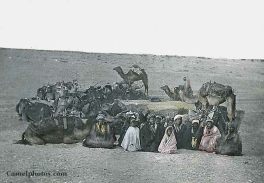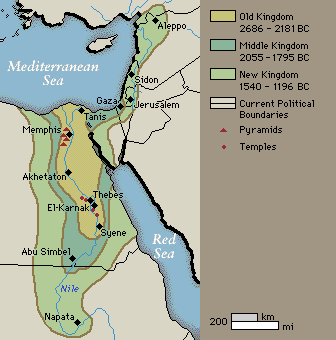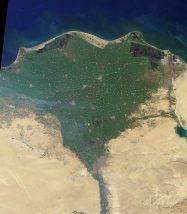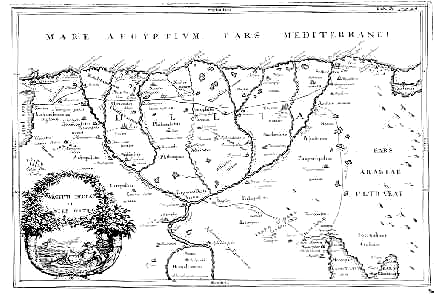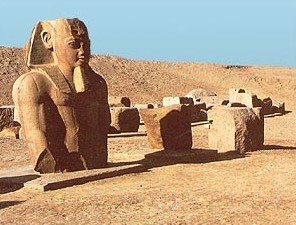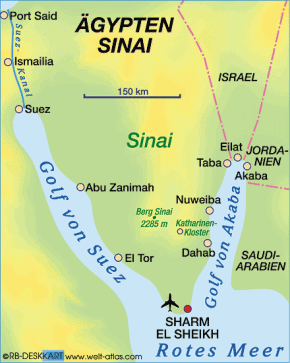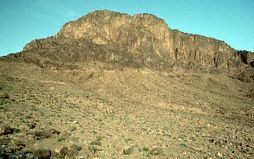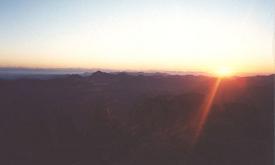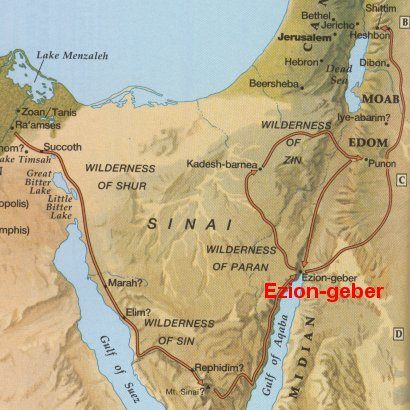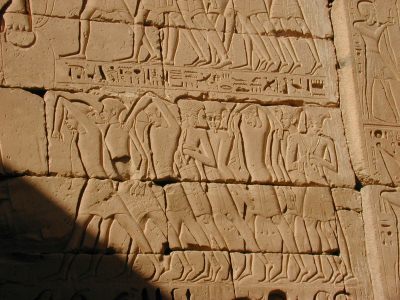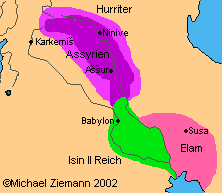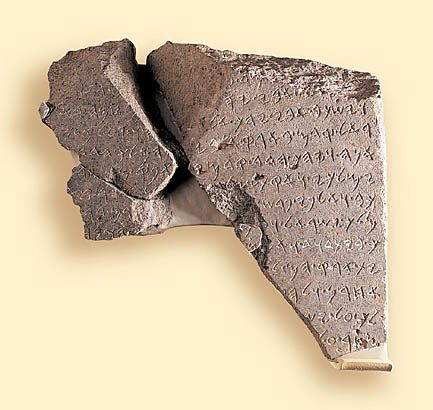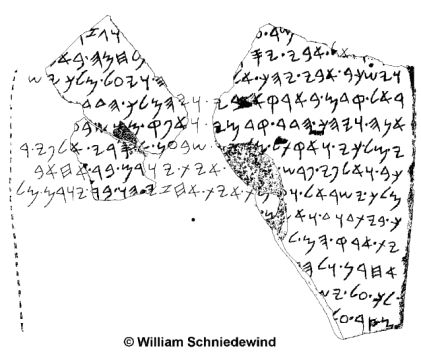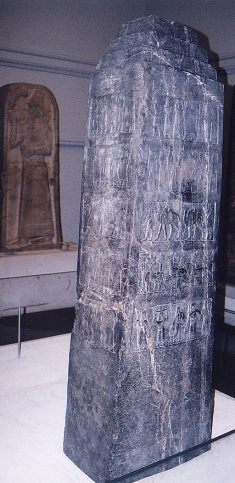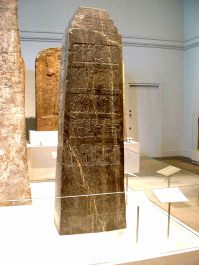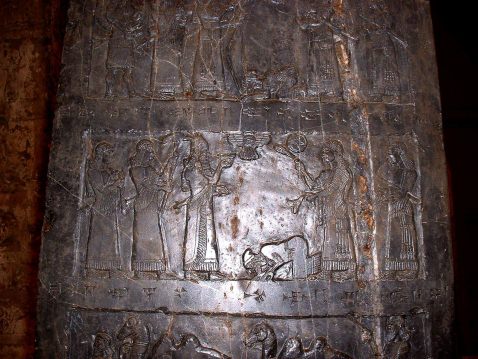Biblical and
archaeological information indicate this mix of cults for gods
("syncretism"). But OT is propagating a "1 god cult" and is
claiming [in a religious racist manner] that all other
religious orientations would be "atrocities" [without
describing the cults precisely]. So, all cults for Baal, for
Astarte, for the angelic hosts and for the gods of the
neighbor countries are demonized [without giving information
to the reader about what the fact is basically].
It's said that the cults also were performed in the temple of
Jerusalem (p.262), but there is not one single remnant of the
"First Temple" (p.261).
[It's possible that the first temple was only a big tent].
[Climate
fluctuations with colder winters or summers are not mentioned
by Finkelstein / Silberman].
The oval layout of the
mountain top villages
First are constructed the villages on border to the desert
where both kinds of living with herds and agriculture are
possible. Only later the villages are constructed more in the
West where it's less favorable for herds and for agriculture,
but it's more favorable for olive cultures and for vineyards
(p.120).
Political position of the
mountain villages
-- the position of the villages is absolutely offside of the
big trade routes, there is no foreign trade, and good
craftsman do not exist either (p.126)
-- the villages have no walls, perhaps because it was not
necessary, or because there were no means and no wisdom for it
(p.125)
-- there is no indication of any attack by fire or destruction
by violence (p.126)
-- the villages have no public buildings, have no documents,
have no seals, and have no imported ceramics, and have hardly
jewelry
-- all houses have more or less the same size, one house has a
surface of appr. 56 m2, and by this
it can be admitted that also the possessions were distributed
more or less in the same quantities
-- all houses are made of rough field stones, rough stone
columns are roof supports or are columns for the second floor
(p.124)
-- between the the houses there are stony pits which serve as
corn deposit (p.124).
Equipment
-- in every house there are many grindstones and many sickle
blades for corn economy
-- courtyards with fences are indications for keeping of
animals where the animals were kept in the night
-- jugs and pots were of ceramics
-- there could be found findings from tombs, but hardly
findings from cults, only in one single village in the
northern highlands was found a figurine of a bull of bronze,
an indication of a Canaanite cult (p.124)
-- [and there were found no skeletons?]
-- on Ebal Mountain
there is a strange stony structure interpreted as an old
Israeli altar, but the function of this installation around
this stony structure is controversial (p.125)
-- nowhere could be found any weapon (p.126).
Economy
There was agriculture and pasture agriculture with plow of
oxes and with sheep and goat herds (p.126).
Village development
-- the houses and farms are amplified during the decades and
centuries
-- only in rare cases the original building has been
preserved. It was mostly torn down and there was constructed a
second building on the first one
-- in the village Izbet-Sartah there was preserved the old
oval village center, and the new houses were constructed
around the center (p.127).
Archeology
states that there is an ornamentation wave coming from the
Aegean, so a new "Philistine ceramic" is formed. This wave of
stylistic cultural influence of Philistine ceramic is reaching
the foothills - according to the archaeological findings. This
ceramic can always be stated in a certain layer, from the
North down to Jezreel plain (p.151).
The emotion
against the Hyksos and their expulsion in about 1570 B.C.
probably provokes the construction of the chain of manned
fortresses along the eastern frontier of the Nile Delta
between Egypt and Canaan. This chain of fortresses is detected
by archeology, and probably was constructed supervising
immigration respectively reducing or blocking it (p.72).
According to archaeological excavations in the 1970s under the
leadership of archeologist Eliezer Oren from Ben Gurion
University (Tel Aviv) the fortresses erected in the following
time are places in distances of daily marches and include corn
deposits and wells resp. water deposits. It's a real system of
fortresses (p.74).
In outdated Bible the Egypt fortresses are mentioned as
"migdol". The Jews under Moses are said having installed their
camp between the migdol and the sea (2d book of Mose (Exodus),
14,2) (p.73).
In 13th century B.C. the Egyptians even built some fortresses
even in Canaan, and Egypt is the dominating power in Canaan
with administration points. Egypt armies occupy the region up
to Euphrates in Syria. The well fortified road between Egypt
and Canaan becomes one of the strategically most important
roads of Egypt (p.73). The road from Egypt to Gaza (250 km) is
also called the "way of Horus" (p.73).
[Horus is a main god of Egyptian mythology].
Egypt ruler Thutmosis III reports having passed these 250 km
with his troops in 10 days (p.74).
[Addition
Considering that also First Book of Moses is invoking a
frontier line with Euphrates river (in 1st Moses, chapter 15,
phrase 18), frontier of Euphrates river in Middle and Mid East
seems to have be a magic strategic significance like Rhine
river in Europe or Mississippi river in "America"].
The documents speak: There
was a new town Pi-Ramesse under ruler Ramesses II after the
Hyksos were driven out
9
The legend of the God's rule of Sinai - the faked 40
years migration in the desert
600,000
persons are said having migrated for 2 years and having
camped for 38 years without leaving traces?
Old Testament invents now a drama with invented 600,000
persons allegedly migrating in the desert.
OT claims:
Moses is said having made an alliance with JHWH on the base
of stone tablets:
-- Moses is said having received a codex of laws on Mount
Sinai making an alliance with God JHWH on the base of stone
tablets (p.20) which are allegedly preserved in the Ark of
the Covenant (p.64)
-- Jewish ambassadors are said having examined the
possibilities for an occupation and are said having reported
that the Canaanites are predominant and claimed for a return
to Egypt where it would be possible to survive at least
(p.64-65)
-- now God is said having punished the Jews in the Sinai
because of their anxiety, and the Jews have to migrate 40
years in the desert, so the generation of anxiety will die
and a new generation will not remember again to the good
times in Egypt (p.64-65).
[Addition: In 7th century B.C. the average of life
expectancy was 40 years. This indication can be taken really
earnest].
And now let's analize the alleged migration of 40 years with
2 years of migration and with 38 years in a camp:
OT claims:
-- the Israelites - according to the Bible 600,000 persons -
are said having crossed the desert and the mountains of
Sinai, 40 years they had camped at different spots, and by
this one generation had died (Numeri 33) (p.75)
-- 38 years the Israelites are said having camped at Kadesh
Barnea (Qadesh Barne'a) (Numeri 34) (p.76-77) which is
identified by archeology as En el-Quderat with a little
spring with fresh water aside, En Qadis, with the word of
Kadesh (p.77)
-- the migration in the desert is said having passed from
Kadesh Barnea passing Araba, then passing the countries of
Edom and Moab on the East Bank of the Dead Sea (p.65).
Archeology is speaking in Kadesh Barnea (today En
el-Quderat): no findings
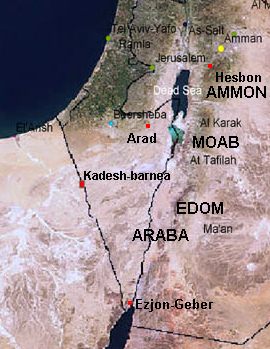 Map with Kadesh Barnea, Arad, Araba, Edom,
Moab and Ammon, satellite photo. Half of the
Dead Sea has disappeared in 2003 already.
Map with Kadesh Barnea, Arad, Araba, Edom,
Moab and Ammon, satellite photo. Half of the
Dead Sea has disappeared in 2003 already.
|
|
600,000 persons,
that is a complete metropolis like Essen (2006:
584.295), Rotterdam (2005: 589.156), Washington DC
(2004: 553.523), Frankfurt (2006: 660.289) or
Montenegro Republic (2004: 621.000).
In 40 years - 38 years in a camp and 2 years
migrating - a complete generation of 600,000 Jews
are said having died and reborn, so, there should
be found potsherds, tools, graves or bones.
Archaeologists found remnants of shepherds from 3d
millennium B.C. and remnants from Greek period and
Byzantine period. But from the 40 years of the
alleged stay of a huge Jewish group with 600,000
Jews in the time of 13th century B.C. in the Sinai
desert NOTHING can be found (p.75-76), nothing at
the alleged camp sites either (p.76), no camp
site, no hill of ruins, not one single potsherd,
not one single house, not one single skeleton etc.
(p.75).
|
Archeology speaks about oasis Kadesh Barnea (today En
el-Quderat): This was a fortress in the 7th century
-- in the middle of the oasis there is a little hill of
ruins (Tell) with remnants of a fortress of the European
Iron Age II (7th century B.C.)
-- but there are no remnants for European Late Bronze Age in
13th century B.C., not one single potsherd (p.77)
-- but in Kadesh Barnea was built a big fortress in 7th
century B.C., whereas archaeological research is not sure if
it was a fortress of the beginning of 7th century B.C. for
Assyria or at the end of 7th century as an outpost of
kingdom of Judah
-- in any case Kadesh Barnea is known in 7th century B.C.
all over in the region of the Middle East as a desert
outpost (p.81), and this is one more time an evidence that
the book of Moses was written in 7th century B.C. taking
reference to political structures of that time (p.77).
The allegedly bad states of Edom and Ammon: They are said
having blocked passing the Jews
 Map with Kadesh Barnea, Arad, Araba, Edom,
Moab
Map with Kadesh Barnea, Arad, Araba, Edom,
Moab
and Ammon, satellite photo. Half of the Dead Sea
has disappeared in 2003 already.
|
|
OT claims:
-- the fully developed states
of Edom and Ammon are said having planned to block
the passage for the Jews on the East Bank entering
Canaan from the other side (p.78)
-- Moses in Kadesh Barnea is said having sent
ambassadors to the king of Edom with the order
handling out a passage right to Canaan
-- king of Edom is said having rejected this claim
and the 600,000 Jews under Moses are said having
been forced to make a big detour around kingdom of
Edom (p.81).
|
Archeology speaks: Edom and Ammon were no states in these
times
-- according to archaeological findings the Est Bank during
the European Late Bronze Time in 13th century B.C. had only
a little population, and only a little part of the
population was resident
-- statal structures or kings of Edom and Ammon, who had the
capacity blocking the pass of the Jews, did NOT exist in the
alleged time of Moses in 13th century B.C. (p.78)
-- in these times Edom has only a little population and is a
border region of shepherd nomads
-- and only as an Assyrian protectorate Edom develops the
statal structures being a state in 7th century B.C. (p.81).
[Conclusion:
Edom had no army because there was no statal administration
yet which would be necessary installing an army. The faked
Moses cannot have been blocked by Edom in these times].
The alleged camp Ezion Geber
|
Map with
Ezion Geber and the faked way of Moses'
migration
|
|
--
Ezion Geber at the northern tip of Gulf of Aqaba is
later an important port town
-- the hill of ruins ("Tell") shows remnants of the
Iron Age II (7th century B.C.), but from Late Bronze
Age of 13th century B.C. nothing can be found (p.77)
-- since 7th century B.C. Ezion Geber is in a full
development (p.81), and this is another evidence
that the book of Moses was written in 7th century
according to the political conditions of that time
(p.77).
So, there are no remnants for both camps of faked
Moses during his alleged exodus in 13th century in
respect of the alleged 600,000 persons of the
migration under Moses [and there are no remnants of
other persons either] (p.77).
|
The invention of an aggressive Canaanite king of Arad
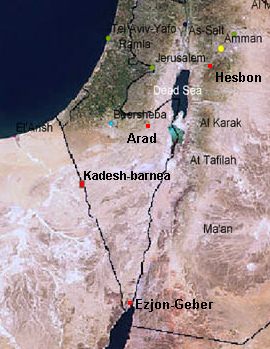
Map with Kadesh Barnea, Arad, Ezion Geber,
and Hesbon
|
|
OT claims:
Canaanite king of Arad is said
having attacked the Israelis and kept some of them
as prisoners of war. Then is said that the Jews
had claimed to the sky for help pleading that all
Canaanite towns will be destroyed (Numeri 21,1-3)
(p.77).
Archeology
speaks: There was NO king of Arad in these times
-- there were intensive excavations with the hill
of ruins of Arad (Tel Arad) eastward of Beersheba.
20 years the archeolgists were digging and
searching. Remnants of a big town of the European
Early Bronze Age could be found, a surface of 10
hectares, as big as a fortress during the European
Iron Age (p.77)
-- but from Late Bronze Age in 13th century B.C.
there is NOTHING, is seems Arad was left during
this time
-- these times of a populated period and an
uninhabited period can be stated for the whole bay
of Beersheba (p.77).
So, during Late Bronze Age in 13th century B.C.
Arad seems having been left by some reason, and
there was NO king for sure (p.77).
|
[Conclusion
During his migration faked Moses cannot have been blocked by
any king of Arad because there was nobody in Arad at this
time].
Migration around the Dead Sea up to the border of the West
Bank??
The allegedly bad Ammonite king in Hesbon (capital of
Sihon) is said having blocked passing the Jews
 Position of Hesbon, satellite photo
Position of Hesbon, satellite photo |
|
OT claims:
-- the mass of the 600,000 Israelites is said having
migrated around the Dead Sea
-- Ammonite king of Sihon in his capital of Hesbon
in the North of Dead Sea is said having blocked the
Jews on their way to Canaan
-- the Jews are said having fought the army of the
Ammonite king (p.77), like this it is described in
Num. 21,21-25, Deuteronomy 2,24-35, book of Judges
II, 19-21 (p.78).
Archeology speaks:
Ammon was no state in Moses' times
During 13th century B.C. there was no statal
structure and there was no Ammonite king who had
been capable blocking the pass of the Jews in
these times (p.78).
Archeology
speaks: Hesbon did not exist in Moses' times
The hill of ruins
("tell") from Hesbon indicates no findings for
Late Bronze Times in 13th century B.C. There was
not even a village. Hesbon was without population
in these times (p.78).
|
[Conclusion
Faked Moses cannot have been blocked by a State of Ammon with
a king in Hesbon when this State of Ammon and this town of
Hesbon did not exist in these times].
10 The alleged
occupation - the legend of Moses' death: Moses
describing his own death...
Moses is said having proclaimed the laws
OT claims:
-- only in the Eastbank in the plain of Moab Moses is said
having proclaimed the precise text of the laws which have to
be followed when Canaan should be occupied well (p.65)
-- 5th Moses book (Deuteronomy) indicates that Moses is said
having written on Mount Nebo the 5 Moses books with it's own
hand shortly before his death (p.22).
The alleged warning of Moses that all laws have to be
fulfilled precisely
OT claims:
God is said having stood before the Jews when they were at
the frontier entering Canaan, and God is said having ordered
an ethnic cleansing in Canaan destroying all traces of
idolatry destroying all Canaanites (p.87).
Before his death Moses is said having stressed who important
would be to fulfill all laws of god for a successful
occupation of the promised land (p.87) respectively the new
"Book of Law" claims that the new "laws" should be fulfilled
in all their details so the sins of generations before will
be overcome and the whole land will be Jewish (p.110).
Moses is said having stated that the Jews will perform the
occupation of the land and will keep the occupation
-- when the law of the alliance will be followed strictly
-- when there will not be marriages with the neighbors [this
law goes against any anti racism law]
-- when every involvement into heathen style of life of
Canaan will be omitted (p.112).
[There is a big
contradiction with this law
It's not comprehensible why God will "promise" land to a
group of humans which has to be occupied first by wars and
religious mass murder. Add to this this region is a transit
country for the big Empires and will be occupied again and
again by new powers. In any other region will be more peace
than there].
The alleged appointment of the new war leader Joshua
OT claims:
Before his death Moses is said having appointed Joshua - his
adjutant for many years - as the war leader for the alleged
occupation of the land (p.87). Joshua is the sun of Nun.
Joshua is said having been the new war leader for the
occupation and ethnic cleansing action (p.65).
The alleged death of Moses
|
|
OT claims:
-- Moses shall die as the last member of the group
which had the experience in Egypt (p.87)
-- Moses himself is said having died on Mount Nebo
(p.65).
Moses is said having prescribed his own death. This
is really not possible...
|
Map with Mount
Nebo with the towns Dibon and Jericho. In the
period of Moses Jericho has no population.
|
|
Conclusion:
Heroism of Moses exodus is a fake in combination with the
political situation of 720 B .C. appr.
All proofs and evidence indicate that the exodus of Moses was
written in the second half of 7th century B.C. and in the
first half of 6th century B.C., because many places refer to
the political landscape of the 7th century B.C. (p.82). But
during the alleged exodus these places had no population and
played no political role (p.78).
So, the exodus from Egypt is a composition of different
periods of times (p.78):
-- not one single Egypt ruler of the time of the claimed
exodus is mentioned with it's name in OT, but later the rulers
are always mentioned with their names
-- the only real reason for a migration in the desert
migrating on Sinai peninsula would be the fright of the of the
coastal road by the Israeli masses of 600,000 migrants, but
the Egypt fortress system is never mentioned in the Moses
books, and at the same time the supervision of the coastal
road is very strong during 7th century B.C. as it was during
the alleged exodus from Egypt (p.79).
[The evidence of the Egypt chain of fortresses is missing
in the Bible
The fact that the Egypt fortress system on the coastal
road is missing, this is a main evidence that the whole exodus
of Moses is an invention. Or the fortresses had been empty for
40 years during the exodus, but archeology would have made out
this jump in the cultural development comparing articles of
daily use, and empty fortresses would not make any sense].
[Calumniation of kingdom of
Moab and kingdom of Ammon also is wrong - the war since 1948
The invention of kingdoms having blocked the masses of
population under Moses also is wrong because these kingdoms
Moab and Ammon did not exist in these times according to the
archaeological excavations. So, Old Testament is a systematic
calumniation having a propagandistic war reason for a later
time. It can even be admitted that the wars between racist
Zionist Israel and its neighbors since 1948 always get new
mental stipulation by these calumniations].
Donald Redford: Exodus under leadership of Moses is a
legend in combination with the geographical conditions of
7th century B.C.
Archaeologist and egyptologist Donald Redford comes to the
conclusion that all geographic conditions of the exodus are
implanted from 7th century B.C. So, all events with the faked
exodus can be explained (p.79):
-- the location of Pithom in the eastern part of Nile Delta
was constructed as a town at the end of the 7th century B.C.
and before hardly is any population there
-- the designation of Migdol is a general denomination for
fortresses in the New Reich, but as a geographic name in the
eastern Nile Delta Migdol is only important in the 7th century
B.C., mentioned in Jeremiah 44,1 and 46,14
-- Gosen as a location for Jews coming from Canaan arriving in
Egypt (Genesis 45,10) is not an Egypt name, but is a Semite
name of Arab Kedarite kings, and only since 6th century B.C.
Arab population is coming to the delta taking over the power
there in 5th century B.C. (p.80).
A short summary is like this:
Jewish immigration to Egypt and also the exodus under the
leadership of Moses seem to be a free composition of histories
and legends. But casually all mentioned places and states
correspond with the map of 7th century B.C. (p.82).
Finkelstein / Silberman are joining this thesis because "Torah
and history presented in Deuteronomy in fact has got
characteristics having been written in the 7th century B.C."
(p.34)
[Conclusion:
Identity of Israelites (Jews) is formed in the mountain
villages of Canaan and in the desert of Jordan of today, and
in Egypt the Jews hardly had something to do.
Slavery in Egypt is a lie and can be dropped. The construction
of a town Ramses with slavery is a lie and can be dropped. And
also heroism of a child of Moses found in a little basket in
Nile river, and the great migration 40 years in the desert
under leadership of Moses are a lie and can be dropped, and
also the laws of Moses are a lie and can be dropped. All this
is an invention of Orthodox priests who abused their
competence being able to read and to write - to the contrary
the masses of the populations in these times were illiterates
yet. And by this all reasons of hatred against Egypt fall away
for all Jews - oh, this is bad for war mongers racist
Zionists. There is no propaganda against Egypt any more!!!].
11 The faked
occupation under a Joshua appr. 1230-1220 B.C.: the real
culprits were other ones
Was there a conquest of
land with a mass of hungry Jewish men, women and children?
After the alleged prophecy is said that there was a conquest
of land resp. an occupation (p.20).
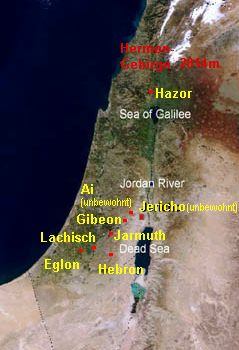 Map with Jericho, Ai, Hazor, Gibeon and
Lachish, satellite photo
Map with Jericho, Ai, Hazor, Gibeon and
Lachish, satellite photo |
|
OT claims:
-- there was a
mass of Jewish men, women and children - and they
were handicapped in their health and did not have
much with them - and this mass are said having
performed an invasion against the big fortresses
of Canaan and are said having won (p.86) and they
are said having needed appr. 10 years for this,
according to the Bible this is said having
happened from 1230 to 1220 B.C. (p.89)
-- the book of Joshua claims when the rule would
be observed well, so there will fail no victory
(p.110)
-- claimed occupied cities are Jericho, Ai,
Gibeon, Lachish and Hazor (p.86).
The composed myths and stories about an Israelite
past are compiled to one single military campaign
under Joshua (p.106), and the whole invasion with
mass murder is said having happened with the
blessing of God (p.107).
|
The alleged fall of Jericho
OT claims:
-- Joshua is said having performed one successful siege
after the other
-- first it is said that Joshua had taken the bridge head of
Jericho: When the mass was crossing Jordan river, two spies
are said having been sent to Jericho evaluating the
situation and returning that a whore Rahab had informed them
that whole Jericho would be very afraid of the future Jewish
invasion (p.87)
-- it is said that crossing the Jordan river was no problem,
and the Ark of the Covenant is said having borne in advance of the mass
of the people
-- it is said that after 7 days of siege the Israelite war
trombones had provoked a fall of the strong walls of Jericho
(Jos. 6) (p.87).
The alleged fall of Ai bei Bethel
OT claims:
-- as a next town Ai bei Bethel is said having been sieged
(p.87-88) with a double tactic: Joshua is said having
installed a big military camp in the East and a little one
in the West, so the men of Ai had stormed against the big
camp, and they are said having pursued the Jews up to the
desert
-- then the little part of the Jewish army is said having
occupied the town of Ai from the West without any fight
putting fire on the whole town
-- then Joshua is said having slaughtered all inhabitants of
Ai, having collected all cattle and prey, and Joshua is said
having hanged the king of Ai on a tree (Jos. 8,1-29) (p.88).
The alleged panic in Canaan
OT claims:
There is said that after this panic broke out in whole
Canaan (p.88).
The alleged claim of the Gibeonites that they would not
be natives and by this should not be defeated
The Gibeonites allegedly claim for mercy and are enslaved by
the Jews.
OT claims:
-- Gibeonites in panic living in four towns in the North of
Jerusalem (p.88) (Gibeon, Kephira, Beeroth, Kiriat-Jearim)
(p.97) are said having pleaded for mercy claiming that they
would be foreigners and not natives, and by this the order
of extermination would not be valid for them, and Joshua is
said having agreed to this (p.88)
-- but then there is said that it was stated that the
Gibeonites were natives and Joshua is said having enslaved
the Gibeonites for ever to "woodcutters and scoops" (Jos.
9,27) (p.88).
The alleged counter coalition against the alleged Jewish
invasion

Map with Jericho, Ai, Gibeon, Jarmuth,
Lachish, Eglon, Hazor and the Hermon
mountains (2814m)
|
|
OT
claims:
-- there had been a counter coalition under the king
of Jerusalem, Adoni-Zedek,
with the king of Hebron and with the kings in the
Western highlands (Jarmuth,
Lachish and Egon)
-- the Canaanites are said having unified their
armies at the central place of Gibeon
-- the Canaanite army is said having fled in panic
to the steep mountain crest of Beth Horon in the
West, and God is said having rained big "hail
stones" on the Canaanite armies, so by the hail
stones were more deaths to deplore than by the
fights (Jos. 10,11)
-- Joshua is said having pleaded to God before
sunset keeping the sun without movement winning time
for the killing of all enemies (p.88)
-- then it's said that in fact the sun made no
movement during a complete day, and by this God had
helped Israel (Jos. 10, 13-14)
-- the fled kings are said having been seized and
executed (p.89).
|
The alleged big stone at the entrance of the cave of
Makkeda
OT claims:
-- five Canaanite kings (king of Jerusalem, of Hebron, of
Jarmuth / Jarmut, of Lachish and of Eglon) are said having
fled of Joshua's troops to a cave near Makkeda
-- Joshua is said having received the report that the five
kings had hidden themselves in the cave
-- then Joshua is said having put big stones closing the
entrance of the cave locking the cave until all enemies of
the region were killed
-- after the population had been allegedly killed, Joshua is
said having ordered to hang all five kings on five trees
-- in the evening Joshua is said having ordered to bring
down the dead bodies of the kings throwing them into the
cave, and then the cave is said having locked with stones
again "up to the present day" (Joshua 10, 16-27) (p.106).
[The place where should be the cave of Makkeda cannot be
found. In Ethiopian language the word Makkeda is the word
for "queen"].
The alleged further
destruction in the South of Israel Palestine
OT claims:
Under Joshua the Jewish warriors are said having destroyed all
towns of southern Canaan and occupied the southern region
(p.89).
The alleged final battle in
the North of Israel Palestine against the northern coalition
under the command of Jabin of Hazor
OT claims:
-- in the North a coalition of Canaanites kings under the
supreme command of Jabin of Hazor is said having built a big
army against the alleged Jewish murder invasion against any
international law (Jos. 11,4)
-- the armies of the Canaanites under Jabin are said having
been confronted with the Israeli army in Galilee on an open
field
-- Joshua's warriors are said having completely destroyed the
north Canaanite troops
-- then Joshua is said having occupied Hazor and put fire on
the whole city, the most important city of Canaan, according
to the OT "the main town of all kingdoms" (Jos. 11,10) (p.89).
In this way Israel Palestine is said having been occupied by
the Israelites from the desert in the South to the snowy
mountains of Hermon mountains in the North, and God had given
this land to the Jews. Then the land is said having been split
to the Israeli tribes (p.89).
Documents and
archeology are speaking that occupation under Joshua is
a fake
Book Joshua is a collection of myths
-- German Bible searchers of 19th century are defining the
book of Joshua as a collection of myths, heroic stories and
local ideas
-- above all Albrecht Alt and Martin Noth mean that the book
Joshua would be a product of aetiological [searching the
origin] tradition with myths about processes of growth [and
destruction] (p.106).
The faked warlord Joshua is
presented like a king
-- the alleged takeover of power for example is described
like an enthronement (Joshua 1, 1-9) (p.110-111)
-- the faked warlord Joshua is said having given a
profession of loyalty (Joshua 1,16-18) that reminds to the
oath of obedience to a king
-- the faked warlord Joshua is said having led a ceremony to
revive the alliance with God (Joshua 8,30-35) as all kings
of Judah have done
-- God is said having ordered to faked Joshua studying day
and night (Joshua 1,8-9) how also king Josia is said having
done (2d book of Kings 23,25) (p.111).
The order of the towns in
the book of Joshua corresponds with the order of the 7th
century B.C.
It seems very strange, but the strategic military aims in
the fake Joshua book correspond with the strategic military
aims of later war of king Josia (p.111):
-- the list with the towns on the territory of the tribe
Judah (book of Joshua 15, 21-62) corresponds exactly to the
development as it was under king Josia. Finkelstein /
Silberman say:
"This list corresponds exactly with the border lines of of
the kingdom of Judah under Joshia's rule." (p.108)
-- and the names of the locations are corresponding almost
exactly with the layout of the settlements of the 7th
century B.C.
-- some of the mentioned places "were only populated in the
last decades of the 7th century B.C." (p.108)
-- so, also the campaign project corresponds with the
situation of the 7th century B.C. (p.108).
-- and also the prescription of northern territories
corresponds to ex North Reich Israel under Assyrian
occupation and the latter Assyrian province [Samaria]
(p.109), since the Assyrian occupation named as "Samerina"
(p.241).
The documents speak: Canaan
in 13th century B.C. was an absolute Egypt province - and
any Jewish invasion is not possible
-- according to letters of Egypt Pharaohs found in Tell
el-Amarna, Canaan is an Egypt province during the faked
Jewish invasion
-- there was a strict Egypt administration, the capital of
Canaan province was Gaza
-- Egypt garrisons were distributed in all the country at
the strategic hot spots, for example in Beth-Shean in the South
of Lake Gennesaret, or in Joppa (today's Jaffa, a part of
southern Tel Aviv at the coast)
-- in the OT the Egypt dominance over Canaan during the
faked Jewish occupation is concealed
-- the Canaanite rulers themselves hardly had to say
anything corresponding to the Egypt documents (p.90)
-- it can be admitted that Pharaoh Ramesses II did never
relax his control over Canaan because his military forces
were one of the strongest of Egypt history and his goal in
foreign affairs was very high
-- upheavals were answered with Egypt troops immediately,
and they could come fast by the well prepared road along the
Mediterranean Sea between Egypt and Canaan (p.91).
The impossibilities of a Jewish invasion in Canaan in
13th and 12th century B.C.
-- it's proved that there was never any exodus under Moses,
so there is the question, how had been a conquest (p.86)
-- Egypt is said having been passive during the Jewish
invasion which also seems impossible (p.92)
-- Egypt documents never mention any Jewish invasion
nowhere, but such an invasion surely had been mentioned [in
such an important territory like Canaan] when it had been
executed (p.92)
-- the only source mentioning the name of "Israel" in the
13th century is a stele of Pharaoh Meenptha (1235-1224 B.C.)
where is indicated a victory against the Israelites (p.92).
Archeology speaks: There were no city walls nowhere in
Canaan in 13th century
-- the Canaanite towns of these relevant times had fortified
administration seats of the leading ruling class with the
ruling family and their administrators, with palace, temple
complex, and with some public buildings
-- the Canaanite towns themselves had no city walls
-- the farmers were dispersed in little villages
-- all sieges and city walls in Old Testament are a fake, so
(p.90).
There can be presumed the reasons for the missing of city
walls in Canaan of these times in 13th century B.C.:
-- perhaps because of the military dominance of Egypt, so it
was considered that a construction of city walls would not
be necessary (p.90-91)
-- perhaps because of high taxes for Egypt, so the local
rulers had no means for the construction of city walls any
more
-- or perhaps Egypt forbade the construction of city walls
controlling more the population (p.91).
According to archaeological findings there was a high
Egyptian influence and control in Canaan for a long time
after the faked Jewish conquest until came the time of
Ramesses VI at the end of the 12th century B.C. (p.92).
Findings of statues and
hieroglyphs at Beth-Shean [Greek: Scythopolis]
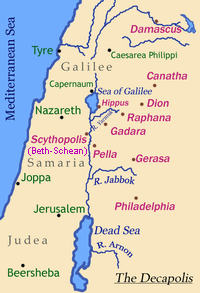
Map of Decapolis in the Middle East with
Scythopolis / Beth Shean
|
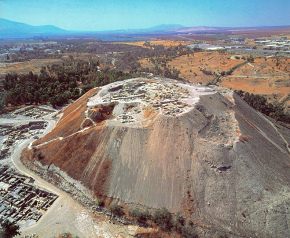
 Beth-Shean
/ Scythopolis: a part of the high hill of ruins
(tell) Beth-Shean
/ Scythopolis: a part of the high hill of ruins
(tell)
|
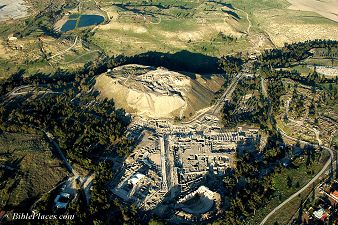
 Beth-Shean / Scythopolis: there is a high and a
lower hill of ruins (tell), see:
www.bibleplaces.com.
Beth-Shean / Scythopolis: there is a high and a
lower hill of ruins (tell), see:
www.bibleplaces.com.
|
"Christian" religious schools, priests, pastors and layman
preacher mostly mean that such town hills should not be
taken earnest. They are going on claiming that the letters
in the Bible are right...
In the 1920s there was excavated an Egypt fortress in Beth
Shean [also: Beth Shan, Greek: Scythopolis] (p.91). The
findings were statues with texts in hieroglyphs from the
time of the Pharaohs
-- Sethos I (1294-1279 B.C.)
-- Ramses II (1279-1213 B.C.)
-- Ramses III (1184-1153 B.C.) (p.92).
[Conclusion:
These findings are absolute proofs for a strong Egypt
dominance in the region in this time, and in other hills of
ruins more such fortresses can be found].
Excavations in Jericho
(hill of ruins Tell es-Sultan) say: there was no
population in 13th century B.C.
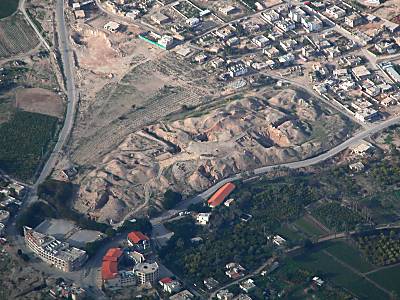
The hill of ruins (tell) of Jericho, see:
www.bibleplaces.com
The excavations at the hill of ruins (tell) of Jericho (also
called: Tell es-Sultan, er-Riha, Eriha, Yeriho) give the
following information:
-- for the 14th century B.C. there can be proved only a
little village without any fortification
-- for the 13th century there is no trace of any population
at all, the spot was without population
-- and traces of destruction are missing also (p.96).
So, according to Finkelstein / Silberman, the trombones
which allegedly have destroyed the city walls of Jericho,
are a big lie (p.96).
[No city walls and no population were there: That is a
double lie].
Archeology says about Ai
(hill of ruins called Chirbet et-Tell): there was no
population in 13th century B.C.
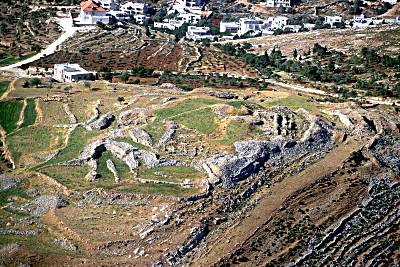
The hill of ruins (tell) of Ai, Chirbet et-Tell, see:
www.bibleplaces.com
-- the excavations of Jewish woman archaeologist Judith
Marquet-Krause 1933-1935 showed ruins of a huge town from
Early Bronze Age in appr. 2300 B.C.
-- from Late Bronze Age during the alleged Jewish invasion
was not found anything, the location was without population
-- and new excavations in the 1960s have not brought
anything new (p.96).
According to archaeological excavations Jericho and Ai had
no population during the conquest of the Jews in Canaan
(p.96).
Bible-believing archaeologist Albright means that the
alleged events of Ai had happened in Bethel near Ai (p.97).
Excavations at the four Gibeonite towns which allegedly
pleaded for protection: Gibeon, Kephira, Beeroth,
Kiriat-Jearim: there was no population
-- the scholars can find an agreement that the excavation in
the village ed-Dshib in the North of Jerusalem would be the
hill of Gibeon
-- then remnants of Middle Bronze Age and of Iron Age are
found, but nothing is found of Late Bronze Age. So Gibeon in
these times also had no population
-- in the other three towns populated allegedly by the
Gibeonites during the Late Bronze Age (Kephira, Beeroth and
Kiriat-Jearim) there cannot be found anything either of Late
Bronze Age (p.97).
The stone of the cave of Makkeda: that's nothing more
than a rumor
One rumor indicates that in a cave of Makkeda had been
captivated 5 kings of the Old Ages with a stone (Joshua 10,
16-27).
It can be that a big stone before an entrance of a cave has
impressed the population all the time. And according to the
Bible researchers Albrecht Alt and Martin Noth it can be
that there are created new heroic stories and rumors about
such a stone (p.106).
[There is nothing more about this stone and it's cave,
neither a stone, and neither a cave].
More excavations: towns
without populations and fire storms
There are more excavations and more towns without population
are found, but also traces of fire storms are found. The
stated fire storms are dated in a range of time of 100
years. But there cannot have been an invasion of Joshua of
over 100 years, but here were other culprits doing their
work. So, Jewry has never committed any genocide under
Joshua, and this is principally only good news.
But there are stated many fire storms in Canaan with ash
layers with fallen walls and burnt wooden beams, but there
are no city walls (p.94). The ruins of the burnt cities are
building a "layer of destruction" with a thickness of 1 to 2
meters (p.105).
x
|
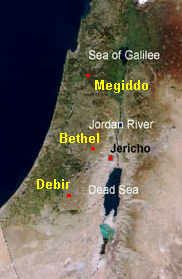
Map with Megiddo and Debir, satellite photo
|
Excavations
in Megiddo in Jezreel plain indicate that there was no
population
According the excavations Megiddo had a territory of 10
hectares (p.95). Remnants of Middle Bronze Age and of Iron Age
are found, but from Late Bronze Age is not found anything
(p.97).
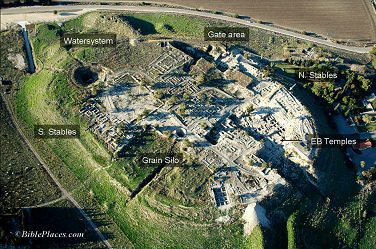

The hill of ruins
(tell) of Megiddo
Excavations in Debir (at the Tell Bet Mirsim) show a fire
storm
Between 1926 and 1932 the archaeologist and language
researcher William Foxwell Albreight is leading excavations at
the Tell Bet Mirsim south west of Hebron:
-- the Tell Bet Mirsim is identified as the town of Debir
-- in the OT there is mentioned a Jewish occupation three
times (Joshua 10, 38-39; 15, 15-19) and in the book of Judges
1,11-15
-- according to the excavations Debir was a little, poor town
without city wall
-- according to Albright a big fire storm destroyed the whole
town in 1230 B.C.
-- rough potsherds are identified by Albright as Israelite
-- and by this Albright means that the invasion of the Jews
had really happened (p.94).
Excavations at the Arab village Betin: Lus becomes Bethel:
and there was another fire storm
-- the location near Betin is identified as Bethel
-- archeology states that Betel was a Canaanite town with
population during the Late Bronze Age
-- at the end of the 13th century Bethel was destroyed by a
fire storm, and during the Iron Age I it was populated by
another population as it seems (p.94).
Archaeologist Albright means that the book of Judges 1,22-26
and the conquest would be fulfilled by this: The Canaanite
town Lus had been occupied by relatives of Joseph and the name
had been changes into Bethel (p.94).
But it's not necessary that Bethel has been destroyed by
Israelites (p.97).
around 1170 B.C.
Excavations in Lachish (hill of ruins Tell ed Duwer): and
there was a fire storm again
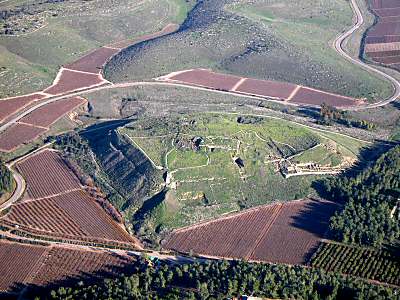
The hill of ruins (tell) of Lachish, see:
www.bibleplaces.com
In the
1930s British archaeologists are excavating a big town of
Late Bronze Age (p.94) with a layout of 10 hectares (p.95),
and again is found the trace of a fire storm. For the
archaeologists the Bible text of Joshua 10,31-32 is
fulfilled by this (p.94).
The impressive Canaanite town of Lachish was burnt down and
then given up (p.105). The date of the fire storm is proved
for around 1170 B.C. because there are peaces of metals in
the "layer of destruction" - probably from the main town
gate - with the inscription of Pharaoh Ramses III who had
it's governance from 1184 to 1153 B.C. (p.105).
But it's not necessary that Lachish has been destroyed by
Israelites (p.97).
Excavations in Hazor (hill of ruins Tell el-Waggas): and
once again there was a fire storm
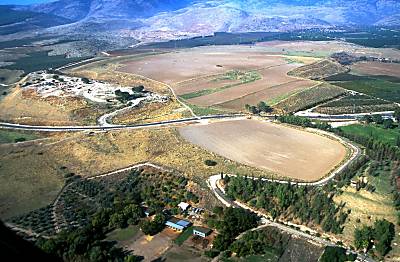
The hill of ruins (tell) of Hazor (Tell el-Waggas),
see: www.bibleplaces.com |
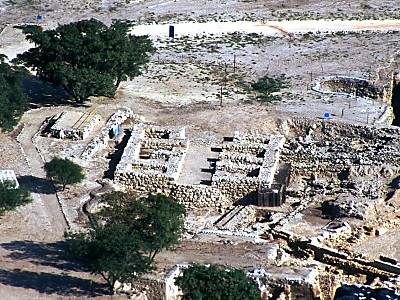
Hazor: a six chamber gate was found, but there is
the question who built it
|
In 1956 the Jewish archaeologist Yigael Yadin begins with
his excavation of Hazor (p.94). According to Joshua 11,20
"this was the capital of all these kingdoms" in Canaan
(p.94-95). Can be confirmed this?
Tell el-Waggas is a huge tell:
-- according to archaeological research Hazor was the
greatest town of Canaan in the Late Bronze Age, 80 hectares
was the layout (p.95)
-- according to the archeology the climax of the development
in Hazor was in the European Mid Bronze Age (2000-1550
B.C.), but the boom of the town lasted far into the Late
Bronze Age
-- there are many temples and huge palaces excavated
-- the palace is excavated in the 1990s under the leadership
of archaeologist Amnon Ben-Tor from Hebrew University
[Jerusalem] (p.95)
-- there are cuneiform findings indicating an archive, and
among others there is mentioned the king of Hazor: Ibni,
which is mentioned in the Mari archives as Ibni Addu
-- Finkelstein / Silberman presume that the name stays in
connection with the king of Hazor Yabin, eventually this was
a dynasty (p.95).
And then was a fire storm and the destruction:
-- in the 13th century B.C. the boom of the time finds a
sudden end, the town is destroyed and put on fire, the mud
bricks of the palace walls are burnt in red and are standing
today yet with a height of 1.8 meters (p.95)
-- the town is destroyed relatively soon, at about 1350
B.C., and this is provable with ceramic findings: The
ceramics found don't have yet the typical form of the late
13th century (p.105)
-- god's statues are beheaded and broken (p.104).
But it's not necessary that Hazor has been destroyed by
Israelites (p.97).
And then was a poor population:
After some time of being lost a poor village was found in
the center of this huge field of ruins which can be proved
with potsherds similar as in the early Israeli villages in
the highlands of the West Bank more to the South (p.95).
Other excavations in other towns of the alleged conquest:
Arad, Hesbon a.o.: more fire storms
Also
in the hills of ruins of Arad, of Hesbon etc. are
found remnants of the Mid Bronze Age and of the Iron
Age, but nothing can be found of the late Bronze Age
(p.97) resp. there are traces of fires, but there is
no obligation that Jews were the culprits who put
the fires (p.97).
Villages are not
destroyed
Another mystery is the fact that some spots are
totally destroyed, but others not, without any
destruction (p.107). The majority of the villages in
Canaan are not burnt. And the villages are not left
either (p.120).
|
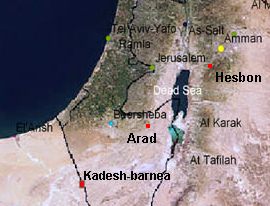 Map with Kadesh Barnea, Arad, and Hesbon,
satellite photo
Map with Kadesh Barnea, Arad, and Hesbon,
satellite photo
|
Clearance of the contradictions: The real culprits
were wild pirates ("maritime nations") exploiting the
peace
-- there were no city walls in Canaan (p.96)
-- and the peace between Egypt and the Hittites in combination
with a hyperextention of the borders gives way to the negative
ideas of pirates looting the towns (p.99-100).
In the beginning of the 13th century B.C. both Empires of the
region, Egypt and Hittites, have a great military battle with
a draw between the Egypt Pharaoh
Ramesses II and the Hittite king
Muwattalli on
Orontes river (western
Syria, today's Lebanon).
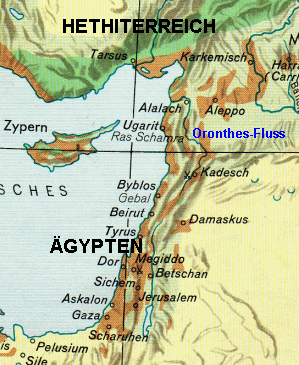

Map with the Empires
of Egypt and the Hittites with Orontes river as
borderline: Jerusalem did not exist in these times yet.
There is an agreement between the successor of Muwattalli, Hattuschili III and Ramesses II with a peace
treaty "for ever" (p.99), and Ramesses even is taking a
Hittite princess as his wife, as a symbol for the peace
treaty (p.100).
In the region of eastern Mediterranean until far into the
13th century B.C. there are governing Egypt in the South
(p.97) with the capital of No-Amon,
today Luxor
(p.101), and in the North are governing the Hittites with
the borderline in Syria (p.97) with their capital of Hattusha in the East of
the today's Ankara (p.101). It could be that the trade power
of Mycenae
(Peloponnese of Greece) has used the situation for attacks.
This Mycenae is managing the whole trade in the eastern
Mediterranean under the observation of the big powers,
altogether with the strategic island of Cyprus (p.100).
There is a dramatic change of the societies. The heavy
crises is devastating the kingdoms of the Bronze Age (p.97)
and there are new kingdoms coming up (p.98). The precise
cause for the collapse of the Reichs of the Later Bronze Age
is not known. The source of violence is not clear. [It was
surely not a Jewish invasion after 40 years of migration in
the desert].
Several hypothesis:
-- possible is a war about essential land strips and
farmer's villages
-- or harassed farmers and shepherds have attacked the big
towns (p.104)
-- or there were invasions from different sides
-- or the society collapsed
-- or there was a civil war (p.105).
There was mass pillage and setting fire in the whole
region of eastern Mediterranean Sea
-- scholars mean that the fires were put by violent maritime
nations in combination with an invasion on the land (p.101)
-- there had been huge maritime nations having made an
alliance with the Philistines, Sicels, Shekelesh, Denyens,
and with the Weshesh
-- according to drawings and paintings these maritime
nations are foreign ethnic groups, some have helmets with
horns, others have headdresses with feathers on their heads
(p.102)
-- there are also reports from Ugarit [a city state in
northern Syria on the Mediterranean coast] and also from
Egypt are reports from the early 12th century mentioning
such looters (p.101).
Other scholars mean
-- that there had been an easy alliance of pirates and
rootless souls
or
-- there had been a change of climate and foreigners from
the North had been driven away by this and had arrived in
the Mediterranean (p.103) provoking a forming of wild groups
of pirates and looters (p.104)
or
-- the whole society of eastern Mediterranean had suffered
an over specialization and a block of development and could
have collapsed by this (p.104) provoking the forming of wild
pirates and looters (p.104).
1185 B.C.
Finding of text: Ugarit is
in danger by hostile ships and pillage
The last king of the Ugarit, Hammurabi, reports to the the
king of Alashiya (today Cyprus) claiming hostile ships and
pillages. Hammurabi warns that Ugarit will not be able to
defend itself because his troops were in the land of the
Hittites and his boats in Lycia (p.102).
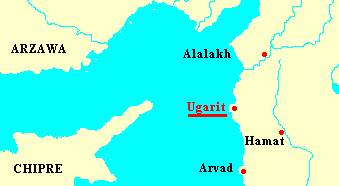
Map with Ugarit at the upper Mediterranean coast opposite to
Cyprus.
The king of Chatti reports to the prefect of Ugarit [city
state of today's Syria] that there are maritime nations as
"Shiqalaya [...] living on boats." (p.102)
1175 B.C.
The northern part of the
eastern Mediterranean is in ruins
Up to 1175 B.C. the maritime nations have destroyed the
complete north eastern Mediterranean region:
-- Chatti [Anatolia]
-- Alashiya (Cyprus)
-- Ugarit [city state in today's Syria on the Mediterranean
coast] (p.102).
[Conclusion: This wave of
destruction was abused for Jewish war heroes
Now also neighboring regions of Israel Palestine are in ruins.
It seems as if the writer of the OT wanted to use this wave of
destruction for an invented war hero].
Resistance of Canaan can inhibit the destruction
-- Canaan can inhibit it's destruction for almost 100 years -
in contrast to the Hittite
Empire
-- but then more and more violence also destroys the order in
Canaan
-- and also Canaanite town are victims of fire storms or come
down more and more (p.104).
There is another inscription:
Egypt is preparing the defense - and Egypt can defend the
invasion
According to monumental inscriptions of Ramses III in the
temple in Medinet Habu in Upper Egypt the Egyptians are
preparing their defense in this time against the conspired
maritime nations coming more and more to the south (p.102).
A group of seven Sea Peoples invaded Egypt in the days of
Ramses III. On his mortuary temple at Medinet Habu, the
pharaoh had depicted his successful land and sea battles
against these migrant peoples.
(http://www.bibleplaces.com/2003jan.htm)
| Inscriptions at the temple in Medinet
Habu, built under Ramses III |
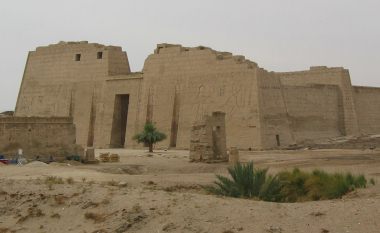
 The temple in
Medinet Habu, built under Ramses III The temple in
Medinet Habu, built under Ramses III
|
|

The temple complex in Medinet Habu, built under
Ramses III, air photo
|
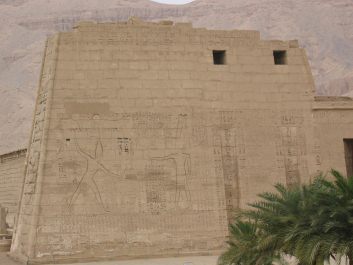
 Inscription in
the temple wall of the temple of Ramses III in
Medinet Habu, left side of the wall Inscription in
the temple wall of the temple of Ramses III in
Medinet Habu, left side of the wall
|

 Inscription in
the temple wall of the temple of Ramses III in
Medinet Habu, middle and right side of the wall Inscription in
the temple wall of the temple of Ramses III in
Medinet Habu, middle and right side of the wall
|
These illustrations of the fights show the strong ethnic
difference of the invaders and the Egyptians. Some have
helmets with horns, others have headdresses with feathers on
their heads (p.102)
The Philistines are known by their use of feather head
dresses, swan decorations, two edged swords, spears, and
rounded shields. The majority of the Sea Peoples are
clean-shaved, but a few Philistines are depicted with beards.
(http://www.bibleplaces.com/medinethabu.htm)
The army of Egypt under Ramses III can stop the invasion of
the conspired maritime nations on the Egypt border (p.102).
Destruction of the Philistine towns of Ashdod and Ekron
The Philistine towns - they are allies of the maritime nations
- show the catastrophe very well:
-- above all Ashdod is a wealthy center of Canaan in the 13th
century B.C. under the influence of Egypt with constructional
engineering in Egypt Canaanite mixed style in architecture and
pottery
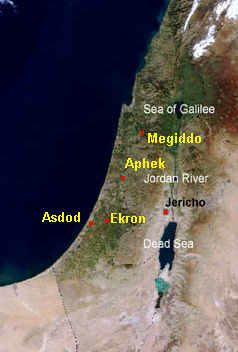
Map with Ashdod, Ekron, Aphek (in the
coastal plain) and with Megiddo, satellite photo
|
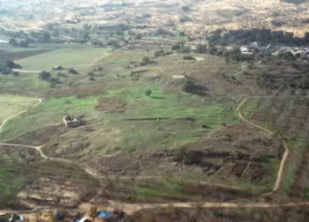
Ashdod: the hill of ruins (tell) is almost invisible
by the fields

The hill of ruins of Ekron (Tell Miqne) is only some
meters higher than the fields
|
-- and then Ashdod is destroyed after the times of Ramses III
by a fire
-- in 12th century B.C. new towns are founded on the ruins of
Ashdod and Ekron by Philistine immigrants, and the towns again
are wealthy, with a new material culture, but in a completely
new Aegean inspired style in architecture and pottery (p.104).
about 1230 B.C.
Fire storm in Aphek in the coastal plain
(p.104-105)
This fire storm is happening around the year 1230 B.C. This is
stated by archaeological findings: In the "layer of
destruction" is found a letter in cuneiform writing mentioning
Ugaritian and Egyptian officials who can be dated precisely
with other sources (p.105). The letter of Aphek in cuneiform
writing describes a vital corn trade between Ugarit and Egypt
(p.105).
1140 B.C. appr.
Fire storm in the
town of Megiddo
-- main witness
of this fire storm at the end of Late Bronze Age
are burned mud bricks
-- the "layer of destruction" with all it's rubble
has got a thickness of 1.8 meters (p.105)
-- the evidence for the date of about 1140 B.C. is
a metal socket of a statue found in the layer of
destruction with the name Ramses IV who was
governing 1143 to 1136 B.C. (p.105).
On the countryside life is going on as usual
(p.179).
|

 The hill of
ruins (tell) of Megiddo, see: www.bibleplaces.com The hill of
ruins (tell) of Megiddo, see: www.bibleplaces.com |
1130 B.C.
The big Empires in the
eastern Mediterranean are all destroyed
The changes in the region are dramatic, and also Egypt is
affected:
-- Egypt is a shadow of it's past and a big part of the Empire
is destroyed
-- the Hittite Empire with its capital Hattusha is in ruins
-- Mycenaean world with it's center of Crete is destroyed
-- trade with Cyprus with it's copper mines is stopped
-- Canaanite ports are only ruins, also the great sea power of
Ugarit
-- Megiddo and Hazor are fields of ruins (p.101).
Stop the bad fantasies: There
is a logic of time: 100 years of Joshua campaign are not
possible
It's proved that the towns of Hazor, Aphek, Lachish and
Megiddo are destroyed within 100 years. And it's impossible
that Joshua has made an invasion over 100 years (p.105).
[Conclusion: The faked war
hero Joshua has got ruins that are not from him
The Jewish priests of the 1 God movement who have written the
Old Testament, they meant that the ruins of the former times
could be used for the creation of a faked Jewish war hero. And
many believed it].
12 Documents in
Egypt with the name of "Israel"
1207 B.C.
There is a stele of victory of Pharaoh Merenptah
mentioning a great victory against the Israelites
(p.28)
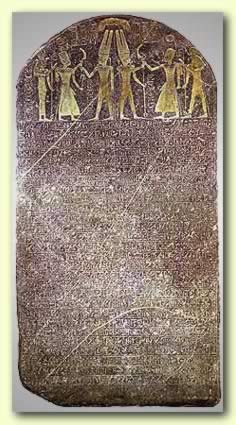 Victoria stele describing victories of
Pharaoh Merenptah
Victoria stele describing victories of
Pharaoh Merenptah |
Pharaoh Merenptah
is the son of Ramses II. According to this
"Merenptah stele" he is said having defeated the
Israelites in a successful campaign at the end of
13th century B.C. The Israelites are said having
been expelled and massively reduced claiming that
Israel's "seed would be off" (p.71).
This stele is the first safe historical proof of a
text mentioning the word "Israel" (p.71). But the
location of the alleged battle is not mentioned.
So, since 1207 B.C. it's only proved that in Egypt
it's known that some group exists with the name of
"Israel" (p.89).
According to archeology there are founded many new
villages in the highlands of Canaan at the same
time. These founding wave of new villages can be
connected with the expulsion of Israelite
population (p.71).
[It can be that the Israelites have played with
the sea peoples against Egypt, and Jerusalem was
at another place and is not detected yet?
Archeology cannot say anything yet. This stele is
a mystery. Speculations may go on...]
|
12th century B.C. / interim period from Bronze Age to Iron
Age / end of Late Bronze Age / 1150 B.C. appr.
Collapse of Egypt and Hittite Empires - wave of villages
- villages and towns in the highlands - independences
The powers are collapsing (p.134). City states of Canaan are
weakened
-- by raids of the sea peoples
-- by rivalries
-- or by social upheavals
-- accompanied by a fast economic decline.
Weakening of the city states of Canaan permits the
independence for the city states in the highlands - Shechem
(Bible name for "Israel") and Jerusalem (Bible name for
"Judah") (p.178).
The survivors of the
regions win the independence. The populations of the
villages are probably producing just for their personal
needs. But the heaviest consequences suffer the Bedouins:
They cannot change corn in the villages any more and have to
cultivate corn themselves now, and now they are settling
down, and there are more villages installed (p.134).
So, according to Finkelstein / Silberman the genesis of
villages is the result of the collapse of Canaanite culture,
and the importance of the Israelite villages is rising. The
native people were the Canaanites. Other peoples as the
foreigners, Bedouins who are called Israelites later, were
not from the coastal region (p.135)
Wave of villages also in the Eastbank of Jordan
river
Also in the Eastbank of Jordan river can be proved the
same wave of foundations of villages. But this local
population is not Israelite, but is forming the kingdoms of
Ammon and Moab and Edom later (p.135).
1180-1130 B.C. appr.
Towns without population
Some decades the big towns are left without population,
for example Megiddo, Tel Dor, or Tel Rehov (p.179).
1150-586 B.C. / European
Iron Age
The highlands of Canaan are developing a change into
territorial states
(p.32)
since 1130 B.C. appr.
New population in the towns of Canaan
The fields of ruins are populated by the native
Canaanite population again. There follows a regeneration of
the towns, for example Megiddo, Tel Dor, or Tel Rehov, but
the towns are not that big like before (p.179).
[Town on hill of ruins
("Tell"): by this are acropolis created
Every town constructed on a hill of ruins is 1.5 to 2 meters
higher. The repeated events of destruction and
reconstruction gives the result of towns on hills, and at
the end these towns are on an acropolis].
13 Alleged
split of the land after the victory after the faked
occupation
There
are different versions of victories for the faked
occupation: total victory or partial victory
OT claims:
-- the whole land is said having occupied by the Jews and
all enemies are said having defeated (Joshua 21, 43-44)
(p.112)
-- "The land was calmed by the war" (Joshua 11,23)
-- all Canaanites and other native peoples are said having
been destroyed (p.113).
But according to other passages in the faked book Joshua
many Canaanites and Philistines are going on living as
neighbors of the Israelites (book Joshua, book of Judges)
(p.112). The same book Joshua stating that all land would be
occupied (p.113) is stating in other passages that big parts
of Canaan are waiting to be occupied yet (p.113-114):
-- all territories of the Philistines on the southern coast
-- the Phoenician coast farther to the North
-- the whole Beka'a valley in the North East (Joshua 13,1-6)
-- and in over 50% of the tribal homeland would exist big
enclaves with Canaanites yet
-- according to book of Judges, Megiddo, Beth-Shean and
Gezer are not under Jewish occupation, but according to book
Joshua the rulers of these towns are in the list of the
alleged defeated kings
-- the Ammonites and Moabites on the Eastbank of Jordan
river, [the invented] Jewish enemies, are said having been
not defeated, as also the Midianites and the Amalekites with
their alleged assaults on camels coming from the desert
(p.114).
[All these contradictions provoke that the events of
Joshua's victories are not very trustworthy. But there are
other facts].
Life of the early Jewish
tribes according to outdated OT: book of Judges
At the beginning of the outdated book of Judges is indicated
the warning of assimilation in chapter 2,11-19 [racism with
prohibition of marriage], and inspired persons, fair-minded
men and women, so called "judges", have to save the
population of Israel of critical situation (p.115).
But ethnic mixed connections also were known, e.g. the case
of Simson (p.112).
The invented distribution of land according to
outdated OT
OT claims:
-- Joshua is said having called all tribes for a land
distribution
-- the tribes Ruben,
Gad, and the half of
the tribe Manasseh
are said having received land on the Eastbank of Jordan
river
-- all other tribes are said having received land on the
Westbank of Jordan river
-- the tribes Napthali,
Asser, Sebulon, and Issashar are said having
received land in the mountains of Galilee
-- the second half of the Manasseh
tribe and the tribes Ephraim
and Benjamin are
said having received the big part of the Westbank mountains,
the territory of Jezreel plain in the North down to
Jerusalem in the South
-- the tribe of Judah
is said having received the territory between the southern
mountain of Jerusalem down to the bay of Beersheba in the
South
-- the tribe Simeon
is said having received the dry plain of Beersheba and the
coastal plain aside
-- the tribe of Dan
is said having received the coastal plain and is said having
shifted his territory to the North of the country
-- then the tribal territories are said not having been
changed any more (p.113).
[Well, all these distributions are a big invention
indicating a right of territorial power. But the events were
other ones].
14 The fake of the
coordination of 12 tribes - and also the wars between
the 12 tribes are a fake
The
contradictions concerning the life of the tribes in the OT
-- the tribe Benjamin is said having been attacked by a
coalition of other Israelite tribes, and the coalition is
said having sworn that no marriage will be permitted any
more with the tribe of Benjamin (book of Judges, 19-21)
(p.112)
[Again we have here an ethnic racism with prohibition of
marriages]
-- according to the song of Deborah many tribes cannot be
loyal to God's law, get disloyal and are not doing it's best
for the "case of whole Israel" (p.112-113).
OT claims a danger of the 12 tribes from the beginning
OT claims:
The Israelite tribes are said having been encircled from the
beginning by enemies and by hostile enclaves in the tribal
territories having been in a dangerous position from the
beginning, in a military and in a religious way, and the
"people of Israel" is said having stood one performance test
after the other, with all possible "heroic deeds", but these
"heroic deeds" are only death and murder:
-- according to the book of Judges 3,7-11, Othniel, a Calebite, is
said having repulsed the mysterious enemy Kusan-Risathaim,
the "king of Mesopotamia" in an action alone
-- according to the book of Judges 3,12-30, Ehud from tribe of
Benjamin is said having killed the great and fat king of
Moab in his private room (p.114)
-- according to the book of Judges 3,31, Sambar is said having
killed 600 Philistines with one prick for bullocks (p.114)
-- Deborah and Barak are said having
startled the Israelite tribes against the staying Canaanite
kings in the North
-- according to the book of Judges 4,1-5,31 the wife of the
Kenite Heber, Jael, is said having
killed the Canaanite General Sisera with a stake during he was sleeping
(p.114)
-- according to the book of Judges 6,1-8,28, Gideon from the Manasseh
tribe is said having executed a cultural cleansing of the
land against idolatry and is said having defended his folk
from the Midianite thieves who operated from the desert
(p.114)
-- according to the book of Judges 13,1-16,31, Simson is said having
seduced by Philistine Dalila
and is said having been robbed of his curls (p.114), and
then he is said having been blinded and humiliated in Gaza
(p.114-115) and [after the hair was growing again] he is
said having destructed the columns of the big Philistine
Dagon temple in Dan (p.115)
[perhaps a suicide attack].
The facts of archeology: There was a reconstruction on or
besides the ruins - and there was a legend formed
The real life of the Israelites is hardly mentioned in OT,
neither in the book of Joshua (p.115) nor in the book of
Judges (p.115-116). According to Finkelstein / Silberman the
Israelites - after having migrated during 40 years in the
desert and after 10 years of wars of conquest - were badly
prepared for a peasant's life in a completely destroyed
country (p.116)
[respectively there had been famine and mass death, or the
neighboring "enemies" had converted into "friends" sharing
the food, or other enemies from abroad had defeated the weak
Israelis and had accepted well the "preparatory work"].
since 1100 B.C. appr.
Reconstruction of Canaan - independences of later
territories of Shechem and Jerusalem are not affected
|
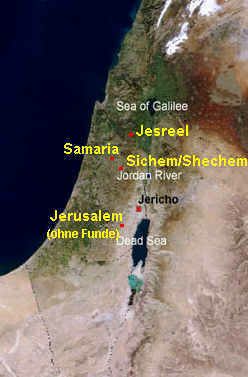
Map with Shechem, Samaria, Jezreel, and
Jerusalem. For Jerusalem there are no findings for
this period.
|
The Philistines in the Canaanite plain are working for their
power and gaining the power in the towns back. The
independences of the city states in the highlands (territories
of future kingdoms of Shechem and of Jerusalem) is not
affected (p.178).
The Phoenician descendants of Canaanites are occupying the
harbor towns in the North (p.178-179).
Megiddo and other towns are amplified. Megiddo is
reconstructed as a representative town. Archaeologically there
can be shown the whole development in Megiddo in the layers
(Stratum VIA). The refoundation contains practically all
characteristics of the former Canaanite culture
-- with a similar ceramic stile as in 12th century B.C.
-- with a similar layout as in 12th century B.C.
-- with Canaanite temple complexes etc. (p.179).
Such a development also have Tel Dor and Tel Rehov. But this
new growth is not for a long time (p.179).
Rubble mountains provoking
legend forming - example Bethel
It can be admitted that the huge rubble mountains of the towns
had a tremendous effect in the memory of the population.
According to Bible researchers Alt and North there are legends
formed with the topic of the rubble mountains with all
possible heroism,
-- because the painful experience of a destruction of a town
is not passing without effect
-- but the memory is always more blurred and is becoming the
rough material for all possible legends and claims (p.107)
[with the climax of the legends in OT since 7th century B.C.[.
In the case of the town of Bethel for example the huge rubble
mountain ("tell") in the East with the ruins from Late Bronze
Age is 10 times bigger than the reconstructed city (p.106).
15 Helpless occupation
theories from the 1920s to the 1970s
The
different conquest theories, and nothing helps with it
Since the 1920s up to 1967 war actions in Israel Palestine
are blocking any excavation activity in the West Bank [these
are wars on the base of the book "The Jewish State" of Herzl
with the hope for a big Jewish Empire from Nile to Euphrates
according to 1st Moses book 15,18].
By this block archeology is looking for the origin of
Israeli identity on the wrong spots for decades (p.121).
Occupation theory of
Albrecht Alt: "Peaceful infiltration" has not stayed
peaceful
In the 1920s Albrecht Alt is giving the theory that the
occupation had been of Bedouin's migration from the Arab
desert, and the Israelites had been one of many groups
(p.116). Until the 1970s traditional "science" is believing
the theory of a "peaceful infiltration" of Albrecht Alt.
But:
-- but the reasons for this infiltration are not clear
-- Alt states that the Jews had also cleared land
(eliminated forests) and begun with agriculture
-- Alt states that Jews had settled down by the time and had
constructed villages
-- by growing infiltration there had been fights with the
Canaanites how they are described in the book of Judges
(p.117).
[Conclusion: According to Albrecht Alt the book of Joshua is
not right, but the book of Judged with it's wars and mass
murders shall be right].
The occupation theory in combination with Egypt
sources: the societies of Apiru and Shasu
Egypt sources state that there were two outsider groups of
Canaanite society, the Apiru and the Shasu (p.117).
Apiru (also Hapiru, or
Habiru)
The Apiru are presented in a very negative sense in Egypt
sources (Amarna letters etc.). They are expelled people
driven to the margin of the society, parts of the population
which are expelled by war, hunger or heavy taxes or by
another reason, and they are defamed in the Egypt sources or
are presented as thieves or soldiers for hire, or also
as foreign workers (p.117).
When there is an alliance with the Apiru, so this is the
most negative alliance according to Egypt sources (p.118).
Scholars make a connection between the Apiru and the name
"Ibri" or "Hebrew". The scholars are stating for some time
that Apiru would be the oldest Israelites (p.118).
But new source research in other regions gives another state
of facts: The term "Apiru" was known in all Middle and Mid
East for centuries and probably was a sociological name for
a social class or profession sector. The derivation from
Apiru to Hebrew remains nothing more than a hypothesis and
is very unlikely (p.118),
[and could be possible only when the Jews had been scattered
in whole Mid and Middle East].
Shasu in Egypt sources
Shasu are mentioned in a papyrus report in the time of Ramses
III. The report says that Shasu Bedouins are robbed a total
tent camp with all cattle and possessions. So, Shasu are
probably nomads with sheep and goats in the frontier region
between Canaan and East Bank in the desert and in the
highlands. Shasu also had the custom migrating down to eastern
Nile delta crossing the Egypt fortress lines (p.118).
[But Moses never had been possible because with 600,000 Jews
under suspicion of conspiracy Egypt never had let them go].
The new conquest theory in the 1970s by George
Mendenhall and Norman Gottwald
There had been no wars between shepherds and farmers -
thesis of an exodus from the cities to the forests because
of high taxes
The contradictions in the theory of Albrecht Alt with its
thesis of infiltration by Israelis and the following wars with
Canaanites only get a new scientific answer in the 1970s.
Archaeologists find out that wars between foreign Israeli
shepherds and native Canaanite farmers are not believable.
Science states that both groups knew each other and accepted
each other (p.119).
Bible researcher George Mendenhall and later Bible historian
and sociologist Norman Gottwald are stating according to Egypt
documents (above all in reference to the Amarna texts):
-- that the Israelites were the rebels who had to take their
flight from the Canaanite towns to the empty highlands
-- that in the late Bronze Age tensions and inequality grew in
Canaan
-- that the elite in the towns controlled the country, wealth
and commerce
-- that the farmers had no rights and had to pay more and more
taxes
-- that many farmers had gone to exile, eventually some had
converted into Apiru, other had migrated to the forests in the
uncontrollable highlands
-- that there had been a great solidarity between the
discriminated who had taken their flight, and they had formed
a new social class, the "Israelites" (p.119)
-- Norman Gottwald means that the core of the ideology would
have been brought from the Echnaton revolution in Egypt to
Canaan, brought by a little revolutionary group from
Egypt having formed bigger groups in Canaan
-- by this social revolution had begun and would have been the
origin of an Israelite identity (p.120).
[This would be very good when Israelites had worked out their
national consciousness by a social revolution and would live
with this philosophy].
But: For Gottwald's thesis is missing any archaeological
finding. And the findings of the reconstructed towns after the
big fires are contradicting Gottwald's thesis that people had
taken their flight from the towns into the forests. There had
to be more similarities in respect of the construction style
and architecture (p.120).
16 Claim of OT for a
development of a big Empire: Saul - David - Solomon
Legends in the book of Judges
about the cults and ideas in the northern Reich and in the
southern Reich
|
|
Map of Assyria,
Babylonia and Elam of about 1,050 b.C.
Breakthrough to Mediterranean is coming soon...
|
The book
of Judges with it's events about the alleged kings Saul,
David, and Solomon consists of reminders to local fights and
is describing heroes in form of epic poems, folktales
(p.137) and myths (p.151).
According to the book of Judges king David and Solomon are
said having ruled from 1005 to 930 B.C. approximately
(p.145). Historicaly there cannot be proved anything.
Eventually hero stories of former times are mixed within
(p.137). But the book of Richter is presenting excellent
geographical descriptions of the landscape which has hardly
changed until today (p.151).
[Geographic precisino shall give the impression that also
the historic connectsions could be true].
The stories of the book of Judges shall serve as a "lesson"
to the population of Judah in 7th century B.C. after the
ruin of the North Reich Israel (p.137-138), and the
situations and stories can be interpreted directly to
situation in 7th century B.C. (p.138).
The book of Judges states an alleged cult between "sin"
and rescue
OT claims:
-- Israeli population lived in a repeated rhythm of sin,
punishment by god and salvage (book of Judges 2,11-19)
-- by the installation of kingdoms this repeated rhythm of
"sin", punishment and salvage is said having been broken
(book of Judges, 21,25)
-- the relation between Israelites and God always is said
having been in danger, this interpretation is arbitrarily
made by the authors
-- God is said having done the Israelites into the hands of
their enemies because of disloyalty, so the Israelites will
beg for help with God, and then the Israelites are said
having regeretted and God is said having saved the
Israelites resp. having helped to victories over their
enemies
-- this is a religious cycle with alliance - promise -
disloyalty - regret - salvation which is always repeated
-- it seems that the situation of the kingdom of Judah was
similar in the 7th century so there were many hopes for a
salvation (p.137).
OT: Alleged destruction of all other faith groups as a
condition for a salvation
[and this is a total religious racism].
OT claims:
-- all other faith groups in the southern half of the
alleged tribal territories shall have been destroyed
fulfilling the will of God (p.138) resp. in the southern
part all Canaanetes are said having been destroyed (p.168)
-- the alleged trials for an ethnic cleansing and mass
murder in the northern part are said having failed all, and
there shall have existed Canaanete enclaves (book of Judges,
1,21; 1,27-35) (p.138)
-- by this reason - because the other faith groups were not
totally destroyed in the northern half - is said that the
split North Reich of Israel had been destroyed later, and
teh alleged later South Reich Judah is said having rated as
the "better" Reich (p.138)
-- it's stated that in the northern part the Canaanetes have
mixed with the Jewish tribes, and this shall be a sin which
leads to the later foreign occupation of the northern part
(p.168)
-- Bible describes that the South Reich Judah is stronger
whereas the North Reich is stronger in fact (p.169).
OT: The faked king Saul
OT claims:
-- from an alleged tribe named Benjamin has come an alleged
first ruling king Saul (p.140)
-- the alleged king Saul was the king of the alleged North
Reich, and after a military defeat against the Philistines
he is said having committed suicide (p.168)
-- Saul and his son Jonathan are said having been killed in
the Philistine wars (p.151)
-- the Philistines are said having won the battle of Eben
Ezer and are said having robbed the Ark of the Covenant
(p.151)
-- then the northern tribes are said having proclaimed David
(king of South Reich Judah) for the king of whole Israel
(p.168).
OT: The faked king David - the faked culture of David
OT claims:
-- David is said having occupied Jerusalem in a hit-and-run
style and is said having installed an own regency in this
way (p.260)
-- then king David is said having made an alliance with God,
and David is said having banned all foreign gods and is said
having ordered the daily cult (p.138)
-- king David is said having defined Jerusalem as the single
capital of the Jews (p.138)
-- kind Gadiv is said having defined a definite place for
the Ark of the Covenant (p.138-139)
-- king David is said having ordered the tempel in Jerusalem
so there was adorated only one single god (p.139)
-- David temple is said having been the key for the
salvation of Israel and of the destruction of all other
faith groups, and is said having benn the "key" for the stop
of the negative events for Israel and for growing wealth
(p.139)
-- the alleged king's palace in Jerusalem is said having
been a mental hot spot
-- David, the son of Isai, is said having been anointed as
the king of all tribes of Israel and by this the promise of
God which was given to Abraham is said having been fulfilled
(p.140)
-- David is said having been a fair-minded king and is said
having represented a myth figure in the history of Israel
(p.140).
King David is said having completed the "work" of ethnic
cleansing and genocide which was begun under Joshua:
-- king David is said having occupied the rest of the land
-- king David is said having amplifyed the Reich to the
frontier lines of Abraham [according to 1st book Moses,
chapter 15, phrase 18: Nile and Euphrates as border lines]
-- king David is said having founded a famous Reich (p.161).
[And with this conquest and occupation and ethnic cleansing
is connected "Star of David", and that's why Zionism is
never giving up it's conquests against the Arabs, and that's
why all Arab countries never will accept a "Jewish State"
with the "Star of David" in it's flag. Also stupid
journalists should see this connection].
This invented king David is described and gloryfied in many
songs and stories.
OT claims:
-- king David is said having occupied Jerusalem and a big
Reich
-- king David is said having hit Goliath with one single
stone with a slingshot and killed him in this way
-- king David is said having reached to the court of the
king playing harp in a skillfull way
-- king David is said having been a rebel and a pirate
-- king David is said having persecuted Bathseba in a
lustful way (p.140)
-- king David is said having won many battles against the
Philistine towns (p.151).
OT: the faked cult of Solomon
OT claims:
-- king Solomon is said having ruled from the Egypt frontier
down to the Euphrates (p.182)
-- David's son Solomon is said having treated the northern
tribes like colonized subjects, with high tax and compulsory
service (p.168)
-- king Solomon is said (1st book of Kings 11,4-8) having
seduced to "idolatry" by a foreign woman, to a cult for the
goddess of Sidon, Astarte, and for the cult of the dreadful
god of the Ammonites, Milkom (p.182), and king Solomon is
said having accepted these cults then: the cults for god
Milkom of the Ammonites, for the god Kamos of the Moabites
(p.262), and for the goddess Astarte of the Sidonites (1st
book of Kings, 11,5; 2nd book of Kings, 23,13) (p.263)
-- Solomon is said having sunk in "sin", according to 1st
book of Kings 2,1-89 he is said having brought a harem of
foreign women to Jerusalem (p.162)
-- and then (according to 1st book of Kings, 11,11-13) God
is said having punished king Solomon with the split of the
"Reich of Israel" (p.182).
Depsite of all David's son Solomon is said having been the
king with the maximum of wisdom, and he is said having been
a great building owner, and he is said having been able
deciding sharp witted verdicts, and he is said having been
very rich, and he is said having constructed the tempel of
Jerusalem (p.140).
The readers of the Bible is presented a "Golden Age" of
Israel under David and Solomon, but this is only a fake. The
scholars partly believe in this yet today, and archeologic
findings are classified to David Solomon story despite of
all contradictions,without calling the story well into
question (p.140).
The claims of the old scholars according to the Bible
-- Israeli settlements are said having grown under the kings
of Saul, David, and Solomon
-- there is said that there were installed many centralized
forms of organization
-- there is said that the danger by Philistine coastal towns
has driven the development to an Israelite monarchy (p.141).
"Allocations" with much fantasy
-- the geological layers with the destructed Canaanite towns
are allocated to the conquest under David (p.141)
-- the city gates and findings of the palace are generally
allocated to the construction activity under an alleged king
named Solomon (p.141).
In this way was performed archeology for centuries.
17 The search for proofs
for an alleged David Reich and for alleged destruction
of Philistine towns
Archaeological findings for the
structures of a Reich of David are missing
Some of the Philistine towns are excavated in big parts
(p.151).
-- where can be stated a fire around 1000 B.C. destroying a
town of the Philistines (p.151-152) - and this can be
detected with layers of ashed in combination with overturned
stones (p.152) - the scholars of before state that the fire
was from an expansion under David, e.g. in the case of Tel
Qasile where archaeologist and historian Benjamin Mazar
states this (p.151-152)
|
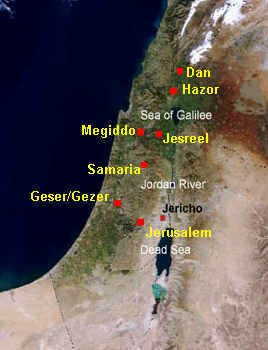
Map with Jerusalem,
Megiddo, Geser, and Hazor, satellite photo.
Jerusalem does not exist at this time.
|
The
case of Jerusalem: where was the temple?
-- archaeologists never can find any little peace of the
alleged temple of alleged king Solomon (p.152)
-- the scholars simply are searching in other places than in
Jerusalem finding alleged traces of the Reichs of David and
Solomon, e.g. in Megiddo with findings from Iron Age
(excavations in the 1920s and 1930) (p.152).
The case of Megiddo
-- Megiddo is a cross point between the roads to Egypt, to
Mesopotamia, to Anatolia (p.152), and to the Jezreel plain
(p.154)
-- the buildings are - according to the constructional
engineering described in the Bible (in 1st book of Kings,
7,12) - interpreted as the "cattle sheds of Solomon" (this
says the leader of the expedition P.L.O. Guy) (p.154)
-- from Iron Age also a city gate is excavated, a six
chamber gate, and scholars are stating that it would be from
king Solomon (p.154).
The case of Hazor
-- in the 1950s there are excavations under the leadership
of archaeologist Yigael Yadin (p.154)
-- there can be found a big city gate from Iron Age, a six
chamber gate as it was found in Megiddo
-- and again the scholars state that the gate would be from
Solomon (p.155).
The case of Geser
-- the first book of Kings states in chapter 9 phrase 15
that Solomon had made reconstruct the town again
-- and by an excavation under the leadership of R.A.S.
Macalister at the beginning of 20th century Yigael Yadin [in
the 1970s?] can find another six chamber gate (p.155).
The claim of Yigael Yadin
about an architect of Jerusalem
Now, archaeologist Yigael Yadin claims that a royal
architect from Jerusalem had made reconstruct the towns
again because there would be the evidence of the three six
chamber gates which are similar one to each other (p.155).
Archaeologist Yigael Yadin states that 1st book of Kings
chapter 9 phrase 15 describing the construction of towns
under Solomon would be true (p.156).
Megiddo:
search for a palace and a claim for a palace
-- in Megiddo was found a city gate, and now the
archaeologists mean that there also could be found a palace
-- the excavations under the alleged "cattle sheds of
Solomon" show several palaces, but this are palaces in a
north Syrian stile "bit hilani" of Iron Age
-- and now the archaeologists state that these rests of
palaces would stand in connection with the six chamber gate
(p.156).
Pupil of Yadin, David Ussishkin, states
-- the palaces of Megiddo had been constructed under king
Solomon because the biblical description of the alleged
palace of Solomon in Jerusalem would also fit to the palaces
of Megiddo
-- the "cattle sheds of Solomon" are said having built under
king Ahab in 9th century B.C. (p.157).
But archeology
states clearly: kingdom of David and kingdom of Solomon
never have existed
 Reich
of David and Reich of Solomon never existed. For
these kingdoms any findings for structures of
such Reichs are missing. Reich
of David and Reich of Solomon never existed. For
these kingdoms any findings for structures of
such Reichs are missing.
|
|
According
to Finkelstein / Silberman archeology can find on the
territory of alleged South Reich Judah for the time of David
and Solomon only 8 little villages with appr. 1,500 resident
inhabitants. According to the archaeological research it can
be admitted that there were more shepherd nomads than
resident inhabitants (p.259).
There is no trace of any kingdom of David. When king David
had occupied Jerusalem, so this has not changed anything
with policy of isolation and of illiteracy with shepherds.
When there was a Reich of David and a Reich of Solomon, so
these Reichs practically had no power (p.260). Ruins or
findings of a temple of Solomon cannot be found (p.152).
According to archaeological research social structures
correspond with these of isolated regions: Possible are
discriminated "Apiru", or people like Bedouins "Shasu", or
independent clans acting for their own (p.259).
[Just a main temple with it's dimensions and massive, high
walls should provoke ruins which stay for ever, just when it
should be a temple for a Reich from Egypt to the Euphrates.
So, it can be that this temple only was a simple room, or it
that this temple only was a tent, or Jerusalem was at
another place for this time and the temple would be not
detected until today.
The rise of the highlands to a kingdom after all the
destructions by the sea folks would be logic. But for the
whole time findings are missing. So there can only be nomad
Reichs, without army, without administration, without
written documents, without poesy. David psalms and Solomon
sayings would be from another person, so. Speculations may
go on...]
Finkelstein / Silberman mean that David and Solomon were
nothing more than tribal leaders (p.209). OT describes the
relationships between North Reich and South Reich before the
ruin of the North Reich Israel, but in only one passage in a
realistic way, in 2d book of Kings 14,9: Judah is described
as a "thistle on
Lebanon", and Israel is described as a "cedar on Lebanon".
According to Finkelstein / Silberman these were the real
dimensions (p.250).
A verification of the excavations gives new sociological
facts
There is stated by a new verification of the excavations
which were performed until now that the excavations cannot
fit into the allocated ages:
The monuments which were allocated to Solomon times have to
be allocated to other kings, and the expansion of Reich of
David is absolutely controversial:
-- the type of palace in north Syrian style "bit hilani" is
coming up in Syria in early 9th century B.C. for the first
time (p.157-158), and so the palaces are not from Syria
(p.158)
-- and in Jerusalem doesn't exist any palace like this
(p.158)
-- the end of Philistine ceramics in appr. 1000 B.C.
accidentally comes at the same moment as the alleged
destruction and occupation under David (p.158)
-- new archaeological findings in the late 1990s can proof
(p.147) that there was a kingdom of David, but it had been
only little, and not at all as big as described in the Bible
(p.148).
Verification of Jerusalem: there are no findings for
David or Solomon - and no literature can be found
-- the excavations in Jerusalem don't show any new proof for
buildings of the alleged times of kings of David or Solomon,
because for there cannot be found any temple for David or
Solomon, and add to this there cannot be found no finding at all for
this time (p.141)
-- according to excavations in the 1970s and 1980s in
Jerusalem there cannot be stated any significant population
in this region for the time of 10th century B.C., the time
of the alleged kings of David and Solomon, no monumental
architecture either, and no potsherd from this time either
(p.150)
-- but from other periods there are many findings, e.g. from
Mid Bronze Age and late Iron Age (p.150)
[so, the claim that all ruins had been destroyed by later
construction work and by this there would not be any finding
of David and Solomon, cannot be right - but this state the
Bible believers. Well, it can be that the temple only was a
room, or only was a tent, or Jerusalem was at another place
than today].
-- in 19th and 20th century there were excavations around
the Temple Mount, but there is not found any trace of Salomon's great
temple (p.145).
At most David and Solomon were ruling a very little Reich
Judah with no political significance in the offside of the
great political events. There did not exist any big richness
or central administration as it is indicated in the Old
Testament with a temple town of Jerusalem. Kingdom of Judah
has a steady development for centuries. Jerusalem at most
was a religious place among others without any findings, and
Jerusalem was not at all a center (p.258).
The growth of literature, of religious thinking and of
historiography as it is indicated for the time of the
alleged kings of David and Solomon and their sons in OT,
cannot be found in any place. To the contrary: The
population is mainly illiterate and for sure have never read
any literature or noted down history. Historical texts - as
they are put into stone as in Egypt or Mesopotamia - are
missing for North Reich Israel and South Reich Jerusalem for
the time of David and Solomon (p.255).
Monumental inscriptions and seals of the kings - the main
characteristics for a developed state - are totally missing
for the territories of North Reich Israel and South Reich
Jerusalem up to the late 8th century B.C. (p.255).
The documents:
the neighbor states never mention any Reich of David or
Reich of Solomon - the Syrian type of palace - Jerusalem
without palace
-- investigating the documents of the neighbor states there
cannot be found anything about a Reich of David, and no
commercial relation is mentioned etc. (p.157)
-- in texts of Egypt or of Mesopotamia "King David" and
"King Solomon" are never mentioned (p.145)
-- in 1993 there was found a peace of a stele in Tell Dan
with an inscription mentioning the house of David, probably
with the description of the attack of Damascus under Hasaël
against the North Reich Israel in 835 B.C. (p.146).
More precise archaeological data: the city gates are from
9th century B.C. - Jews were in illiteracy and there was
at most a village of Jerusalem without any trace
-- latest analysis in Megiddo, Geser and Hazor about the
architecture styles and ceramic forms, and new precise radio
carbon methods can state that the excavated city gates are
from early 9th century B.C., when the invented Solomon is said
having died since decades already (p.158)
-- by this the palaces in Canaan have the same age like the
Syrian palaces, that is 9th century B.C. (p.159)
-- so, in the epoch from 1100 to 1000 B.C. no palaces were
constructed in the alleged South Reich Judah, but this
territory was absolutely natural yet and without any
construction of any town (p.159)
-- David and Solomon are left as figures without Reich
(p.159). Finkelstein / Silberman say:
"There is hardly any reason doubting the existence of a David
and a Solomon. But there are many reasons to call into
question the dimension and the richness of these Reichs."
(p.159)
-- David and Solomon as great kings - this is nothing more
than a myth (p.160)
-- written documents or inscriptions of the alleged South
Reich Judah don't exist (p.160)
[but great kingdoms normally always are immortalizing
themselves with monuments and memorial texts in stoned walls]
-- it seems that in South Reich Judah the population consisted
mainly in illiterate farmers yet. But monarchy with
illiterates is impossible. Finkelstein / Silberman say:
"The land [the highlands of the alleged South Reich Judah] was
mainly populated with farmers - without any trace of written
documents or inscriptions, and not at all with characteristics
of a wide spread capacity for reading and writing which would
be necessary for a well functioning monarchy." (p.160)
Jerusalem in these times is at most nothing more than a
village of illiterate people. Finkelstein / Silberman:
"Jerusalem itself could have been at most nothing more than a
typical village in the highlands." U(p.160)
[According to archaeological truth Jerusalem did not exist as
a settlement during the alleged times of David and Solomon,
respectively is was an empty hill of ruins].


18 Archeology:
the real structures in the highlands in the time of the
faked kings David and Solomon
The real kingdom of David: tiny dimensions
in the highlands
Kingdom of David which is provable by archeology goes from
the southern part of the highlands from the northern border
of Negev and to the southern region of today's Jerusalem.
This kingdom of David was only heavily accessible and hardly
had agricultural resources (p.148). Central highland from
Jerusalem to Hebron was stony desert in these times. Only
step by step this stony desert is liberated from it's stones
and is converted into fertile earth as it is today (p.149).
[The change from a stony desert to a fertile plain happens
only later by a hardship when the big Empires are cutting
more and more the little Reich Judah].
In the kingdom of David
-- people are illiterate, shepherds and farmers are mixed,
there is no writtenness, and there are no structures of any
Reich (p.160)
-- it can be estimated that there lived 45,000 persons in
the highlands, perhaps 40,000 in the North, not in the South
near Jerusalem (p.160)
-- the visit by queen Saba in Solomon's house claimed in the
Bible (1st book of Kings 10,1-10) in combination with the
country Ophier and far commercial expeditions to Ezyon Geber
(1st book of Kings 9,26) are only possible 300 years later
when the structure of Judah had developed managing big
commerce (p.161)
-- add to this - according archeology - Ezyon Geber at the
Red Sea has no population before the "late time of the
Kings" (p.161)
-- the construction of Thamar (1st book of Kings 9,18) in
the desert also is only possible 300 years later, and
according to archeology has got a population also only
during the "late time of the Kings" (p.161)
-- during Bronze Age and in the beginning of the Iron Age
the region is stony with tense thicket and forests, farmland
hardly exists (p.149)
-- at the time of the Jewish highland villages (12th to 11th
century B.C.) hardly 10 Jewish settlements are found there
(p.149)
-- the number of villages is rising step by step, but the
system of villages is the same also in 10th century B.C.
(p.149)
-- in the North of the alleged South Reich Judah are
installed fruit and vineyard cultures on the western slopes,
in the territory of proper South Reich Judah the soil is too
stony (p.149)
-- according to archeology up to the rule of invented
Solomon the invented kingdom of David is in complete
isolation and is hardly populated by resident population, is
blocked in it's development without any bigger urban
settlement (p.149)
-- Jerusalem in these times of invented David and Solomon is
even no meeting point for Bedouins, the site has no findings
at all from this time (p.150)
-- according to archeology appr. 20 little mountain villages
can be stated for the territory of Judah in the 10th century
B.C., with some 1,000 inhabitants, a big part of them are
shepherds (p.150).
No writing ability in Israel Palestine up to the
end of the 8th century B.C.
Up to the 1990s philologists and anthropologists suppose
that there was a strong and fully formed state under the
kings of David and Solomon. But the Bible text about
Jerusalem describing Solomon and David in the 10th century
was probably written only to the end of the 8th century
B.C.,
-- because until this time there are no findings indicating
that there was a writing ability
-- because until this time there are no findings indicating
a statehood of Judah or Jerusalem (p.34)
-- a big Reich under David and Solomon from the Red Sea up
to Syria is not possible without knowledge of writing and
reading (p.150)
-- without army and without developed weapon production such
a big Reich would never be possible against the big Empires
of Egypt and Mesopotamia, there should be a lot to be found
when there had been such a weapon production for such a huge
Reich (p.151)
-- also remnants of a big administration of such a big army
are missing, and without such a big administration rule of
such an Empire with this dimensions under Solomon is never
possible (p.151).
Only since 8th century B.C. there can be stated a scripture
in both city states of Shechem (Bible says "Israel) and
Jerusalem (Bible says "Judah"), and it's a common scripture
(p.178).
[Inversion of argument: with ability of writing
and reading also manipulation is possible now
As soon as the power of Jerusalem is big enough and ability
of writing and reading is spread enough, also mass
manipulation will be possible, which is executed by invented
OT.
There are other cases where the populations won the ability
of writing and reading and then suddenly were manipulated
into the ruin, with Mao in China and with Lenin and Stalin
in Russia].
945-924 B.C.
Egypt: Pharaoh Shishak = Sheshonk I.
Pharaoh Shishak (Bible, first book of Kings, 14,25) is
identified as Sheshonk I from 22th dynasty in Egypt. Pharaoh
Sheshonk I is leaving a report of a military campaign at the
wall of Amun temple in Karnak in Upper Egypt, but this text
leaves open any speculation. Clearing of this text only
comes with precise archaeological methods of date
determination (p.28).
Amun temple in Karnak
|
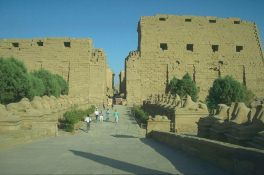
 Amun-temple in
Karnak, outer front Amun-temple in
Karnak, outer front

 Amun-temple in
Karnak, columns with inscriptions Amun-temple in
Karnak, columns with inscriptions
|

Map with Karnak, Luxor, Thebes, Giza, and Cairo on
the Nile river
|
Assyria is developing more aggression
According
to excavations of towns, huge palaces and archives of
cuneiform writings in Asia Minor the Empires with it's
capitals Ninive (Assyria) and Babel (Babylonia) are detected
as aggressive (p.28).
Assyrian data
|

God Ashur, the supreme Assyrian god. Like him all
Assyrian rulers want to look like...
|

Clay tables with
cuneiform writing from Babylonia, 2000 to 1700
B.C.: article of a lexicon with the report about
different kind of fish
|
Map with Ninive,
Ashur, Babylon, Mari, the rivers Euphrates,
Tigris and Orontes
|
|
Clay table with
cuneiform writing from Lagash, appr. 2500 B.C.,
with a bill of cost for clothes of the temple of
the main goddess
|
Main archives are the one in Mari and in Nuzi Licht
(Mesopotamia, cuneiform writing) and Tell el-Amarna (Egypt,
hieroglyphic writing) (p.30).
[Nuzi consists of several hills of ruins "Yorghan Tepe" and
is called also Ga-Sur].
The findings prove the ability of administration for big
Empires. Artists and writers are documenting the events in
clay tables and in stone. In the cuneiform writing archives
of Mesopotamia are even indications for some Biblical kings,
for example the Israeli kings Omri, Ahab (p.28), or Jehu,
and also kings of Judah are mentioned like Hezekiah and
Manasseh (p.30).
[But there is no David and no Solomon mentioned].
926 B.C.
OT: Pharaoh Shishak is said having plundered the
temple of David
OT claims:
-- Pharaoh Shishak (named in Egypt sources like "Sheshonk"),
the founder of the 22th dynasty, is said having committed a
violent assault (p.179)
-- Pharaoh Shishak [also: Sisak] is said having robbed all
temples and also the temple of David resp. the temple of
Solomon (1st book of Kings 14,25-26) (p.179-180).
The documents and archeology about Shishak /
Sisak: It was king Hazael - and there are no findings of
temples
|

Map with Beth Shean, Rehvo, Megiddo, and
Tanaach, satellite photo
|
Bible does
not mention the dimension of world's policy. For Pharaoh
Shishak the little kingdom of Israel only was a station on
the way [during the war against Mesopotamia] (p.180).
The big Canaanite towns of Rehov, Beth-Shean, Ta'anach and
Megiddo are destroyed. There are thick layers of rubble
(p.180).
The inscription of victory on the walls of the big temple in
Tarnak in Upper Egypt is reporting the invasion counting 150
destroyed towns and villages:
-- in the South
-- in the highlands of the West Bank
-- in Jezreel plain
-- and in the coastal plain (p.180).
But Finkelstein / Silberman are asking why Shishak is said
having destroyed the towns when he wanted to rule in this
territory later. When the North Reich would be destroyed so
Canaan would have most profit of this, and this was surely
not what Shishak wanted (p.180).
According the new allocation of time with the correction of
100 years Shishak is liberated from the invasion, and there
is a new culprit detected, king Hasaël from Aram Damascus:
He made the destructive invasion (p.221,223).
Archeology: growth in city state Shechem in the
10th century B.C. - city state of Jerusalem is a shepherd
land yet
|

Map with Shechem, Samaria, Jezreel, and
Jerusalem. For Jerusalem there are no findings.
|
Northern city state Shechem (later "North Reich Israel") is a
fully developed state with strong relations to it's neighbors
(p.178). City state Shechem can have a free development now
after the Canaanite towns were destroyed, and Shechem can
expand to the bordering plains (p.181).
[Writings for Shechem are: Sichem, Sychem, Sechem, Salem, in
Greek and Latin Sikima, or Hebrew Shechem, with "Tell
Balata"].
The southern city state of Jerusalem (after the ruin of the
"North Reich Israel" came the rise to "South Reich Judah") has
hardly relations to it's neighbors because of the geographic
conditions with steep slopes and the Dead Sea (p.178). In
souther city state Jerusalem shepherd life is going on with
illiteracy and without any administration, statal structure or
army. By this, Shechem and Jerusalem are not at all two "twin
states" as it is prescribed in the OT (p.181).
Common characteristics of the
city states of Shechem and Jerusalem
-- in both territories is adored God JHWH besides other gods
-- the populations have many common myths, heroes and stories
about the past
-- the populations have similar language and dialects of
Hebrew (p.178).
For the northern city state of Shechem the southern city state
of Jerusalem is a rural backcountry. And the Canaanite city
states in the plain and on the coast are normally always more
developed than Shechem (p.178).
[Considering their development there is the following ranking:
first come the coastal towns, then Shechem (later with the
capital of Samaria), and at the and comes the South Reich
Judah with Jerusalem].
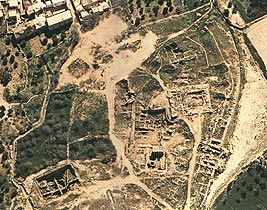
Sichem / Shechem: hill of ruins Tell Balata,
satellite photo
|
|
What tells archeology about the city states of
Shechem and Jerusalem of the 9th century B.C.?
According to archeology, city state of Jerusalem - named
"Judah" in the Bible - has only little population during 10th
and 9th century (p.176) and has hardly 20 villages (p.177).
City state of Shechem - named "North Reich Israel" in the
Bible - has a dense population with differentiated population
structure, from big regional centers to little hamlets, with
an economic "growth" (p.177).
Shechem's commerce during the early 9th century B.C. with it's
neighbor regions leads to growth,
-- so there come regional fortified administration centers
-- so there can be built great palaces of blocks of stone, for
example with stony capitals, for example in Megiddo, in
Jezreel, and in the capital Samaria (p.177).
Around 900 B.C. city state of Shechem (later "North Reich
Israel") has got a full administration apparatus and a social
stratification. In it's commerce luxury is handled. And luxury
architecture is completing the picture of "representation"
(p.177).


19 The kings after
alleged king Solomon
926-909 B.C.
King Jerobeam and prophet Ahijah - Jerobeam is said
having installed two golden calves in Bethel and in Dan -
"disloyalty" to God and prophecy of Ahijah
For this period there are
no
archaeological finding available.
|
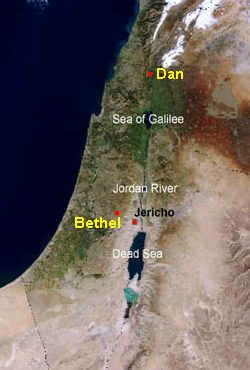
Map with Bethel and Dan where is said
having installed the two golden calves,
satellite photo
|
OT claims:
-- king Jerobeam is said to be the son of Nebats of the
Ephraim tribe which is responsible for the search of serf
laborers in the northern tribes (p.182)
-- king Jerobeam is said having governed for 22 years
(p.189)
-- king Jerobeam is said having received a prophecy of
prophet Ahijah (p.182) that the alleged Solomonic Reich will
be split (1st Kings 11, 31-39) (p.183)
-- king Jerobeam is said having installed two golden calves
in Bethel and in Dan (1st book of Kings 12, 25-30) (p.183)
respectively king Jerobeam is said having ordered the
construction of a temple in Bethel (p.297) and by this
Jerobeam is said having been more disloyal to God yet
(p.183)
-- during a sacrifice action in Bethel king Jerobeam is said
having received the prophecy from a "man of God" that Josiah
will be born who will slaughter the priests on the heights
and will burn human bones on Jerobeam (1st book of Kings 13,
1-2) (p.184).
This prophecy is said having been uttered before 300 years,
and Josiah is said having fulfilled this prophecy
later (p.184). In this manner Bible actions are
"coordinated"...
Illness of Jerobeam's son Abijah - the alleged prophecy
of the extermination, and dogs and birds
OT claims:
After the latter prophecy Jerobeam's son Abijah has fallen
ill, and Jerobeam's wife is said having asked for help at
prophet Ahijah. Prophet Ahijah is said having answered the
wife,
-- that because of disloyalty to God there will come evil to
the house of Jerobeam
-- the house of Jerobeam will be exterminated and the town
the dogs will eat the dead bodies and in the fields the
birds will eat the dead bodies
-- the son will die when the woman is returning to the town
(p.184)
-- the son will die because he is the only loyal to God in
the Rehab clan (p.184-185)
-- God will destroy Israel as a punishment and will disperse
them at the other side of the Euphrates (1st Kings 14, 7-16)
(p.185).
According to Finkelstein / Silberman there is the strong
suspicion that Josiah has written all this himself
"coordinating" his prophecies (p.185).
According to OT Jerobeam was followed by his son Nadab
(p.189).


20 Faked
split of a Jewish Reich in an alleged Israel (northern
Reich) and Judah (southern Reich)
There were a
northern and a southern religion - but never as a
political unity - and by this there was no split either
In the books of OT history of both kingdoms is [in a
tendentious way] mixed (p.35), and the "scholars" believe a
long time in these OT stories (p.169), [partially until
today (2010)].
King Rehobeam is said having discriminated the
northern tribes so they split from him
OT claims:
The alleged northern tribes are said having split from the
son of Solomon, Rehobeam, because of tax claims (p.167):
-- the son of Solomon, Rehobeam, is said having
discriminated the northern tribes even more with taxes and
military services (1st King 12,16), then the minister of
Rehobeam is said having been stoned to death and Rehobeam is
said having fled to Jerusalem (p.169)
-- the northern tribes are said having proclaimed Jerobeam
as their own king having provoked a split by this (p.169)
-- the newly proclaimed king of the northern tribes,
Jerobeam, is said having defined Thirza as a new capital and
having ordered a new cult with two calves against the cult
of the temple of Jerusalem, whereas the golden calves are
said having been installed at the outer posts of the alleged
northern Reich: at Dan in the North, and at Bethel in the
South (p.169)
-- then there is said having developed split and hatred by
200 years and there is said that both kingdoms had attacked
each other (p.167), with rivalries and struggle of dynasties
against the alleged "house David" in the South (p.167)
-- generally the kings of the northern Reich Israel are
described in the outdated Bible as stubborn sinners, and the
kings of the southern Reich are committing only little sin
(p.21)
-- according to OT idolatry and violence in the northern
Reich was normal, with alleged counter temples and with new
cult centers against the alleges temple of Jerusalem of
Solomon (p.167)
-- according to OT the altar sites of Abraham in the
northern Reich, Bethel and Sichem, are polluted by the
Israelite kings by idolatry (p.57).
The documents about the northern and the southern region
The texts about
the two regions are texts from Egypt with
condemnations and curses. These texts are written
on figurines of war prisoners found in graves. The
figurines were found in a broken condition. By
this the enemies of Egypt should be brought bad
luck, with sorcery as it is applies with Woodoo
puppets (p.173).
There are mentioned the Canaanite sites which were
considered a danger for Egypt, and there are
described the social structures of Jewish life.
From the mountain region only Sichem and Jerusalem
are mentioned (p.173).
|
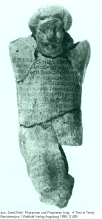
 Broken
figurine with a text with condemnations Broken
figurine with a text with condemnations
|
Archeology knows a
northern religion and a southern religion
There was never a political unity, and by this there cannot
have been a split either
The frontier between the northern Reich and the southern Reich
prescribed in OT corresponds more or less to the traditional
and natural frontier of the settlement area in the region. The
Bible propaganda of OT is defining the natural frontiers of
the differently developed regions to political frontiers
(p.171).
northern Reich: The
northern area is developing to a rich, cosmopolitan and
powerful Reich in the region (p.35), and that's because the
traffic routes to the East are relatively simple to handle
(p.175) and also because of the agriculture which is well to
handle on the West slopes which are not too steep and in the
valleys (p.176)
southern Reich: The
traffic ways to the East are steep with much height difference
and with the Dead Sea between it and by this the traffic can
hardly be executed (p.175), and the cleft valleys and the
desert steps are hardly fertile, so there cannot be any
economic growth with that (p.176). southern Reich is isolating
itself with a hight tradition for the temple and royal dynasty
(p.35).
There was never a political split because both territories
never had a common policy and never formed a common state
(p.167-168). Both city states incorporate different culture
and identity (p.35).
21 8th century B.C.:
foundation of Judah and Israel - first climax of Israeli
foundation of villages
Since
the 8th century B.C. the neighbors relatively often
mention a kingdom of Israel
After the foundation of the kingdoms of Judah and Israel the
climax of wave of settlement has reached in 8th century
B.C., with over 500 locations with about 160,000
inhabitants. Economy is among others above all cultivation
of olives and vineyard cultivation (p.131).
[How the foundations of the kingdoms have been executed is
not prescribed. According the documents and archeology
surely not were founded by a David or by a Salomo, or the
temple was only a room or a tent or had been in another
site, or Jerusalem had been at another site in David Salomo
times as the only town of the region. It's fix that since
8th century Northern kingdom Israel relatively often is
mentioned by their neighbors, but Southern Reich Judah only
rarely. So, David and Solomon have no world wide relevance
at all and are no factor of power in the region - when they
had existed].
Begin with propaganda for a "liberation" with an "exodus
from Egypt"
Already in 8th century B.C. there is mentioned an exodus
from Egypt:
-- in the oracle sayings of prophet Amos (2,10; 3,1; 9,7)
-- in Hosea texts (11,1; 13,4) (p.82).
8th to 7th cent. B.C.
Important caravan commerce
with Arabia
The caravan trails from Arabia end all in Gaza (p.288). By
this the caravan trails passing the North Reich Israel are
always more important for the big powers (p.289).
In 8th and 7th century come spices and rare incense from
Southern Arabia. The caravans pass the desert reaching
Mediterranean [one can admit that the deserts were more
little than today because of climate fluctuations]. So,
nomad populations in the South and in the East of the
Israeli region are important now, and they are cited in
Genesis book with some family trees (p.53).
22 Royal
dominions in northern city state of Shechem (biblical
"northern Reich of Israel") according to faked OT
884-842 B.C.
Old Testament
describing only violence, idolatry, and greed for the
northern city state
According to OT policy of the northern Reich of Israel
consisted only of violence, idolatry, and greed (p.188), and
all is only presented roughly (p.189). OT claims
criminalities of the Omri dynasty with a moral finish, so,
with the destruction of the Omri dynasty. But that's nothing
more than an invented novel (p.194).
[The events in the OT are full of "false" gods, of
"exterminations" and of families who have the "wrong"
belief, and there are many prophecies with "exterminations"
etc.].
When there are filtered the anachronisms, the wrong
prophecies and the threats, so there stay according to
Finkelstein / Silberman
-- the chain of the Israelite kings in the North Reich
-- some well known building projects
-- some military actions (p.195).
until 884 B.C.
The alleged overthrow up to
the takeover of power of the Omrid dynasty according to OT
Northern kingdom of Israel
under king Nadab
-- the son of Jerobeam, Nadab, is said having been
overthrown and all family members of the Jerobeam family are
said having been killed (p.189)
-- by this the alleged prophecy of Ahia is said having been
fulfilled that no heir of Jerobeam will survive (p.189).
Northern Reich of Israel
under king Baesa
-- king Baesa is said having taken over the power by a
revolt, eventually he is a former military commander
-- king Baesa is said having declared war to "kingdom of
Judah" and is said having occupied Jerusalem
-- the king of Damascus, Benhadad, is said having used the
weak defense of "northern Reich of Israel" for an invasion
-- then king Baesa is said having relaxed the pressure
against "South Reich Judah" (p.189).
Northern kingdom of Israel under king Ela
-- after the alleged death of king Baesa his alleged son Ela
is said having been the successor in "northern Reich of
Israel"
-- soon after the takeover of power the army is said having
overthrown king Ela under leadership of the rebel Simri, and
all members of the Baesa dynasty are said having been killed
(1st book of Kings 16,8-11), (p.189)
Northern Reich of Israel
under king Simri - king Omri
-- the leader of the rebels, Simri, is said having governed
only for 7 days, because there was another rebel movement of
the population in the "North Reich" proclaiming Omri as a
new king of "northern Reich of Israel", Omri is supreme
commander of the army
-- the royal capital Thirza is said having been sieged for a
short time and the royal palace is said having been put on
fire
-- the alleged rebel Simri is said having committed suicide
in the flames of the royal palace (p.189).
884-873 B.C.
Northern Reich of Israel
governed by the dynasty of Omri with king Omri: new
capital is Samaria
The OT claims:
-- Omri is said having consolidated his power by his
inauguration as a king, and there was the foundation of a
dynasty for the next 40 years, Omri himself is said having
ruled the "northern Reich of Israel" for 12 years (p.189)
-- Omri is said having defined Samaria as a new capital and
under his leadership is said that the new capital was
amplified (p.189,191).
873-852 B.C.
Northern Reich of Israel under the dynasty of Omri: king
Ahab and the foreign wife Jezebel - cult of Baal
King Ahab is said having served Baal and Ashera
OT claims:
-- after king Omri is said having succeeded his son Ahab
ruling "northern Reich of Israel" for 22 years
-- king Ahab is said having had a foreign wife Jezebel, he
is said having fostered the connection for abroad and he is
said having fostered idolatry (1st book of Kings 16,30-33)
(p.191)
-- king Ahab is said having married Jezebel, a daughter of
Ethbaal, the king of the Sidonites
-- king Ahab is said having served god Baal
-- it is said that king Ahab in Samaria gave an order for
the construction of a Baal temple (p.191) [Syrian god for
mountains, weather and fertility]
-- king Ahab is said having painted a picture of Ashera
[Syrian goddess of fertility]
-- king Ahab is said having provoked the fury of God by
idolatry more than all other kings before him of "northern
Reich of Israel" (1st book of Kings 16,30-33) (p.191).
The prophets of Baal of the queen Jezebel are said having
been killed by adherents of God (JHWH) near Kishon creek
OT claims:
-- queen Jezebel is said having promoted the Gentile priests
in Samaria, she is said having served "450 Baal's prophets
and 400 Ashera prophets" on her royal table
-- Jezebel is said having ordered the murder of all prophets
of God (JHWH) in northern Reich of Israel
|
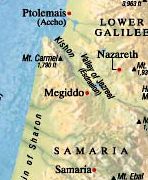
Map with Kishon river in Jezreel valley and
with mount Carmel
|
-- there
is said having developed a steady mental fight with the two
prophets of God, Elia and his pupil Elisa who are said
having migrated in the whole "North Reich"
-- the prophet of God, Elia, is said having claimed from
king Ahab that the prophets of Baal and Ashera should unify
on mount Carmel for a holy fight
-- this holy fight is said having been performed: there is
said having been a sacrifice of a bull on mount Carmel and
God is said having accepted this bull and having eaten this
bull by a fire, but Baal is said not having touched the bull
of the Baal adherents
-- the mob is said having recognized the prophets of Baal as
wrong prophets and is said having killed all prophets of
Baal near the Kishon creek [in Jezreel valley, Bible writes
"Kison"] (p.191):
"But Elia spoke to them [to the mob]: Catch the prophets of
Baal, so there cannot escape anyone of them! And they caught
them. And Elia leaded them down to the Kishon creek and
slaughtered them there." (1st book of Kings 18,39-40).
The holy oracle for Elija is said having prepared the
destruction of "Israel": with Hazael, Jehu, and Elisa
OT claims:
-- queen Jezebel is said having reacted with a great fury
and the prophet of God, Elija, is said having taken the
flight to Horeb mountain, the mountain of God, and there
Elija is said having received a holy oracle (p.191)
-- God is said having uttered the prophecy that the Omri
dynasty will go down (p.191) and is said having ordered to
Elija that Hazael should be anointed as a new king in Aram
Damascus, the most dangerous enemy of the "North Reich"
(p.191-192)
-- add to this God is said having ordered Elija to anoint
the military commander of Ahab, Jehu, as the next king of
"northern Reich of Israel", and Elisa should be proclaimed
as the new prophet (p.192).
Hazael (the king of Amar Damascus), Jehu (the new king of
the North Reich), and Elisa (the prophet of God in spe) are
said to punish the "northern Reich of Israel" for their sins
according to the will of God (p.192):
"Who escapes the sword of Hazael, these should be killed by
Jehu, and who escapes the sword of Jehu, they should be
killed by Elisa." (1st book of Kings 19,17).
According to the stele in Dan there was the occupation of
the town of Dan under king Hazael in 835 B.C. only [so, this
was after the dynasty of the Omrids] (p.196-197).
The alleged siege of Samaria by Aram Damascus - an
alleged victory against Damascus without murder of
Benhadad
OT claims:
-- then, the king of Aram Damascus, Benhadad, is said having
performed an invasion in "northern Reich of Israel" and is
said having sieged Samaria (p.192)
According to archeology this invasion under Benhadad was not
performed in Ahab times, but later (p.194).
-- then, God is said having been merciful and is said having
saved the "northern Reich of Israel" one more time (p.192)
-- God is said having made possible a victory for king Ahab
against the army of Benhadad near the lake of Gennesaret
-- but king Ahab is said not having killed Benhadad but
there was an agreement: Former Israeli town were given back,
and market rights in Damascus was given, and by this Ahab
let Benhadad live, and by this he had violated the order of
God (p.192).
The
prophecy of the coming death of king of Ahab as a
punishment for the clemency to Benhadad: There is an
affair about a vineyard of Naboth
OT claims:
-- prophet of God (prophet of JHWH) Elia is said having
threatened to king Ahab that Ahab will die soon because he
kept Benhadad alive and had not fulfilled the claim of God
killing Benhadad by sword (p.192)
-- now the royal couple Ahab and Jezebel is said having
acted against the population: king Ahab is said having
planned an amplification of his palace and by this he
claimed the property of a vineyard of a certain Naboth, but
Naboth resigned to all offers of King Ahab selling the
vineyard for a good price, because Naboth is said not to be
willing selling the family property
-- then queen Jezebel is said having started a defamation
campaign against Naboth saying that there would be proofs
that Naboth had committed blasphemy, and then Naboth is said
having been stoned under the control of Jezebel (p.192)
-- then king Ahab is said having occupied the vineyard
(p.192).
Prophecy about the death of king Ahab at the same place
where Naboth had been killed - the dogs and the birds -
death of king Ahab and the dogs are licking up it's blood
OT claims:
-- now the alleged prophet of God (prophet of JHWH) Elija is
said having uttered the prophecy to Ahab that he will die at
the same place where the alleged Naboth had been killed, and
the whole dynasty will be eliminated (p.192)
-- Elija claims that dogs will lick up Ahab's blood where
Naboth had been killed (p.192)
-- and also queen Jezebel will be devoured by the dogs on
the wall of Jezreel
-- those family members of Ahab who would die in the town,
would be devoured by the dogs, the other members who would
die on the field, would be devoured by the birds (1st book
of Kings 21, 19-24) (p.193)
-- and then king Ahab is said having been hurt badly in a
battle against Aram Damascus and is said having been brought
to Samaria in his war chariot, and then the dogs are said
having licked the blood near the war chariot, and by this
one prophecy of Elija is said having been fulfilled (p.193).
Bible is "arranged" like this...
852-851 B.C.
Northern Reich of Israel with it's dynasty of Omri: king
Ahaziah is dying by the "wrong faith"
OT claims:
-- now, the son of king Ahab, Ahaziah, is said having been
enthroned in "northern Reich of Israel", and also king Ahaziah
is said having committed heavy "sins"
-- Ahaziah is said having suffered a heavy accident in his
palace in Samaria falling by a grating in his room upstairs
and is said having been suffered heavy injuries
-- then the heavy injured Ahaziah is said having asked the
Baal god Baal-Zebub if it would be possible being cured or not
-- Elija is said having communicated to Ahaziah that he will
die immediately because he he had adhered the Baal god Baal
Zebub, and then Ahaziah is said having died immediately in
fact (p.193).
851-842 B.C.
Northern kingdom of Israel with Omri dynasty: king
Jehoram is in coalition wars with "Judah" and Edom against
Moab
OT claims:
-- the alleged brother of Ahaziah, Jehoram, is said having
been the new king of the "North Reich of Israel"
-- the kingdom of Moab is said having released the cohort
alliance with "northern Reich of Israel" and then king
Jehoram is said having made an alliance with the "southern
Reich of Judah" (under king Jehoshaphat) and with the king
of Edom against Moab and had performed a campaign against
Mohab (p.193).
According to archaeological findings this alliance of
northern Reich of Israel with the king of Edom is hardly
possible because findings for a monarchy in Edom exist only
100 years after the destruction of the Omri dynasty (p.194).
-- the prophet of God, Elija, is said having predicted the
victory against Moab, but only because the "fair-minded king
Jehoshaphat" is also a member of the coalition
-- the towns of Moab are said having been destructed and
Jehoram is said having won with Jehoshaphat (p.193).
Northern Reich of Israel under the Omri dynasty: Hazael
is enthroned as new king of Aram Damascus - and now
follows the ruin of the Omri dynasty
-- since Hazael is enthroned as the new king of Aram
Damascus, the ruin of the "northern Reich of Israel" is said
having been determined: the armies of Hazael are said having
won against the armies of "northern Reich of Israel" in
Gilead in the East of Jordan river, and king Jehoram is said
having suffered heavy injuries (p.193)
-- prophet Elisha is said having sent one of his prophet
followers, and this follower is said having anointed the
army commander of the "northern Reich of Israel" Jehu as a
new king and is said having uttered the prophecy that Jehu
would definitely destroy the Ahab dynasty (house Omri)
(p.193)
-- during the return to the palace Jehu is allegedly said
having killed the alleged king Jehoram by one single arrow
shot in his heart when Jehoram was in the vineyard of Naboth
(p.193-194)
and by this another prophecy is fulfilled, because the king
died at the same place where Naboth was killed. Bible is
"arranged" like this...
ggg-- as a side effect also the king's son Ahaziah was wounded
on his flight and is said having died in Megiddo (p.194).
Northern Reich of Israel under Omri dynasty: The
extermination of the Omri dynasty under supreme military
commander Jehu
OT claims:
-- Jehu is said having ordered that Jezebel would be tossed
out of the window, and it is said that this also had happened
-- the dead body is said having been devoured by the dogs, and
only the head, the feet and the hands are said having been
remained
-- by this another prophecy of Elija is said having been
fulfilled.
Bible is "arranged" like this...
-- Jehu is said having ordered to arrange a burial for the
remnants of the dead body of queen Jezebel
-- add to this it is said that 70 sons of the king of
"northern Reich of Israel" were slaughtered in Samaria, their
heads were put in baskets and were sent to Jehu in Jezreel,
and the heads are said having been piled on two heaps at the
entrance of the city gate by an order of Jehu (p.194)
-- then Jehu is said having exterminated all remaining family
members of Omri dynasty in Samaria, respectively all family
members of king Ahab (p.194)
-- and Jehu is also said having exterminated the worship for
god Baal and is praised in Old Testament for this, but he is
also said that he did not refuse the "sins of Jerobeam"
(p.243) [installing golden calves, see
chapter
19].
23 Documents about the
northern Reich of Israel of Omrid dynasty
The sources of the neighboring
countries prescribing the northern kingdom of Israel of
the Omrids
Now we can compare again the Bible text with the sources of
the neighboring countries:
-- there are monumental inscriptions put into stone in
steles, in monuments, in house walls or in temple walls
-- there are written sources of well developed Assyrian
bureaucracy and texts of some less powerful states in the
Middle East with descriptions of the events of the dynasty
of the Omrids and with descriptions of the events in Aram
Damascus and in Moab (p.195).
Monumental Israeli inscriptions from Israel or Judah could not be found (p.195). It
seems that there is no traditional writtenness in the Jewish
population up to the Omrids (p.195). But according to all
sources the Omrid kingdom of Israel for example had a huge
army as it's described in the Assyrian sources (p.197).
[It seems that the kings of the Omrids had a unilateral
militarism without inscriptions, or archeology has not
excavated the inscriptions yet and has searched at the wrong
places].
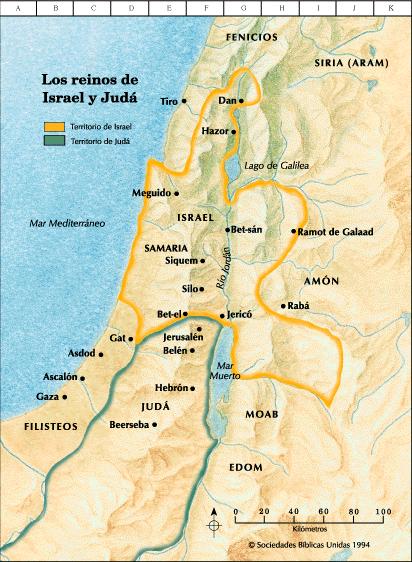
North Reich of Israel of the Omrids could have be like this
for a long time
The stele of king Mesha of Moab in Dibon: Israel is
dominating Moab - followed by a reconquest step by step
According to this stele northern Reich of Israel has
occupied territories of Moab, and then king Mesha of Moab
performed a reconquest.

Map with Dibon, the capital of Moab, satellite photo
Here is the stele of Dibon found in 1868 in the ex capital
of Moab, with a long text in Moabite language (familiar to
biblical Hebrew). The text gives many details:
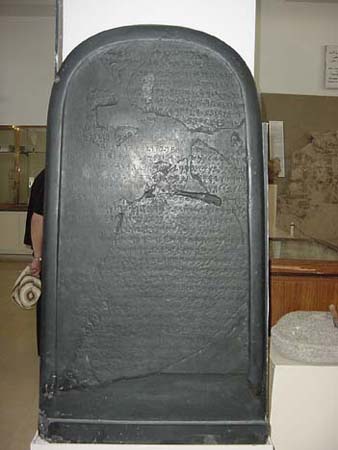
Victory stele of king Mesha, copy of the original
|
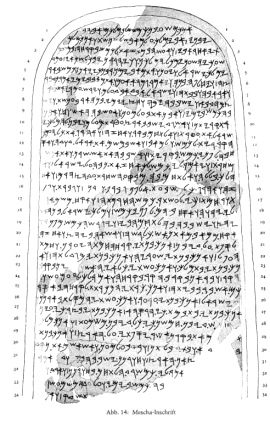
 Victory
stele of king Mesha, the text Victory
stele of king Mesha, the text
|
-- all in all the kingdom of Israel is said having had it's
borderlines up to far in the East and in the South
-- the stele describes the Omrids with the king Omri of
Israel who had "suppressed Moab many days"
"And Omri had occupied the land of Madeba. And he lived in
it. His days and the sum of the days of his sons are 40
years."
-- the successor of king Omri, king Ahab, "his son followed
him, and also he said: 'I will humiliate Moab' "
-- king Mesha of Moab succeeded with a reconquest of the
northern territory of Moab. Then he founded the capital of
Dibon where the stele was found (p.196)
-- the stele describes the achievements of king Mesha: the
reconquest is performed step by step with the destruction of
the Israeli capitals on the East Bank
-- at the same time king Mesha can fortify and beautify the
own capital (p.196).
According to the stele of Mesha king Mesha is mizprising the
Omrid dynasty (p.196).
The stele of Dan: there was an Israeli attack on Assyria
- and Hazael occupied parts of Israel
The peaces of the stele of Dan (with the only indication of
a "house of David") are found in 1993 (p.193).
This stele could be from Aramean king Hazael from Damascus.
The text makes sense when king Hazael of Aram Damascus is
put in as the actor. So - according to Finkelstein /
Silberman - there had been the following scenario (p.196):
-- the king of the northern Reich of Israel is said having
attacked Assyria passing Moab up to the borderlines of
Damascus:
"The king of I[s]rael before [before the military campaign
of Damascus against Israel] stepped on my father's land."
(p.197)
-- so, the northern Reich of Israel has been a colonial
power with an invason up to the borders of Damascus (p.197)
-- the occupation of the town of Dan under king Hazael
follows only in about 835 B.C. [after the Omrid dynasty]
(p.196-197).
The death of king Jehoram
in the war against king Hazael - the completed text of the
stele
According to the interpretation of the inscription of Tel Dan
by Finkelstein / Silberman the death of king Jehoram is not
caused by a vineyard, but is provoked by an Aramean victory of
Aram Damascus with king Hazael [also Hasa'el], and also the
son of Jehoram, Ahaziah, was killed. The completed stele text
in a translation is like this:
"[I killed Je]horam, the son of [Ahab], king of Israel, and
[I] killed [Ahaz]ia, the son of [Jehoram, kin]g of the house
of David. And I made [their towns to ruins and] gave their
land [to be destructed]." (p.221)
But there will never be a safe information, if Jehu or the
king of Aram Damascus, Hazael, was the murderer (p.221).
Assyrian sources: Monolith
inscription from Assyrian Nimrud says the invasion under
Shalmaneser III was a draw
-- in 853 B.C. the Assyrian king Shalmaneser III (858-824
B.C.) is looking for a way to the coast and lets start a big
army against the little states of Aram Damascus,Phoenicia and
Israel
-- at Karkar at Orontes river in western Syria a battle with
the anti Assyrian coalition is held with the strongest parts
of the war chariots from king Ahab from Israel (p.197)
-- according to the monolith inscription of Shalmaneser III
[inscription in one single big stone] king Ahab is one of the
main enemies against the Assyrian dominance in the Mid East
(p.226)
-- Shalmaneser III describes himself as a big winner against
the big coalition
-- but the battle at Karkar reduces the army of Shalmaneser
that much so he is not capable continuing his invasion but has
to return to Damascus (p.197).
There is never mentioned any South Reich "Judah" (southern
kingdom of Judah) or "Jerusalem" (p.198).
Finkelstein / Silberman mean that the dynasty of the Omrids
had the biggest professional army of the region in this time,
and that the policy of dominance of the Omrid dynasty was on a
relatively bad base, with regional rivals and with a constant
danger of Assyria (p.198).
Later Assyrian sources name the northern Reich of Israel even
as "house of Omri", and this is an indication that the new
capital of Samaria really was founded by the Omri family
itself (p.198).
24 Archeology about
northern Reich of Israel under Omrid dynasty 884-842
B.C.
The
Israeli Omrid Reich with an army, gorgeous towns and a
well developed administration - and the Old Testament says
practically nothing about it
-- king Omri is constructing one of the strongest armies
(p.188), a professional army (p.189)
-- king Ahab is achieving a brilliant international
reputation for the Omrid kingdom
-- the marriage with the Phoenician daughter of the
Phoenician king Ethbaal [today's Lebanon] is a diplomatic
maneuver - according to Finkelstein / Silberman (p.188)
-- the Omrid dynasty is building gorgeous towns as
administration centers
-- king Ahab is continuing with the amplification of the
army
-- all in all territories in the North and on the East Bank
are occupied
-- Omri and king Ahab are not "pious", but sometimes they
are even freakish and brutal as all monarchs in the Middle
East are basically (p.188).
All in all the Omrid Reich (Bible says: "kingdom of Israel")
is the first right Jewish "kingdom" with all possible
achievements. The Old Testament conceals this Omrid Reich
(p.189). After the destruction of the Canaanite coastal
towns the rulers of the northern highlands realize their
Empire which has a multiplex character with dominance over
rich agricultural regions and with international trade
routes (p.211). Military, architecture and administration
are well developed in this Omrid Empire (p.214) [but
inscriptions are missing].
But there are other consequences by this amplification of
the Omrid Reich, above all there is a multi ethnic society
-- with Israelite villages in the core land around Samaria
-- with Aramaic Syrian culture in the far North
-- with Phoenician culture at the coast (p.211)
-- the Israeli population stays in the highlands
-- the Canaanite population stays in the Jezreel plain
-- the disposal of the villages does not change under the
Omrids (p.212).
In a parallel way to the rise of the Omrid dynasty there are
Damascus, Phoenicia and Moab trying to extend their power.
So, fortresses at the borderlines are absolutely necessary.
The composed population can be used for agriculture,
building projects and for wars and indispensable (p.212).
Archeology about the Omrid Empire: economic growth by
trade with the Phoenician coastal towns - multiplex Omrid
Empire
The findings with the buildings confirm for the Omrid times
a "Golden Age" of Israelite kings. Bible never mentions this
wealth of the northern kingdom, but only mentions palaces in
Samaria and Jezreel (p.198).
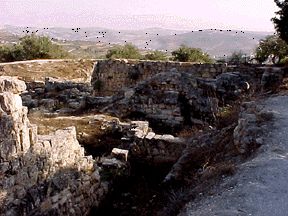
Samaria: ruins of palaces in the northern Empire
of Israel
|
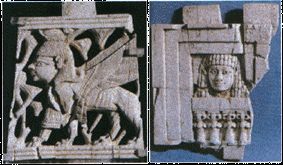
Samaria: ebony reliefs in the palace of northern
Reich of Israel (northern kingdom of Israel),
Egypt style |
The trade relations with the Phoenician coastal towns
[today's Lebanon] are developing in a very intensive way.
Marriage of king Ahab with a Phoenician princess is surely
not just a coincidence. Emerging of many vessels in Cyprus
Phoenician style is only explainable with intensive trade
relations with the Phoenicians (p.213).
The Omrid buildings are similar to those in the Canaanite
capital towns in the Late Bronze Age (p.213).
The excavations of ruins at Samaria are executed from 1908
to 1910 and in the 1930s. The Samaria of the Omri times has
got it's site in an region rich of agriculture on a little
hill. Before the Omrid times this site is a village or a
little town- according to archeology (p.198).
All in all this Omrid Empire is not especially
"Israeli", but is an absolute mixed Empire (p.213). The
historian of the faked OT rates this policy as a "sinful
behavior", and the punishment of the ruin of the dynasty
would be just (p.214). The faked stories in the Old
Testament are systematically concealing the true and proved
history of Israel which is proved by archeology since
decades (p.215).
Archeology did not see the Omrid period for a long time -
big water systems
For a long time archeology said that all palaces in
Palestine would be from the faked king of Solomon (p.202).
For a long time archeology did not see the Omrid period as a
decisive period of Israel. About king Ahab and queen Jezebel
simply was no further research because in the outdated OT
was this "clear" moral stories about them. Only by the new
precise methods of determination of time and by new
archeology [field research and comparing research] the
contradictions between Solomon period and Omrid period can
be solved (p.205), for example in reference to the big city
gates (p.206), and by the cognition of the wrong age
determination the contradictions can be solved (p.205).
The Omrids are said having installed also great water
systems against sieges of their towns. In certain distances
these water systems have shafts for control. Later king
Mesha of Moab also let install big water systems and had
Israeli war prisoners for their construction (p.204).
Eventually the water systems have to be dated in a later
period (p.209).
25 Acropolis
buildings of the Omrids
about 880 B.C.
Reconstruction of Samaria as an acropolis in the Omri
period
[Further names for Samaria are Sebaste, Sebastia, Sebastiya,
Sebastiyeh, Sebastos, Sebustiyeh, Shamir, Shomeron, or
Shomron].
Omri lets destroy and flatten the village respectively the
little town of Samaria and lets build his palaces. Around
the hill a big circular wall is constructed, in "casemate
technique" (casemate chambers filled with earth mitigating
the pressure of the filling). The inner space around the
hill is filled with earth (p.199).
According to archeology the central building of the palace
had alone about 2000 m2,
-- with architectonic ornaments
-- with similar to Aeolian stony capitals ("proto Aeolian")
(p.199)
-- with monumental city gates (p.201).
There is coming out an acropolis. The houses of Samaria ware
along the slopes outside of the acropolis (p.201).
[There is the question where the acropolis technique comes
from, and what copy the acropolis of Athens is e.g.].

Samaria: Acropolis, ruins
from 880 B.C. on appr.
The Omrid reconstruction of the town of Megiddo as an
acropolis
Also the town of Megiddo is reconstructed as an acropolis
-- with palaces in the North and in the South like in Samaria
(p.201, 208)
-- the palaces are built in a stony block technique, but
without casemate installations (p.207,208)
-- both palaces are in a North Syrian style of bit-hilani
(p.207), the southern palace has got capitals similar to
Aeolian style ("proto Aeolian") (p.208)
|
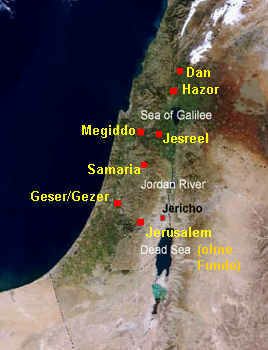
Map with
the acropolis towns reconstructed under the
Omrids: Megiddo, Gezer, Hazor, Dan and Jezreel.
There are no findings for Jerusalem in these
times.
|
ggg-- the layout of the town is similar to the one of Samaria,
with a huge town wall with a four chamber gate (p.202)
-- Megiddo has got a deep spring of fresh water in a cave, and
the cave's entrance is locked by a wall and concealed (p.204).
The palaces in Samaria and Megiddo have the same seal of
stonemason (p.208).
The Omrid reconstruction of
the town of Hazor as an acropolis
-- Hazor is built as a huge fortress (p.202), as an acropolis
with casemate wall, with a large ditch U(p.207)
-- on the platform of the acropolis was installed a three
pointed building complex in stony block technique, really
Omrid style (p.207)
-- Hazor had a great water system torn through the rocks and
was prepared against any siege (p.202): The rocky chamber is
as deep so the groundwater is coming out (p.204).
The Omrid reconstruction of the town of Dan as an acropolis
-- with a huge fortress
-- with a great and elaborated city gate
-- with a holy place of the Omrid period on a platform
-- with further monumental buildings of the Omrid period
-- with a great water system torn through the rocks being
prepared against any siege (p.203).
The Omrid construction of the town of Jezreel as an
acropolis - this is a good example
Jezreel is only excavated in the 1990s. The basic walls of the
ruins have got the layout as in Samaria with an enormous
casemate wall, with a filled territory with a palace on it,
with large ditches (p.206) and with one single great city gate
(p.206-207). But according to archeology the town of Jezreel
is inhabited only for a short time, and after the Omrid period
is soon destroyed (p.206).
For archeology Jezreel is a lucky chance because this town
precisely existed only during the Omrid period. By this, the
style is exactly datable and is a criterion for other towns.
Ceramics are quasi identical with the ceramics of the palace
of Megiddo. In this way there are comparisons and it's proven
that the town of Jezreel is from the Omrids (p.207).
The palace of Jezreel is kept as a little town for some time.
The definite destruction could have been in connection -
according to Finkelstein / Silberman - with the rebellion of
Jehu or with the later Syrian invasion under Hazael (p.222).
The Omrid reconstruction of the town of Geser as a "half"
acropolis
-- has got an an artificial terrace on the slope with a
filling
-- has got a palace with a six chamber gate, in stony block
technique, in connection with a casemate wall (p.208)
-- the palace had capitals similar to Aeolian style ("proto
Aeolian") (p.209).
Omrid buildings outside of the origin city state of Shechem
For a complete overview of the buildings of the Omrid Reich
one has to investigate also remnants of the Omrids outside the
core Reich. Mesha stele of Moab reports for example that king
Omri had two towns built in Moab,
Ataroth and
Jahaz.
According to Finkelstein / Silberman these frontier
fortifications in today's Jordan (p.209).
The Omrid buildings in the East Bank are hardly excavated
until today. Ataroth is said to be
Tell Chirbet-Atarus in the South West of
Madeba in Jordan, Jahaz
has not been found yet. Eventually it is the ruin of
Chirbet el-Mudeyine
(p.210).
In Jordan many fortresses are yet in the sand which could be
outposts of the Omrids, eventually more distant as admitted
until today (p.210).
26 Arab trade gets a
primary factor for war or peace in Middle East
The trade routes provoking
new wars
For the powers in the Mid East - not important which it is,
Assyria, Mesopotamia, Babylonia, or Persia - now is growing
a profitable Arab trade. So, these trade routes become one
of the main criterions of policy now. Safety and
disponability of the trade routes have first priority for
the Empires of the Mid East (p.288).
Gaza for example is rated as a customs zone of Assyria -
that is said in a victory inscription of the Assyrian king
Tiglath Pileser III. Gaza is the traditional terminal
station of the desert routes where the caravan routes are
coming together (p.288).
27 North Reich between
Omrid dynasty and Assyrian occupation 842-720 B.C. -
destruction of northern kingdom of Israel
Assyria is standing before the
city gates...
 |
Map: Israel,
Judah, Aram Damascus, Phoenicia, Ammon, Moab,
Edom.
-- Moab is independent from Israel since 843 B.C.
-- territories in a light red are occupied by
Assyria from 850 to 722 B.C. (occupied are Aram
Damascus and Phoenicia)
-- the yellow territories are occupied by Assyria
in 722-721 B.C., kingdom of Israel
-- territories drawn in a dark red are territories
devastated by Nebuchadnezzar in 587-586 B.C.
(kingdom of Judah).
|
OT claims:
-- OT invents an "disloyalty to God" finding a cause for
suffering, expropriation and at the and a ban
-- for the collapse of the North Reich of Israel there is
invented an disloyalty to the temple in Jerusalem, and this
disloyalty would have had provoked one catastrophe after the
other and by this the self destruction of the Reich of
Israel would have had favored
[whereas there cannot be found any remnants of the temple of
Jerusalem for the Omrid period]
-- there is said that alleged prophets had warned in vain of
an disloyalty to the temple of Jerusalem
-- there is said that the invasion of foreign armies and the
devastation of the North Reich of Israel had been a part of
a divine theological plan (p.216).
The archaeologists believe for a long time in a continuity
without developments and by this neglect any investigation.
Proofs for great changes and military defeats have not been
taken earnest for a long time (p.220).
The northern Reich of Israel under the Omrids develops a
prosperous society with all it's strong sides, weak sides,
and tensions, and the wealth of the "North Reich of Israel"
is attractive for certain elements in Assyria (p.216).
[Addition: Independence in
this region is a big exception
Considering the geographic position of Israel and Judah as a
territory which is always fiercely disputed between the
great Empires of Mesopotamia and Egypt, so an independence
seams to be a great exception, and it was a big exception
that there was any independence for a certain time at all].
842-814 B.C.
Northern Reich of Israel with king Jehu: There comes an
invasion under Hazael
OT claims:
-- idolatry under the king Jehu had risen on and on
-- also king Jehu is said never having considered Jerusalem
as a cult center.
Well, according to archeology Jerusalem was no town until
this point of time and there was no temple at all then...
-- king Jehu is said - as a "good deed" - having performed a
cleansing against the cult of Baal organizing a Baal
festival and encircling the visitors an slaughtering them,
and the temple of Baal is said having converted into a
"latrine" respectively a toilet complex (2d book of Kings,
10,18-28)
-- but king Jehu is said having continued with the "sins of
Jerobeam" going on adoring the golden calves in Bethel and
Dan (2d book of Kings 10,29): The own centers of cults are
not eliminated, so that the competition to Jerusalem is
going on (p.217).
But according to archeology Jerusalem was not at all a
center of any cult in this time...
-- Got is said having uttered the prophecy to king Jehu that
from his gender will rule only four generations (2d book of
Kings, 10,30) (p.218)
-- the plan of God shall be that the northern kingdom of
Israel should be punished by an invasion of Aram Damascus:
king Hazael of Aram Damascus is said having defeated the
Israeli armies in the East Bank and in the coastal plain (2d
book of Kings, 10,32-33; 12,17-18; 13,3,7,22) (p.217)
-- according to OT this is the first invasion against Israel
since the conquest under Joshua (p.222)
-- the territories of the northern Reich of Israel are said
having been reduced by the occupation under Hazael
-- and the normal population is said having kept loyalty to
God (2d book of Kings 13,23) (p.217).
The documents and the
excavations of the time under king Jehu speak: there was an
invasion of Aram Damascus under king Hazael in northern
Israel
According to the stele of Dan already
king Jehoram is killed by king Hazael (p.221), and Hazor and
Dan are said having belonged initially to Aram [the country
of the Arameans] (p.224). The occupation of the town of Dan
under king Hazael comes in 835 B.C. (p.196-197). According
to the stele of Dan these invasions were weakening Israel
decisively (p.221).
Assyrian sources also give a report about the invasion of
king Hazael in the West and in the South down to the
northern kingdom of Israel. Hazael can perform this invasion
only because Assyria is occupied with own rebellions in its
interior (p.225).
Hazael replaces Sheshonk
When there is considered a dating of Solomon the invasion of
Hazael with it's destructions cannot be found in the layers
(p.221). But when one considered the changing of dating with
the allocation to the Omrids - considering that the city
gates are not from the invented Solomon but from the Omrids,
so all data get their correction: Not Sheshonk was the
destructive force at the end of 10th century B.C., but
Hazael was it in 835 B.C. (p.223). In this way many layers
of destruction can be explained in the town hills. The new
dating lets fall the layers of destruction to Hazael
(p.223).

Map with Beth Shean, Rehov, Megiddo and Taanach, satellite
photo.
835-806 B.C.
The destruction of northern Reich Israel north of Samaria
by the invasions of Hazael from Aram Damascus
As always the wars are for fertile soil for agriculture in
the western "crescent":
-- king Hazael has the Aramean territories in the East Bank
occupied
-- king Hazael has some of the most fertile agricultural
regions of Israel devastated (p.222) with pillage of the
rich valleys in the North, the valleys from Tel Rehov to Beth Shean, Taanach and Megiddo (p.223)
-- also great Israeli administration centers in the plain of
Jezreel are destroyed, eventually also the town Jezreel
itself (p.222)
-- king Hazael has the trade routes interrupted (p.222).
Some locations never recover completely again (p.223). But
all in all the armies of Hazael can only destroy the region,
but cannot perform an occupation (p.223).
[And as it seems Samaria is kept untouched. The invasive
armies can be stopped before].
But according to new archeology Aram Damascus under king
Hazael 835-800 B.C. can occupy decisive territories at the
end:
-- the upper Jordan valley
-- and key territories in the North of northern kingdom of
Israel (p.222).
The period without population in some towns
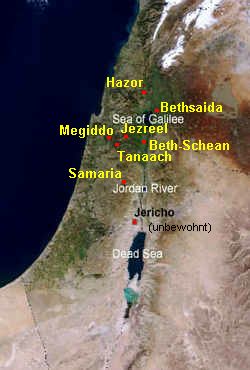
Map with Beth-Shean, Megiddo, Jezreel, Tanaach and Samaria.
The regions of the plain of Jezreel and the
region of the bay of Beth
Shean have no populations for some decades and are
running down (p.223). Megiddo
for example, the administrative center in the North of the
northern Reich is kept lost for almost 50 years (p.223-224).
So, there was possible a destruction of this region, but
there was no annexation. The towns of Jezreel and Taanach never reach
their significance they had before (p.223).
Fortification works under king Hazael of Amar Damascus
Amar Damascus achieves putting forward it's borderline
(p.224), and this borderline receives it's border marks:
Fortress of Dan:
Hazael's victory stele of Dan indicates that Dan was
occupied as it seams and the victory stele was erected only
when the town was totally reconstructed presenting the
dominance in that spot. Dan is reconstructed immediately,
with massive town walls. There is an Aramean cult with a
horned god now probably (p.224).
Fortress of Hazor:
Hazor also is reconstructed immediately because this
strategic center should function. On the acropolis was built
a new town, with a new massive town wall, with a new palace
or citadel, and eventually only now the big water system is
installed. There is an Aramean cult with a horned god now
probably (p.224).
Fortress of Bethsaida:
The fortress at the Lake of Gennesaret is reconstructed.
Archeology can find a basalt stele there with a picture of a
horned god, probably from the Aramean culture (p.225).
According to archeology the populations are Aramean before
and after the occupation by Aram Damascus. There is no
settlement of foreign deportees (p.225).
Jehu gets the status of a vassal and has to bow himself
to king Shalmaneser III on the "black obelisk"
King Jehu also is painted on the "black obelisk", the
obelisk of the main chef of Mesopotamia, the Assyrian king
Shalmaneser III. Jehu is presented in a position of a deep
bow before Shalmaneser, and has to pay tributes which are
counted by Shalmaneser:
The text of the stele: "I got from him silver, gold, a
golden bowl, a golden vase with a pointed bottom, golden
cups, golden buckets, tin, a stick for a king." (p.226)
So, northern Reich of Israel is a vassal of Syria now
(p.226).
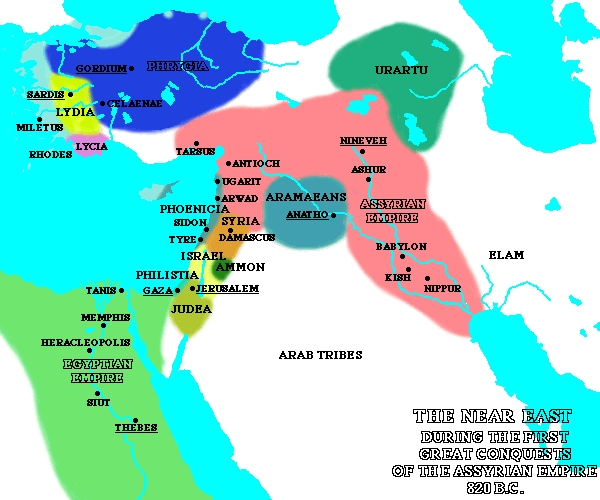
Map: Assyria, Syria and Israel in 820 B.C.
814-800 B.C.
Northern Reich of Israel under
king Jehoahaz
OT claims: Jehoahaz is a son of Jehu (p.217)
Documents and archeology for the time of king Jehoahaz
say: Assyria is occupying Syria - and Israel is recovering
According to the documents and to archeology Syria is now
directly occupied, and Israel can recover from the
occupation of Aram Damascus and a new period of growth can
begin. The Bible is concealing this.
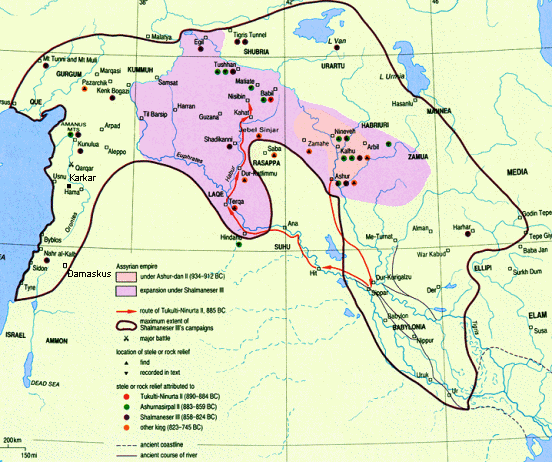

Map: Assyria under
Shalmaneser III. This is a huge "crescent"...
Details:
811-783 B.C.
Enthronement of Adad-Nirari III in Assyria
(p.225)
since 806-770 B.C.
The son of Hazael, Benhadad III,
probably sieges Samaria
Benhadad III probably has continued with the invasions
against northern Reich of Israel, at the end with a siege of
Samaria. According to Finkelstein / Silberman the dates of
the Bible with its indication of a siege of Samaria in the
time of the kings of Ahab and Jehoram is much too early
(p.223).
When there was an occupation of Samaria, so it could be that
the core land of northern Rich of Israel has been suffered
an Aramean Syrian occupation for some time (p.223).
The relation to Hazael is only possible with a change of
dating from the Solomon allocation to an Omrid allocation
(p.223).
803 appr.
Assyria destroys Aram
Damascus - and this means a recovery for Israel
-- Adad-Nirari III of Assyria is renewing the pressure and
has Damascus besieged
-- Barhadad III of Aram Damascus has to surrender and has to
pay a high tribute to Assyria
-- with this Israel is liberated from the pressure of
Damascus and gets new possibilities for new, own
developments (p.225).
Archeology can confirm this development (p.226).
The events according to the reproaches of the historians of
the OT, that there was a "godlessness" which caused the
occupation, and that there was a "mercy" provoking the
liberation, is an absolute fake and finds its explanation by
the events in the neighbor states (p.226).
800-784 B.C.
Northern Reich of Israel under king Jehoash: reconquests
OT claims:
-- king Jehoash is said having organized new expansions and
had occupied the towns of Aram Damascus (2d book of Kings,
13,25) (p.217)
-- king Jehoash is said having organized a punitive action
against Judah (p.218).
Documents say about king Jehoash: There is a new rise and
there are reconquests
But the historian of the OT describing the political
change and stating the reason of God's mercy has forgotten
some documents as it seems: Israel becomes the most favored
vassal, and in the northern Reich of Israel wealth is
growing again (p.226).
788-747 B.C.
Northern kingdom of Israel under king Jeroboam II
OT claims:
-- king Jeroboam II is said having ruled in peace in Samaria
(p.218)
-- he is said having organized more expansions (2d book of
Kings, 14,25 and 28)
-- but all "sins" are said having continued which had
committed the "first Jeroboam" because the holy places of
the "northern Reich" are maintained (p.218)
-- and the prophets Amos and Hosea allegedly are said having
warned of disloyalty to God (p.218).
But according to archeology Jerusalem does not exist yet...
Alleged corruption under Jeroboam
II: there are charges of the God's prophets Amos and Hosea
- and there comes a "1 god movement" with texts of
prophets
OT claims:
There are God's prophets protesting against luxury. These
are recordings of the prophets Amos and Hosea, and they have
survived originally. These texts claim a big corruption and
a godless aristocracy how the upper class is organizing
luxury by corruption (p.233).
Amos and Hosea - like Elia and Elisha - represent a "1 god
belief". They insist that only one single god should be
adored (p.268).
Amos and Hosea also present the idea of a revenge of God,
and this idea will be imprinting after the ruin of the
northern Reich of Israel in the ideology of Deuteronomy in
southern Reich Judah (p.233).
God's prophet Amos:
According to the book of Amos he is a shepherd from the
Jewish village of Tekoa and is changing his domicile from
the southern to the northern Reich. His oracles are a sharp
damnification of luxury and of materialistic northern Reich
of Israel (book of Amos 6,4-6) (p.233).
God's prophet Hosea: Hosea deplores lies and violence
increasing daily, and deplores the alliance with Assyria and
the trade policy with Egypt (book of Hosea 12,2) (p.233).
Amos and Hosea are denouncing
-- cases of social injustice
-- idolatry
-- inner tensions by international trade
-- the dependence from Assyria ("Assur")
-- the simulation of following religious laws, but every day
there are bad actions and richness is compiled, and the poor
are defamed (p.234).
The new 1 god movement
According to Finkelstein / Silberman the followers of Amos
and Hosea represent the origin of the "1 god movement"
(p.268). Their followers beware the texts of the prophets
(p.234) with the sermons against injustice in the northern
Reich of Israel. These texts are the base of the "1 god
movement" (p.268). The movement is waiting for the collapse
of the northern Reich of Israel. After the collapse of the
state they want to take action against wealth and against
foreign kind of living and against foreigners [in a racist
way] (p.234).
[Addition: these prophets have a senseless and racist
thinking of scapegoats
Stupidity blaming certain groups of humans for situations of
tensions of for the "collapse" of a state is obvious:
Foreign belief is said to be the cause of certain bad states
of affairs. But bad states of affairs are not cleared by
intolerance, but by change of structure in the state's
apparatus. This fault also is committing "Christianism"
later against the Jews, or movements in Asia against the
Chinese, in the "USA" the white racists against Chinese and
against Japanese etc.].
Documents and archeology
speaking about the time of king Jeroboam II: There is an
expansion and wealth and much corruption
Reconquests under Jeroboam II
Assyria accepts the Israeli reconquest
of the East Bank:
-- king Jeroboam II organizes the reconquest on far Aramean
territories (p.227)
-- in Dan the victory stele of Hazael is destroyed and the
pieces are used for the construction of Israeli buildings
where they are found 2000 years later by archaeologists and
are composed again (p.227)
-- in Bethsaida the Israelites find a stele with a horned
god in Aramaic style turning this stele by 180 degrees and
installing it on it's top (p.227)
-- Hazor is destroyed by the Israeli troops and then is
reconstructed in an Israeli style, whereas here can be
states Hebrew inscriptions the first time (p.227).
Wealth under king Jeroboam II
King Jeroboam II can compile a "wealth beyond example"
(p.226). The royal dynasty under Jeroboam II has a
cosmopolitan political line (pl.232-233). It's Israeli
aristocracy is compiling a great richness and is living in a
great luxury. For example furniture in the king's palace
have got ivory elements (p.232). Writing and reading is
widespread and by this also a bureaucratic administration
and a professional army are possible. And economy is
specializing (p.233).
Historiographers of OT declare that this wealth would be a
sudden "mercy" of God without mentioning the collapse of
Aram Damascus (2d book of Kings 14,26-27).
But the facts do not at all indicate a certain "mercy of
God", but there are real capital concerns between Assyria
and Israel because it can be admitted that Israeli economy
can take part in the Assyrian world wide economy and by this
there was new streams of cash (p.227).
Wealth under Jeroboam II:
Export of olive oil and wine
King Jeroboam II develops a strong economy and a strong
agriculture with a specialized industry of olive oil. There
is a great growth of the population and new villages and
towns are founded on cliffs in regions with olive cultures.
In olive farms are founded specialized villages. Olive miles
are installed in the rocks and other machinery is installed
processing the olives, installed in the rocks. The olive oil
is exported to Assyria and to Egypt, with high profits,
because in Assyria and Egypt the conditions for the
cultivation of olives are missing (p.227).
In the same manner is installed the cultivation of vineyards
(p.227-228).
The explosion of the population in the agricultural interior
is going on up to the end of the 8th century B.C. According
to area-wide archeology and ethnographic estimation the
region of the northern kingdom of Israel becomes the region
with the densest population of wholeFertile Crescent
(p.228).
[Addition: Probably the profits by olive oil and wine were
that great so many persons were attracted from abroad, or
there were special laws for big families].
Wealth under Jeroboam II:
Population boom, strong army, and architecture
The population boom also is the the base for the troops and
for building activity, for the reconstruction of Megiddo,
Hazor, Geser (strategical an important town on the border line
to Philistine) etc. (p.229).
It seems that the historian of the OT had assigned this
building activity under Jeroboam II to the faked Solomon
(p.229-230).
Under king Jeroboam II first king's
seals are produced (found in Megiddo in the 20th century)
with a yelling lion and with Hebrew inscriptions, whereas
the logos of the seals with a lion are typical for the 8th
century and by this it can be excluded that they are from
Jeroboam I of a time before (p.229).
Speculation about buildings
in Megiddo similar to cattle sheds
According to the new manner of dating with the Omrids
the buildings similar to cattle sheds in Megiddo were built
under Jeroboam II. There is no purpose found until today
because no remnants of animals have been found. The claim
that the buildings were a center for horse breeding for the
export of horses as war material seems to be nothing but a
speculation. But Assyria mentions the exportation of horses
by it's vassal states (p.231) as it has happened for example
in Anatolia in the vassal state of Urartu where similar
buildings could be found (p.232).
Southern Reich of Judah is
envying the wealth in northern Reich of Israel
According to Finkelstein / Silberman it can be admitted that
the population in Judah (Jerusalem) knew about the wealth
under Jeroboam II and there was a certain envy (p.229).
747 B.C.
Death of Jeroboam II - the northern Reich of Israel is
mentally empty
The structure of northern Reich of Israel is mentally empty.
[It seems that Jeroboam II has not arranged an order of
succession]. Finkelstein / Silberman admit that after the
death of Jeroboam II groups in the administration were
formed, with high militarists and mafia. Many kings are
following being murdered after relatively short time by
upheavals (p.234). At the same time there are massive
changings in the Mid East (p.234-235).
[Assyria is preparing the ocupation of the northern Reich of
Israel because it's not stable any more. Therefore the
collapse of teh northern Reich of Israel does not at all
come from God and not at all is a singular case. Southern
Reich of Judah is not affected by the invasion because the
traffic routes are very steep and the position is not so
favorable not blocking any traffic routes].
747 B.C.
Northern Reich of Israel: king Zechariah, son of Jeroboam
II
OT claims:
King Zechariah is said having ruled only for 6 months and
then had been murdered by an envier. The alleged prophecy of
God that only four generations of Jehu's gender will rule is
allegedly fulfilled by this (p.218).
In that manner the Bible is "arranged"...
747 B.C.
Northern Reich of Israel
under king Shallum
OT claims:
The murderer Shallum is said having ruled only for a short
time and is said having been murdered by an envier Menahem,
the son of Gadis (p.218).
747-737 B.C.
Northern Reich of Israel under king Menahem
OT claims:
-- God is said having prepared more punishments for northern
Reich of Israel: the armament of Assyria and the extortion
for tribute to Assyria
-- paying more tribute to Assyria Menahem is said having
risen the taxed of the upper class: "50 silver shekel" (2d
book of Kings 15,19-20)
-- northern kingdom of Israel has become absolutely
instable, in it's inner and in it's policy of foreign
affairs (p.218).
Documents and archeology speak: king Tiglath-Pileser III
of Assyria
[other writings are also Tiglat Pileser, Tiglath-pilesar,
Tiglatpilesar, Tiglat Pilesar].
745 B.C.
Assyria suffers a coup of power of Tiglath-Pileser III -
and the vassals are controlled directly now
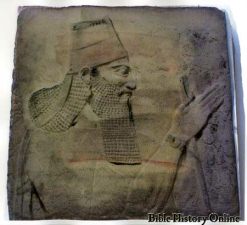
Tiglath-Pileser III, profile, location of the finding was
Nimrud.
Tiglath-Pileser III is a brutal
governor of the town of Kalach (Nimrud) in Tigris valley.
Step by step he is converting Assyria into a brutal rogue
state. The relations to the vassals are abrogated and the
vassals are controlled directly (p.235).
738 B.C.
Assyria: Military campaign
of Tiglath-Pileser III against their ex vassals in the
West
Now one ex vassal after the other is conquered by the
Assyrian army and is extorted to tributes as never before.
This is the beginning of a new Assyrian Empire. Step by step
the ex vassals are occupied and the populations are deported
(p.235).
Some time - only some pretext is needed - it's the turn of
northern Reich of Israel. That is not any divine punishment,
but this is military calculation...
737-735 B.C.
"Northern Reich of Israel"
under king Pekahiah, the son of Menahem
OT claims:
-- king Pekahiah is said having been murdered in 735 B.C. by
the officer Pekah
-- and Assyria is said having planned the occupation of
Israel (p.218)
735-732
"Northern Reich of Israel" under king Pekah, son of
Remalya
(p.235,239)
Documents and archeology speaking about king Pekah: A
coalition with Damascus (under king Rezin) cannot be
formed - and then follows the Assyrian occupation down to
Samaria
Until now the activities of king Pekah are a mystery. He ends
the surrendering policy to Assyria, perhaps by defiance
because the tributes were too high. Pekah begins a game of
power against Assyria with different coalitions, among others
with king Rezin of Damascus or with the Philistine towns. King
of Pekah and Rezin hope that a common resistance can be formed
against the Assyrian aggression (p.235).
But the coalition fails, and
Tiglat-Pileser who is informed about these coalition plans
is reacting with anger:
-- Tiglath-Pileser has Damascus occupied and king Rezin
executed (p.235)
-- before the arrival of the invasion the fortification of
Hazor for example is more fortified yet, but in vain, and
then it is destroyed massively like also Dan and Beth-Shean
(p.237)
-- Tiglath-Pileser is performing his military campaign up to
the Mediterranean and than along the coast and has all
rebellion towns destructed (p.235) interrupting the
connection between the Middle East and Egypt (p.235-236)
-- the next step will be the occupation of a big part of
northern Reich of Israel, and the most important towns are
destroyed and the population is deported (p.236).
Of Megiddo only the residential districts are destroyed, but
the stones of the column houses are reutilized for the
construction of a first administration center and a new
capital which will be the see of the governor (p.237).
In this case it seems that the OT and the facts are the
same:
732 B.C.
According to OT Assyria under Tiglath-Pileser III is said
having occupied the northern valleys and Galilee
The Assyrian occupations are: Jion, "Avel-Beth-Maacha, Janoah, Kedes, Hazor,
Gilead and of Galilee the whole region of Naphthali" (2d book of
Kings 15,29), and the population is allegedly deported
(S.218).
Reich of Israel is said having lost a part of it's
territories and is said having limited to the highlands of
Samaria (p.219).
Old Testament is rating the occupation now as a moral
"punishment of God": The faked prophecy of 1st Moses 15,18
with it's Israeli borderlines from Nile river to Euphrates
river is said having been abolished by the "sins" committed
before (p.219).
For this catastrophe king Pekah is said having been murdered
by Hosea (p.219).
Documents and archeology speaking about the Assyrian
occupation regime in ex northern Reich of Israel with the
exception of Samaria region
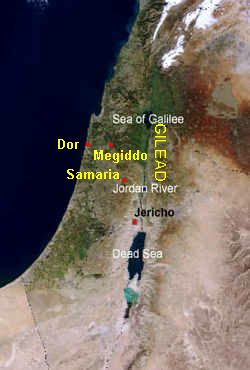
Map with Dor, Megiddo, Gilead and Samaria
The ex Reich of Israel is parted in new
provinces:
-- Dor (with the
northern coast)
-- Megiddo (with
the Jezreel plain and with Galilee)
-- Gilead (with the
highlands of the East Bank) (p.236).
Here is a relief from the times of Tiglath-Pileser III
showing the siege of Gaazru, probably Geser (p.236).
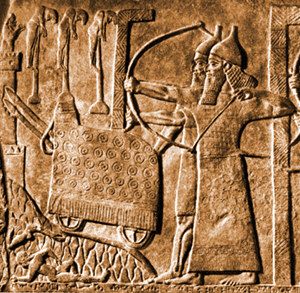
Tiglath-Pileser's army sieging Gazru with storm vehicles and
bowmen
This gypsum relief is from
the ancient Assyrian palace at Nimrud, the capital city,
depicts the utter destruction of the city of Gazru by
Tiglath-pilesar III’s mighty Assyrian army. It is now at the
British Museum. Notice the powerful battering ram to
bring down the walls, at the top left are three men who have
been impaled on spiked poles [web01].
From the northern Reich of Israel only remain the highlands
of Samaria. Monumental inscriptions of Tiglath-Pileser III
are testimony of these events, with a specialmention of the
safed Samaria (p.236).
The deportations are used for the continuing development of
the own Reich. Any destruction of a site and any deportation
is one more an intimidation. Prisoners of war are drawn to
military service, deported craftsmen are used for works in
the center of the Assyrian Empire promoting wealth there
(p.236). Settlements in empty regions are amplifying
agriculture (p.237).
[Also Stalin did it like this...]
The chronological descriptions of Tiglath Pileser III
mention 13.500 deported Jews. Archaeological investigations
confirm the fact that whole sections of lower Galilee
have been without any population for decades in this time
(p.237).
Megiddo is reconstructed in an absolutely new lattice-like
layout. At the left and the right side of the city gate
palaces are built in a typical Assyrian style. The
residential quarters are built in lattice-like blocks. This
layout was unknown in Fertile Crescent until this time
(p.237). Finkelstein / Silberman admit that in these block
like residential quarters Mesopotamians were settled
(p.240).
The Israelite "island" of
Samaria
Samaria is spared of the Assyrian occupation for some time,
but not for a long time any more (p.240).
732-724/722 B.C.
Northern mini kingdom of
Israel under king Hosea: rebellion conspiracy
OT claims:
-- in Assyria king Shalmaneser V is said having taken the
power and is said having installed an imperial policy
-- king Hosea is said having surrendered as a loyal vassal
having offered tribute, but clandestinely had aimed for an
alliance with Egypt for a successful rebellion
-- the Assyrian king Shalmaneser V is said having been
informed of this maneuver of Hosea and then Hosea is said
having been seized ant the rest of the northern Reich of
Israel is said having been occupied whereas the occupation
of Samaria is said having required three years of siege
(p.219)
-- OT claims about king Hosea: Hosea "did what displeased to
the Lord", but it was not so much than the other kings did
before (2d book of Kings 17,2) (p.243).
Documents and archeology are speaking about king Hosea
End of 8th century appr. / 730 B.C. appr.
There are numbers of population according to Finkelstein
/ Silberman
These population figures are estimations according to
archaeological territorial research and demographic research:
-- mini northern kingdom of Israel has appr. 350,000
inhabitants
-- kingdom of Judah has almost 100,000 inhabitants
-- the kingdoms of Ammon and Moab together have appr. 100,000
inhabitants (p.229).
727 B.C.
Death of king
Tiglath-Pileser III and interregnum with a weak period of
Assyria - the trial of conspiracy of king Hosea with Egypt
King Hosea of Samaria means that he could start a rebellion
in the weak time of Assyria after the death of
Tiglath-Pileser when king Shalmaneser V is not enthroned
yet. So, king Hosea has contacts made with the army of Egypt
in the Nile Delta with the aim to arrange a coalition
against Assyria hoping that Egypt will attack Assyria now.
At the end king Hosea even stops it's tribute to Assyria
(p.240).
The destructive campaign of
Assyria under Shalmaneser V against mini northern kingdom
of Israel - securing trade roads
The new king in Assyria, Shalmaneser V, is reacting against
the rebellious conspiracy with a campaign of destruction
against Samaria and with it's siege. It's not sure if
Shalmaneser can see the storming yet (p.240).
At the same time the northern mini Reich of Israel is not
only an "attractive goal" (p.245), but also the trade roads
in the Middle East between Mesopotamia and the Mediterranean
coast and Arabia have to be secured because otherwise they
would be in Egypt hands affecting and destructing badly a
big part of the Assyrian trade connections (p.288-290).
Successor in Assyria is king Sargon II, and the kingdom of
Judah is not interesting with it's geographical isolated
position is not interesting for him (p.250).
724 B.C.
Samaria with collapse, deportation and resettlement under
king Shalmaneser V
OT claims:
-- the Assyrian king Shalmaneser V is said having sieged
Samaria for 3 years
-- Shalmaneser V is said having deported the population to
Halah and to Habor river in Gosan [Tell Halaf] and to the
towns of the Medes (2d book of Kings 17,6)
-- the alleged 10 tribes of the North are said having
eliminated by the deportations
-- Shalmaneser is said having settled people from
Mesopotamia in the conquered northern Reich of Israel,
people from Babel, Kutha, Awa, Hamath, and from Sepharwaim,
above all in Samaria (2d book of Kings 17,24)
-- and now - in this way is claiming the OT - the "kingdom
of Judah" is said to be obliged to redeem Israel from the
occupation (p.219)
-- OT claims that the occupation of the whole northern Reich
of Israel with it's invaders from outside had been a
punishment for the "sin" of idolatry in the northern Reich
(p.21).
The collapse of Samaria according to documents and
archeology
In 722 B.C. Sargon II is enthroned in Assyria. It can be
that Sargon II and not Shalmaneser V is witness of the
storming of Samaria and executing the deportations. Sargon's
chronicle is reporting in details about the prey with 27,280
persons, war chariots and with the gods of the population
(p.240).
Assyria: Sargon II.
|

Sargon II, profile
|
This limestone
relief of Sargon II comes from the town of
Khorshabad (under Sargon called Dur Sharrukin) and
has a height of tree feet. Here he has got a neo
Assyrian crown. See the colored bands, the braided
hears and beard, and the earrings. Today this
relief is in the Egizio Museum in Turin [web02].
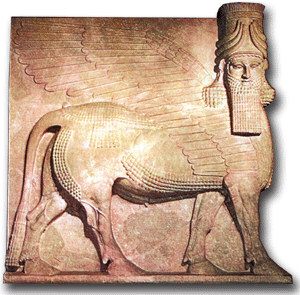
Sargon II: palace figures: winged horse with a
human head
This winged
being (Lamassu) was found in the palace of
Sargon II in Dur-Sharrukin (today: Kohrsabad)
on the right side of the entrance to the
throne hall. The statue is 14 feet high. There
were four such statues on each side and there
were two head opposit to the other ones as if
they would look to each other. There was the
belief that Lamassu could safe the palace from
demons. Today this statue is in the Oriental
institute of Chicago [web03].
|
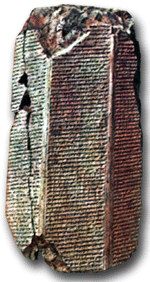
Sargon II, the inscripcion about the victory against
Samaria and the deportations
|
|
This V-block of clay contains an
Assyrian inscription in cuneiform inscription
corresponding to the biblical context in
reference to the military campaigns and
deportations in northern mini kingdom of Israel
in 722 B.C. The inscription prescribes the 8th
campaign under Sargon II in Syria and the
revolts in Samaria, the former capital of
northern Reich of israel before and after
Sargon's military campaigns. The Assyrian
inscription depicts also Sargon's bluff: "I
sieaged and conquered Samaria, and I deported
27,290 of the inhabitants as my prey." (see the
Bible, 2d book of Kings, 17,5-6). This cuneiform
inscription is dedicated to god Ashur. Today
this block is in the Louvre in Paris [web04].
|
The destroyed history of the northern Reich of Israel
With an Assyrian efficiency all facilities and documents
are destroyed in Samaria so there is no historiography left
with the point of view of northern kingdom of Israel
(p.244).
Deportations from northern Reich of Israel: The OT speaks
of "punishment"
The northern Reich of Israel is said having been destroyed
as a punishment for isolatry, and the 10 faked tribes are
said having banned to Mesopotamia (p.167).
Documents about the deportations
The Israelites are permitted the formation of a military
unit of 200 war chariots integrated in the Assyrian army.
The rest is deported to central Assyria, and Samaria itself
is populated with new population from other occupated
regions. All are rated as "Assyrians" now (p.240).
[In this way also Stalin acted...]
The faith of the deported Jews is kept in the dark.
According Finkelstein / Silberman an assimilation can be
admitted (p.241).
[Also Stalin did this with the Jews: "russification"].
According to the documents the deportations under
Tiglath-Pileser III and under Sargon II include about 40,000
persons. So, a major part of the estimated 350,000
inhabitants can stay, and is seems that - according to
Finkelstein / Silberman - there were "only" deported rebels
and "precious craftsmen" (p.242).
Samaria is renamed as Samerina
Proud northern Reich of Israel has collapsed (p.241).
Samaria province is renamed Samerina. Production of olive
oil is going on, according to archeological investigation
and research of demography the landscape is kept intact, and
the villages keep all their population (p.242).
[Agriculture has to go on. Because of this it's not possible
to deport the whole population. Assyria does not want to
resign to olive oil and good wine...]
The new settlements according to the documetns and
archeology
According to the findings there is not only newly settled
people in Samaria (now called Samerina), but also in the
strategically important region of Bethel, the old
Israelitcenter of cult (p.241), and generally at the border to
Judah (p.242), for example peolpe from Awa (Awim) (p.241).
[In this manner also tsarist Russia did it: Foreign peoples
were settled in the border reagions, e.g. Jews at the border
to East European states or in Birobidshan at the Chinese
border].
28 Split of ex northern
Reich of Israel under the Assyrian government
Assyria
splitting the Omrid Reich
The Omrid Reich is split as follows:
-- Dor (with the northern coast)
-- Megiddo 8with Jezreel plain and Galilee)
-- Gilead (with the highlands of the East Bank) (p.236)
-- Samaria province is converted into Samerina province
(p.242).
The Assyrians limit the kingdom of Israel and give hilly
countryside which was the traditional "bread basket of Judah
to the Philistine towns (p.109).
The Assyrian occupation of a big part of the so called "holy
land" is during almost 100 years. The kingdom of Judah
becomes Assyrian Vassal (p.110). Assyria itself - according
to Finkelstein / Silberman - is living an "Assyrian century"
(p.304).
Hazor becomes an important regional center in the Assyrian
Reich with a palace and a fortification (p.109). The
regional center of Bethel of the ex northern Reich of Israel
keeps it's activity (p.185).
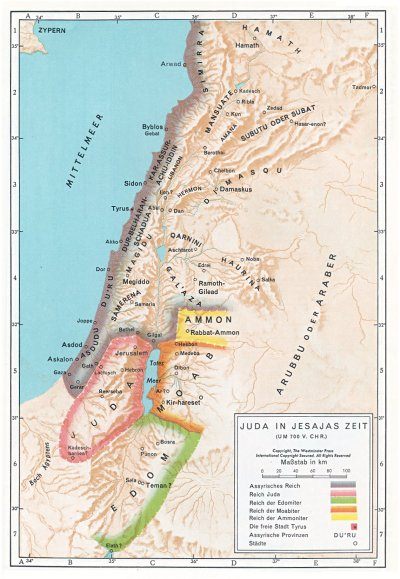 |
Map: The little
states of Judah, Edom, Moab and Ammon are
confronted with the big Empire of Assyria.
The prophecy that these little states will be
"lost" against the big Empire of Assyria, does
not seem inappropriate...
|
29 Southern Reich of
Judah according to OT and findings 884-842 B.C. up to
the invasion of northern Reich of Israel
The events in
southern kingdom of Judah according to censorship of the
Old Testament and according to the documents and findings
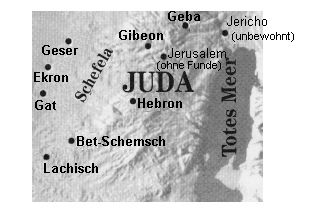 |
Map of Judah with Lachish, Shefela, Hebron, Beit
Shemsh, Ekron, Gibeon, Gat, and Geba
|
Finkelstein / Silberman give the following indications about
the OT concerning the development of the southern Reich of
Judah:
-- the data indications of the kings are right with light
corrections (p.250-251)
-- OT conceals the characters of the kings in the southern
Reich
-- "sin" in Judah is said having punished by God, and "bad"
kings are having said only for a short time (p.251).
The documents according to
the El-Amarna letters: There are always border conflicts
of Urusalim with Shechem and the region of Shfela
In the letters found in Tell el-Amarna from Egypt the
territory of Judah is described with 6 clay tablets (p.258).
Abdi-Hepa [a king of Phoenicia] writes about Jerusalem
(named Urusalim in that time):
-- the king's citadel Urusalim (Jerusalem) is ruling
highlands with only few population
-- the territory consists of the regions of Bethel in the
North down to the region of Hebron in the South, that are
appr. 2330 km2 [for example almost
the surface of little German federal state of Saarland]
-- southern kingdom of Judah is always affected by border
clashes with the northern Reich Shechem (northern kingdom of
Israel) and with the Shfela region (p.259).
[Conclusion: Perhaps Jerusalem was in the beginning only a
tree or a stone].
Archeology about the city state of Jerusalem (southern
kingdom of Judah): there is no statehood
OT claims that there had been a holy ideal, but all is a
fake and historically unreal. According to archeology there
exists no national religion until king Hezekiah is ruling
(p.254).
Archeology is looking for and arranging their findings for a
long time according to the biblical story and their mind is
blocked and they don't look for a new story (p.254-255).
Archeology has believed the OT for a long time, but all was
only a wishfulness (p.255).
According to Finkelstein / Silberman there has only grown
the number of the villages a little bit since the tribe
leaders David and Solomon (p.260).
Missing indications for any statehood
-- until the late 8th century B.C. there are missing any
monumental inscriptions and seals of the kings - the
essential characteristics for a developed state (p.255)
-- ostrakas are missing (that are written clay tablets for
managing any trade)
-- and there are missing marked weight stones (p.258).
Production of potteries and the production of olive oil is
managed in local private enterprises (p.258).
|

The hill of ruins (tell) of Lachish
(Lakhish), Tell ed-Duweir
|
Regional
center of Lachish
At the beginning the town of Lachish on the foothills of
the Shfela region is the only regional center in the kingdom
of Judah (p.255).
Country style architecture
According to the archaeological research until today the
layout of town planning and architecture is generally in a
country style up to 7th century B.C. without any monumental
kind of constructive form (p.255).
The customs in the region of Judah according to
archeology - no trace of any temple
Archeology is investigating in whole Judah and can find all
possible forms of religions with figurines, altars, vessels
for libation sacrifices and altars for sacrifices. The
customs were very different and distributed in the different
centers of clans. The temple of Jerusalem - if there had
been one - was not the only center. But there is not one
single little finding of a temple in that time (p.261).
Settlement building was done with the scheme of the
"amplified family settlement" (p.261).
Religions and alleged reforms in Judah
In the alleged first temple of Jerusalem [until today
without any findings] is said having preserved also cult
objects for Baal, Astarte, or for the heavenly hosts, and
the cult actions were performed also in the temple, also the
adoration of Mesopotamic god of Tammuz. OT qualifies all
this as "atrocities" (p.263).
The prophets of Judah are said having protested against the
"foreign gods". When we admit the description of the
conditions in Jerusalem as true, so hardly "good" and "bad"
kings can be distinguished - so Finkelstein / Silberman
(p.263).
All religious "reforms" indicated in the OT under the kings
of Judah have to be put into question - this say Finkelstein
/ Silberman, because southern Reich of Judah is rated always
as "good", and northern Reich of Israel is rated always as
"bad" (p.270).
931-914 B.C.
Southern Reich of Judah under king Rehoboam: religious
tolerance and punishment by Egypt invasion?
OT claims:
-- king Rehoboam is says having been the alleged son of the
faked king Solomon, and it is said that under Rehoboam many
fortresses were constructed (2d book of Chronicles 11,5-12)
(p.255)
-- king Rehoboam is said having been a "sinner", and the
inhabitants are said having constructed "heights" [altars
for sacrifices on hill tops], and the inhabitants are said
having copied the atrocities of the pagans (1st book of
Kings 14,22-24) (p.251)
-- king Rehoboam is said having permitted sacrifices on all
heights, and stony monuments and pictures of Ashera on all
high hills and under all green trees (p.251)
-- king Rehoboam is said having permitted temple whore men
and all other atrocities of the pagans (1st book of Kings
14,22-24) (p.251).
Punishment is said having come in 926 B.C. by an Egypt
invasion against Jerusalem under Pharaoh Shishak, and it's
said that the temple treasuries and the palace treasuries
from the faked palace of David were taken for tribute (1st
book of Kings 14,25-26) (p.251).
Documents and archeology about king Rehoboam
Archeology cannot find any fortress which is from the time
of Rehoboam. But there are found many monumental buildings
of the time of 200 year later (p.255).
914-911 B.C.
Southern kingdom of Judah under king Abia
OT claims:
-- the king Abia is said having been a "sinner" as his
father, king Rehoboam (1st book of Kings 15,3) (p.251)
-- and as punishment some border clashes are said having
been with northern Reich of Israel (p.251-252).
911-870 B.C.
Southern
kingdom of Judah under king Asa
OT claims:
-- king Asa is said having been a "good" king and is said
having ruled for 41 years (1st book of Kings 15,11) (p.252)
-- king Asa is said having constructed defensive works in
the biblical town of Mizpa (today in Jordan) (1st book of
Kings 15,22) (p.255)
-- under king Asa Jerusalem is said having saved by God of
the attack of the northern Reich Israel under king Baesa,
because Judah had plead for help with the king of Aram
Damascus, so Damascus had attacked Israel in the North and
Israel was forced giving up the siege of Jerusalem (p.252).
What documents and archeology say about king Asa
Archeology is investigating the hill of ruins of Mizpa (Tell
en-Nasbe) and cannot find any fortress work which could be
allocated to king Asa, but there are many ruins that can be
allocated to a time of 200 years after (p.255).
870-846 B.C.
Southern Reich of Judah under king Josaphat
(analyzed: Jeho-shafat, in English: God has judged)
OT claims:
-- king Josaphat is said having ruled for 25 years copying
the model of his father Asa in a loyal way to God
-- king Josaphat is said having made a peace agreement with
the northern kingdom of Israel (p.252)
-- king Josaphat is said having organized a successful
military offensive with the northern Reich of Israel against
Aram and Moab (p.252).
According to the composed OT are following "good" and "bad"
kings now, some times also both at the same time (p.252,
253).
851-843
Southern Reich of Judah under king Jehoram
OT claims:
-- king Jehoram is said having removed the stony monument
Mazzebe of Baal and is praised for this in the OT
-- but king Jehoram is said having followed also the "sins
of Jeroboam [with golden calves] (p.243)
-- king Jehoram is said having taken a wife from a "sinful"
family of the royal family of northern Israel. He is said
having married the princess daughter of Ahab and Jezebel
Atalya
-- king Jehoram is said having introduced the cult of Baal
in Jerusalem again
-- and as punishment for his "sins" the dependent state of
Edom is said having performed a rebellion
-- and further punishment for the "sins" of Judah are said
having the loss of rich agricultural territories in the
western hilly countryside to the Philistines (p.252).
843-842 B.C.
Southern kingdom of Judah under king Ahaziah
OT claims:
Ahaziah is said having died during the quarrels about the
succession in northern Reich of Israel during the coup of
Jehu. Then his mother Atalya is said having been got the
message of his death and is said having ordered the
liquidation of all royal descendants of the house of David
and is said having been enthroned herself (p.252).
842-836 B.C.
Southern Reich of Judah under queen Atalya (mother of
Ahaziah)
AT claims:
Temple priest Joyada is said having waited for 6 years for a
possibility for a takeover of the throne. Then he is said
having claimed that a David descendant had been safed of the
persecution of Atalya and presents Jehoash as a son of
Ahaziah with another wife. When Jehoash was anointed, Atalya
is said having been struck dead (p.252).
836-798 B.C.
Southern kingdom of Judah under king Jehoash (alleged son
of Ahaziah)
OT claims:
-- it is said that king Jehoash ruled for 40 years in
loyalty to God (2d book of Kings 12,3)
-- king Jehoash is said having renovated the temple (p.252)
[but there is missing any finding of this first temple]
-- king Jehoash is said having paid a high tribute to king
Hazael of Aram Damascus preventing an occupation of Aram
Damascus (2d book of Kings 12,18-19) (p.252-253).

 King of
Hazael of Aram Damascus
|

Map with Assyria and Aram Damascus in 820 B.C.
appr.
|
798-769 B.C.
Southern kingdom of Judah under king Amaziah
OT claims:
-- king Amaziah is said having been a "good" king in loyalty
of God, but "not that good like his father David" (1st book
of Kings 14,3)
-- king Amaziah is said having organized a successful war
against Edom (p.253)
-- then is said that northern kingdom of Israel had
exploited the overspending of forces of southern Reich of
Judah and had torn down the wall of Jerusalem [but there is
no finding of the wall], and king Amaziah is said having
been defeated and seized (p.253).
According to archeology the southern Reich of Judah has
never fought any war until the northern Reich of Israel was
destroyed (p.250).
785-733 B.C.
Southern Reich of Judah under king Uzziah
OT claims:
-- king Uzziah is said having been a "good" king
-- king Uzziah is said having "moved" the southern
borderline to Edom to the south (p.253).
|
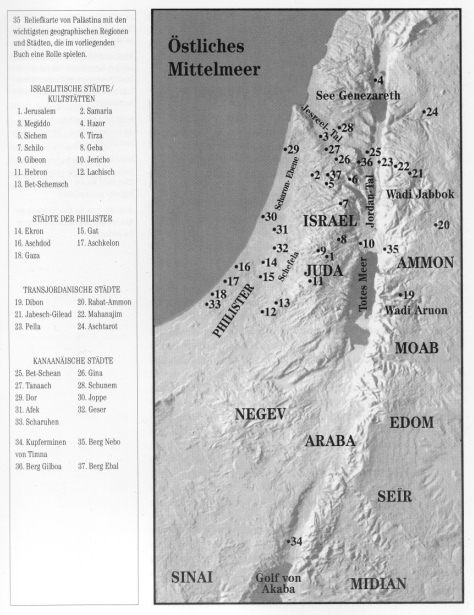
Map with Israel, Judah, Ammon, Moab and Edom
722 appr.
|
759-743
B.C.
Southern Reich of Judah under king Jotham (son of Uzziah)
[there is no indication].
743-727 B.C.
Southern kingdom of Judah under king Ahaz
OT claims:
-- king Ahas is said having been a "bad" king, he is said
"having migrated on the path of the kings of Israel", he is
said having his son passed through the fire "according to
the dreadful customs of the pagans", he is said having
sacrificed sacrifices, he is said having fumigated on the
heights and on the hills under all green trees (2d book of
Kings 16,2-4)
-- as punishment for the "sins" of king Ahaz the Edomites
are said having occupied Eilat on the Red Sea and king Rezin
of Aram Damascus is said having performed a siege of
Jerusalem together with king Pekahiah from the northern
kingdom of Israel (p.253)

Tiglath-Pileser III., profile, location of
finding Nimrud.
|
|
-- king
Ahaz is said having plead for help with Tiglath-Pileser III
(745-727 B.C.) and is said having given him presents from
the temple in advance
-- and by this Tiglath-Pileser III is said having conquered
Damascus and killed king Rezin (2d book of Kings 16,9)
(p.253).
Documents and archeology speaking about king Ahaz
As a vassal with Assyria the kingdom of Judah is not
isolated any more and begins the political game (p.263).
King Ahaz prevents the confrontation so Judah can survive.
In this way he can develop first beginnings of a public
administration (p.292).
727-698 B.C.
Southern Reich Judah under king Hezekiah
The anointing of king Hezekiah is said having been a
great event (p.270). In the beginning of reign of Hezekiah the
southern kingdom of Judah has about 35,000 inhabitants
(p.258).
And now this king is said having been a "good" one with no
faults and only with merits (p.291).
720 B.C.
Collapse of the northern Reich of Israel, Assyrian
occupation - and the southern Reich of Judah starts a new
development
30 Growth of city state
of Jerusalem / of southern Reich of Judah after the ruin
of northern Reich of Israel since 720 B.C.
Southern kingdom of Judah "is
taking over" northern kingdom of Israel
According
to the faked OT the southern Reich of Judah is taking over
quasi the full birthright after the ruin of North Reich of
Israel, as if it would be a younger brother (p.246).
Now is a strong growth in
the Reich of Judah under king Hezekiah:
There is an influx of refugees - and the prophets of the
collapsed northern Reich have their plans for a 1 god
religion
Since 720 B.C. city state of Jerusalem (biblical "kingdom of
Judah") is growing now rapidly by a wave of refugees from
the occupied northern kingdom of Israel (p.56). There is a
big influx of palace employees, refugees and expelled
farmers of the ex northern kingdom (p.14). Probably under
these refugees are also the northern Israelite
prophets and priests. By this the memory of the destruction
of the North Reich Israel is kept alive (p.244).
Now the warning prophets from the northern Reich of Israel
are claiming more and more a "1 god religion" and want to
realize this plan in the kingdom of Judah now (p.268). These
warner prophets are taking reference to Elia, Elisa, Amos,
and Hosea. They all want to accept only one single god any
more. When there is an occasion they want to perform their
religious cleansing (p.268).
At the same time since 720 B.C. there is coming a movement
of national revanchism. This national movement consists of
Jewish court employees, clerks, priests, farmers, and
prophets (p.12).
The religion of Jewry is not at all fixed yet.
Archeology: Statehood in southern kingdom of Judah is
coming very fast now
According to the findings of archeology the little kingdom
of Judah
-- never had any diplomacy
-- and never has conducted any war (p.250).
In this kingdom of Judah is evoked a great development from
one to the other day (p.56) because Judah has to intercept
the big change after the collapse of the northern Reich of
Israel (p.250), and as another new fact Judah is totally
surrounded by provinces with Assyrian governments or
Assyrian vassals (p.263). Judah is the new Jewish center now
(p.250), becomes the new political and religious center of
the Israelite community (p.263).
Judah is growing and is becoming a local power now (p.57).
The northern city state of Shechem (biblical "northern
kingdom of Israel") is only a memory. Southern city state of
Jerusalem is flourishing now and also developing territorial
ambitions (p.185).
The installation of Judah's political system has got the
following element:
-- statal facilities are installed (p.56)
-- Judah only now introduces annals and a historical
awareness
-- Judah becomes only now a fully developed state with
professional priests and clerks (p.249).
[And always the saying is true: "The last will be the
first", for Egypt, for northern Reich of Israel, for
Assyria, and for all Reichs which will come].
-- there is a rapid population growth (p.250), a population
explosion (p.264)
-- according to archeology Jerusalem only now becomes a
religious center, an Israel Jewish metropolis and trade
center (p.250)
-- Judah is installing it's industry for mass production of
ceramics and olive oil for the export (p.258)
-- Judah is installing an import and export trade (p.250)
-- the trade is managed with ostraka (written clay tablets)
and with weight stones, these are found by archeology
(p.258)
-- illiteracy is overcome, reading and writing is spreading
and written texts suddenly get authority (p.269).
Archeology: Only now there is a development for building
up the city state of Jerusalem in 7th century B.C.
City state of Jerusalem (biblical "kingdom of Judah") is
developing it's buildings only now (p.255), sporadically
(p.266) of blocks of stone with stony capitals (p.177) in
Aeolian similar style ("proto Aeolian") (p.255), whereas the
buildings in Judah are not as big as in the city state of
Shechem, and the quality of the construction is less
(p.177).
|
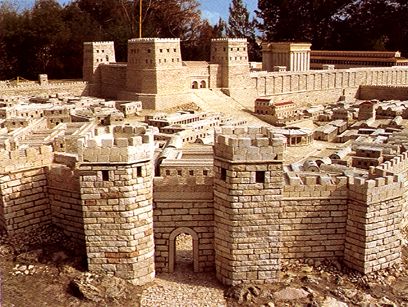
Model of Jerusalem in 7th century B.C. with
northern city gate, Damascus gate, and in the
background the temple
|
Archeology
can exactly state the rapid growth of Jerusalem (p.263-264).
The layout of Jerusalem is amplified from 4 to 5 hectares to
60 hectares (p.264), this is about the half of the historic
city of today (p.13). The residential areas are growing on
the hills aside the slim ridge, with a huge town wall saving
the new suburbs. The houses are side by side in a dense way,
with workshops and public buildings. Finkelstein / Silberman
estimate that the number of inhabitants was rising from
1,000 to 15,000 (p.264).
[Speculation: Royalty is taken over from the northern
kingdom
There is missing the report how the kingdom of Judah was
found when David and Solomon had not been kings. It's
possible that the royalty of the northern Reich was simply
taken over in the South. Then king Hezekiah had risen from a
tribal chief to a king, and the refugees of the North had
constructed him the new capital of Jerusalem. Now many towns
get their town walls. Speculations may go on].
Growth in agriculture interior according to archeology
-- many new farms are founded near Jerusalem
-- in the South of the town and in the Shfela region are
founded new farms on relatively empty soil (p.264)
x
|
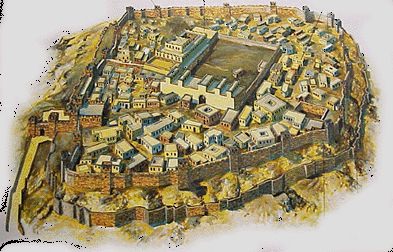
 Lachish:
model of the town, at the end with a double town
wall Lachish:
model of the town, at the end with a double town
wall
|
-- villages are growing to towns (p.264), in the plains are
developing medium-sized towns as regional centers (p.266)
Lachish gets a town wall and is another new administration
center
-- in the bay of Beersheba new towns are founded (p.264).
The map of kingdom of Judah is changing radically now: Judah
in 710 B.C. appr. (in the late 8th century B.C.) has appr. 300
populated locations with all kinds of size, with about 120,000
inhabitants and with a statal structure (p.264). The
characteristics of statehood can all be found:
-- monumental inscriptions
-- seals and seal impressions
-- ostraka (written clay tablets) for the royal administration
(p.266).
Industrialization in the kingdom of Judah under king
Hezekiah according to archeology
Only now a statal olive oil industry is developed in the city
state of Jerusalem (p.177), and with this a mass production is
connected and a sale of ceramic vessels and other things. Add
to this there is an industry installed working with oils and
wine products under statal leadership (p.266).
The new wealth in Jerusalem under king Hezekiah and his
successors
The origin of wealth can be found easily:
-- kingdom of Judah has integrated into the economic system of
Assyria
-- kingdom of Judah has probably taken part also in the Arab
trade (p.266)
-- and by this Judah gets new markets (p.267).
All in all since 720 B.C. there is an absolute social and
economical revolution in Judah coming from the economy of
clans to the modern state. Jerusalem is getting a very rich
spot (p.267).
Visits from the ex northern Reich
Israelits from the ex northern kingdom of Israel are
regularly visiting the cult celebrations in the temple of
Jerusalem (p.242-243).
31 Conditions in ex
kingdom of Israel
Colonization of Assyrian
deportees in ex northern Reich of Israel
The places of the fled and deported in the
northern kingdom of Israel are colonized by Assyria with own
foreign deportees (p.59).
By the new settlements there is a mix of population in the
ex northern Reich of Israel that is regularly denounced in
propaganda speeches in Judah (p.243).
[Today one would say: racists].
32 Southern Kingdom of
Judah: religion is hot spot of conflicts - propaganda
for a 1 god religion
Propaganda against
all gods but "God"
In southern Reich of "Judah" the propagandists are beginning
a religious reform movement now with the aim to ban all gods
but God (JHWH). The temple in Jerusalem shall be cleaned of
all "foreign" gods (p.250).
There is a big quarrel and dispute provoked by this: The
warner prophets claim that they want to prevent another ruin
as it had been with northern kingdom of Israel, and they get
many followers, more than the other gods. By this religious
law and religious policy are "present". But now the
propagandists also claim that all Israelites have to have
the same belief, and Jerusalem is getting stronger and
stronger. Priests and prophets are propagating the "right"
form of adherence for all inhabitants of Judah and all
Israelites from the ex northern Reich of Israel (p.267).
This "God alone movement"
-- means that an orthodox form of belief would be good
-- also wants to manipulate the history of the Jews
presenting one single history for all Jews with Jerusalem as
the central place
-- and it can be admitted, that the "God alone movement" had
connections to economy, policy and culture, and that the
final goal was the reconquest of the northern Reich with a
new "dynasty of David" with the center in Jerusalem, and all
other centers of religious cults of the North should be
destroyed (p.269).
[That's religious dictatorship].
The religious censorship in kingdom of Judah under king
Hezekiah according to faked OT
OT claims:
-- king Hezekiah is said having ruled in Jerusalem as "good"
king for 25 years and had executed general religious reforms
guaranteeing"purity" and "loyalty" to God since the alleged
king David (p.253)
-- king Hezekiah is said having converted Jerusalem in a
center of adherence of God and is said having installed the
dynasty of David as the only mediator between the population
and God (p.270)
-- king Hezekiah is said having induced the elimination of
the sacrifice tables on the "heights" (on the hill tops)
-- king Hezekiah is said having induced the destruction of
the picture of goddess of fertility Ashera
-- king Hezekiah is said having destroyed the serpent of
faked Moses
-- king Hezekiah is said having been the most loyal king to
God (2d book of Kings 18,3-7) and only with king Hezekiah is
said having been reinstalled all divinity as it had
allegedly been under David (p.254)
[but there never was any king David before...]
OT claims that Hezekiah had been that brave like the faked
king David, and whole Judah is said having been freed of the
sins of the past by king Hezekiah (p.271).
According to faked OT King Hezekiah is said having sent
messengers to the faked tribes of Ephraim and Manasseh -
that means to the highlands in the ex northern Reich of
Israel - for an invitation of Passover in Jerusalem (2d book
of Chronicle 30,1; 30,10; 30,18). Biblical books of
Chronicle of OT are presenting this king Hezekiah as a
second Solomon, and Hezekiah is said having unified whole
Israel around the temple of Jerusalem. Hezekiah is said
having sought the leadership in Judah and also in the ex
northern Reich of Israel (p.280).
The other cults of other gods are described in the OT of the
Bible as a chaotic social diversity (p.269), and the old
tribal structures in the countryside have also to be
destroyed (p.269-270). The original Jewish tradition is
called a Canaanite heresy and suddenly is qualified as
foreign (p.270).
OT stating the prohibition of all other cults - OT never
mentioning the representatives of the old cults
Historiography only has the literature of the priests of the
"God alone movement". The methods of the enemies of king
Hezekiah who want to tolerate the cults of Astarte (goddess
of fertility), of the stars (celestial body) or of other
gods are not delivered to posterity (p.285).
All cults without "God" - these are cults of fertility, or
cults of the ancestors - are prohibited. All religious
pluralism is prohibited (p.267). The "One God" propagandists
are winning whereas the origin of this movement are the
sermons of the northern kingdom of Israel (p.268).
Finkelstein / Silberman estimate that the warner prophets
have manipulated the Jewish priests and the royal officials
(p.268) supporting the "One god movement" only (p.269).
[And by this the little kingdom of Judah shall be saved from
the huge Assyrian Empire? That's an absolute nonsense...]
But the representatives of the traditional customs don't
give up (p.268). But Bible conceals this.But according to
Finkelstein / SilbermanBible would be another book when the
traditionalists had "won".
Finkelstein / Silberman:
"If the adherents of the traditional forms of the syncretic
[mixed religious] adherence [for many different gods] had
won at the end, so there had possibly been a totally other
Bible - or perhaps none at all." (p.269)
Archeology speaks about king Hezekiah: there were no
religious reforms and no censorship
Archeology cannot find any archaeological finding of the
alleged reforms under king Hezekiah installing a One God
Belief. The both religious sites of Arad and Beersheba which
are stated in connection with Hezekiah's reforms are
controversial (p.270).
There are new traditions in
Jerusalem: graves in the rocks for the rich
Above all for Jerusalem there are proved new rites of
burial, eventually in connection with a new formed elite. At
the slopes of the mountain ranges around Jerusalem there are
installed graves in the rocks, often with rich
installations, the roofs with gables, with comices, with
pyramids with crowns, probably of the upper class, for the
nobility or for high officials (p.266).
Findings of inscriptions of these graves indicate that the
graves were from the nobility. The same kind of graves can
be found in other towns ofthe hilly countryside (p.266).
OT is blaming these graves of luxury in the rocks, for
example prophet Isaiah. He is blaming Sebna, the supreme
royal palace guard, for having a grave in the rocked
installed (Isaiah 22,15-16) (p.266).
33 Trial of upheaval for
reconquest of ex North Reich Israel under king Hezekiah
- destruction of Judah - reconstruction under king
Manasseh
Failed "reconquest" - the
Assyrian revenge - and king Manasseh - and the One God
Movement is spreading a story of a Moses
705 B.C.
x
|
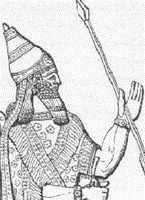
Sennacherib,
ruler of Assyria 704-681 B.C. provoking a new
destiny in the Middle East
|
The
Assyrian successor of king Sargon II, Sennacherib, is busy
with rebellions in the East of the Assyrian Empire. It seems
that Assyria is destabilized for a crash. The responsibles
in Judah mean that this would be the moment for a reconquest
of northern Reich of Israel (p.271).
Well, Assyria wants a stable Middle East (p.288) because
there are trade routes going from the bay of Beersheba
passing the highlands of Edom, and there are caravan routes
from the southern coastal plain to Arabia (p.289). With
stability the Arab trade is managed. Rebellions will not be
tolerated, not either in Judah, because the Arab trade would
be in danger (p.288).
Sennacherib defines Ninive as the new capital of Assyria and
has new palaces built [web01].
King Hezekiah means for his side that a religious reform
with the One God Movement could support the reconquest of
the ex northern Reich of Israel. But all in all the trial of
a reconquest is an absolute imprudence (p.292).
OT claims:
King Hezekiah - supported by Egypt - is said having made an
anti Assyrian coalition with others (2d book of Kings 18,21;
19,9).
or:
King Hezekiah is said having solved from the vassal contract
with Assyria (2d book of Kings 18,7).
But there is no rebellion described in the OT (p.275).
Propaganda for a "One God Belief" by war
According to Finkelstein / Silberman this war also is a
pretext pushing through the "one god religion" in his
country (p.271).
OT claims: There are preparations for defense against the
Assyrian punitive expedition
OT claims:
Before the Assyrian punitive expedition against the
conspiracy of Hezekiah is said having been prepared the
defense (p.275), with the construction of storehouses for
corn, oil and wine, with the construction of cattle sheds
for sheep and cattle (2d book of Chronicle 32,27-29).
Add to this
-- water supply for Jerusalem is saved covering springs and
the river by a roof (p.276) resp. the spring is completed
with an access by a new tunnel (2d book of Kings 20,20)
(p.277-278)
-- the town walls are said having been reinforced
-- there is said having been a general armament with weapons
and shields
-- Hezekiah is said having assured that with God will be a
victory against Assyria (2d book of Chronicle 32,2-8)
(p.276).
[Well, considering the Assyrian Empire this project of a
rebellion against Assyria is an absolute madness, and the
claim of a "punitive expedition" saving the trade routs of
the Arab trade seem to be reasonable].
Archeology confirms the preparations for defense
-- for example a protective barrier of 16 meters of
thickness around the Jewish quarter of Jerusalem can be
stated
-- for the construction of this wall private houses are
destroyed which is mentioned also in OT by Isaiah blaming
the king for the destruction of the houses for the
construction of the wall (p.276)
-- archeology confirms an underground creek from the spring
of Gihon near Jerusalem at the ground of Kidron valley
outside of the town walls: There was dug a tunnel from the
spring to a pond which was 30 cm lower. Sioa inscription at
the southern end of the tunnel was detected in 19th century
telling about this project (p.277).
"Hezekiah
tunnel" for fresh water supply in Jerusalem
|
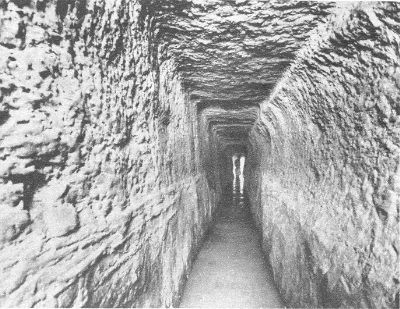
This tunnel was constructed for fresh water supply
in Jerusalem, dug under king Hezekiah
|
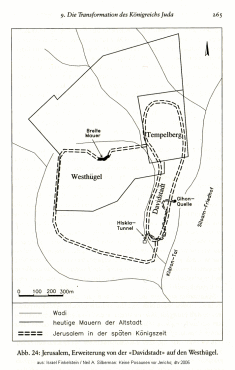
 Map of
Jerusalem with David's town, the spring of Gihon,
and the Hezekiah tunnel
|
-- the town of Lachish receives tremendous defense
installations with a 6 chamber city gate, respectively
historians mean that the fortress which was assigned to king
Rehabeam first should be assigned to king Hezekiah (p.278)
-- all stocks are organized in a centralized manner, jars
are produced in masses, with seals of the ceramics workshops
(p.278).
The Assyrian "punitive expedition" in the kingdom of
Judah - OT claims a "mystery of Jerusalem"
-- according to OT the leading hand of God is in all actions
of king Hezekiah, and to his taste he will give a reward or
a punishment (p.273).
The siege of Jerusalem (king Sennacherib against king
Hezekiah) is described like this in the OT:
-- the Assyrian commanders are said having provoked the
defenders on the town wall of Jerusalem having mocked the
citizens and they are said having tried breaking their
courage taking into doubt Hezekiah's wisdom and mocking his
belief (p.273)
-- the Assyrian are said having reproached to the citizens
and representatives of Jerusalem that they had lost the war
already (2d book of Kings 28,28-35) (p.274)
-- supporting the moral texts about Hezekiah about the
"sins" of the northern Reich of Israel are presented and
repeated (p.273)
-- during the siege of Jerusalem prophet Isaiah is said
having calmed king Hezekiah with an oracle stating that king
Sennacherib will be confronted with a rumor and will leave
Jerusalem and will die in his own country by the sword (2d
book of Kings 19,6-7; 19,32-34) (p.274)
-- then in the following night an angel is said having
killed 185,000 men of the Assyrian army sieging Jerusalem,
and further is said that now king Sennacherib had returned
going home to Ninive and had been killed by sword by his two
sons Adrammelecht and Sarezer during a religious service for
god Nisroch (2d book of Kings 19,35-37) (p.274)
-- the saving of Jerusalem under king Hezekiah and the
destruction of the army of Sennacherib are said having been
actions of the hand of God (p.273) which were performed
thanks of piety of king Hezekiah (p.271)
-- also when all towns around Jerusalem were destroyed by
the Assyrian troops god JHWH is said having been the key
figure of the saving of the population - according to AT
(p.273)
-- Judah's belief to God is said having been reinforced by
the "miracle of Jerusalem" and king Hezekiah is said having
destroyed the places of sacrifices on the "heights" (on the
hill tops) (p.275).
x
|

 Sennacherib,
report of the military campaign against Judah
written in a clay prism. Today this is in the
British Museum. Sennacherib,
report of the military campaign against Judah
written in a clay prism. Today this is in the
British Museum.
|
The
documents speak: Sennacherib's report indicates the total
destruction of Judah except Jerusalem
-- Sennacherib's troops are sieging 46 Judean towns and
always win tanks to their "well constructed ramps of earth"
and "battering rams", add to this they are using mines, gaps
and pioneers (p.280)
-- the military campaign for the construction of the
rebellious Judah is precisely planned and is executed from
the fertile branches of the hilly country down to Jerusalem
(p.281)
-- for example the fortress of Azekah is taken by assault
and devastated (p.281).
And the mass killing of Assyrian soldiers does not happen,
God's hand is not at all helping but there comes the
Assyrian occupation of Jerusalem:
701 B.C.
Sennacherib's troops defeating Judah
(S.271)
The prey of Sennacherib in Judah according to his report
-- Sennacherib is making 200.150 prisoners of war, and there
is much cattle: "horses, mules, donkeys, camels, cattle and
small domestic animals (p.280)
-- the towns are plundered (p.281)
-- king Hezekiah in Jerusalem is reaching his end: He is
locked in his palace and the palace is walled at the end
(p.281).
[Addition:
King Sennacherib lets king Hezekiah live perhaps because he
wants to have a loyal vassal at the end].
Archeology: layers of ruins confirming the Assyrian
punitive expedition
The destruction of the towns by the military campaign under
Sennacherib form new hills of ruins (tells). These are
"horrible archaeological findings". Add to this Finkelstein
/ Silberman mean that the number of prisoners of war in
Sennacherib's report was indicated too high (p.281).
A wall relief in the palace of Sennacherib in Ninive
showing the battle of Lachish
Relief about the siege and storming
Lachish under king Sennacherib - deportations
|
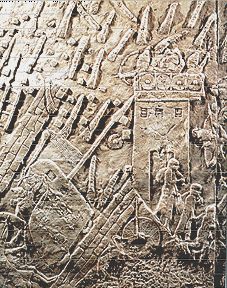
Relief of the siege of Lachish, finding in Ninive
|
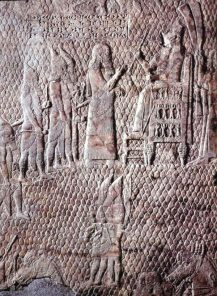
 Lachish:
Sennacherib receiving the surrendered Jewish ruler,
relief Lachish:
Sennacherib receiving the surrendered Jewish ruler,
relief
|
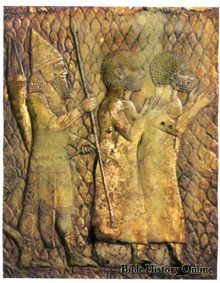
 Lachish: After
the siege Jews are prisoners, finding in Ninive Lachish: After
the siege Jews are prisoners, finding in Ninive
(www.bible-history.com)
|
This wall of reliefs which was excavated in old
Ninive is describing the fall of Lachish by the army
of king Sennacherib in pictures. The population is
seized at the end. Before the siege of Jerusalem
Sennacherib took 36 towns. Today the relief is in
the British Museum [web02].
|
A mural relief in Sennacherib's palace of Ninive on the wall
of an interior room is showing the siege and the destruction
of Lachish. The importance of this victory can be estimated
by the installation in an inner room (p.281).
The relief shows precisely the events in the battle of
Lachish:
-- there are big fights before the wall, and on a ramp
battering rams are pushed against the town wall
-- the defense tries putting fire with torches, and at the
same time the Assyrians are protecting the battering rams
with water (p.282)
-- there are captives, dead bodies are spitted, prey is
taken out of the town, also holy vessels for religious
rituals
-- topography and even the local flora are depicted
precisely, and even the viewpoint of the painter can be well
identified
-- the archaeological excavations of the 1930s and 1970s
confirm the depiction of the walls in the relief, and even
the siege ramp is excavated (p.283).
The excavations in Lachish show even more of the battle
of Lachish
-- the population constructed a counter ramp
-- the town was completely put on fire (p.283)
-- the threatening battering rams were fought with burning
stones with holes filled with burning ropes
-- on the western slopes of the tell archeology finds a mass
grave with about 1,500 dead bodies (p.284).
After the punitive expedition the prophets are inventing
a new moral: Further "sin"
OT mentions the victims of the occupied towns in the
prophetic books, for example in book of Isaiah 10,28-32) and
in book Micha. with moral ratings: Lachish is said having
been "the beginning of the sin" etc. (Micha 1,10-13)
(p.284).
Judah is completely dependent on Assyria now - and Judah
is reduced
The Bible conceals that after the defeat Judah has to
surrender completely under Assyrian policy, which again
would be a "sinful" behavior (p.291).
Sennacherib is parting Judah according to his own report.
Only a little Judah is left. The other territories are given
to the neighbors [that's a Hitler method!]:
-- to Mitinti, the king of Ashdod
-- to Padi, the king of Ekron
-- to Silbel, the king of Gaza (p.281)
-- and king Hezekiah has to pay high tribute now (p.281)
-- Sennacherib is giving high quality land of agriculture of
Judah to the Philistine states reducing Judah dramatically
-- and there are deportations of Judah population to Assyria
[without indications of numbers] (p.285).
The new organization of the mini kingdom of Judah
-- Lachish becomes the second town after Jerusalem as an
administrative center with high quality soil for agriculture
which has stayed yet in Judah (p.281)
-- the region of the kingdom of Judah never recovers really
again (p.284-285) and the hilly country stays only with
little population
-- according to archaeological research the towns and the
cultivated soil are reducing by about 2/3 (p.285)
-- some of the big town are reconstructed, but many of the
little towns, villages and farms will stay in ruins [and
convert into hills of ruins ("tell")] (p.285).
[Such destructions also Stalin, Hitler, Roosevelt and
Churchill did, and with deportations Hitler and Stalin are
standing in the same row like Sennacherib...]
Streams of refugees
By the streams of refugees are destroyed many
traditional clan connections for ever, land is lost,
successions are destroyed etc. (p.294).
698-642
B.C.
Mini-Judah under king Manasseh, 12 years old, son of king
Hezekiah
OT prescribes Manasseh as a "bad" king.
OT claims:
-- king Manasseh is said having ruled for 55 years abusing
introducing all dreadful bad things of the past committing
disloyalty to God in the worst manner (p.271)
-- king Manasseh is said having performed a religious turn
around, is said having reconstructed the "heights" again, is
said having reconstructed the altars for Baal, is said
having the picture of Ashera painted, and is said having
adored the heavenly host and served them (p.275)
king Manasseh is said having erected altars for the heavenly
host in the temple of God of Jerusalem in both court yards,
is said having provoked his son [later king Amon?] walking
through the fire (p.275)
-- king Manasseh is said having interpreted crying birds, is
said having exorcists and sign interpreters in his offices
(p.275)
and all this is said having provoked a fury of God (2d book
of Kings 21,2-6). All in all - this claims the composed OT -
the population of Judah under king Manasseh had more false
belief than the population of the northern Reich of Israel
had (2d book of Kings 21,9) (p.275).
OT resp. "the Lord" (God) is said having threated with the
destruction of Jerusalem because of Manasseh (2d book of
Kings 21,11-15) (p.286).
Documents and archeology about the time of king Manasseh
At his enthronement Manasseh is 12 years old. Under his
child government religious pluralism is restored (p.285)
with cult of Baal, Astarte, and heavenly host (p.286).
[Addition
After the big destruction of Judah there could not have been
one single ideology because for the reconstruction Judah was
dependent from all neighbors. That is not a "sin", but that
is the logic of the situation].
Integration of Judah in the
Arab trade: incense and olive oil - center is Ekron
Assyria arranges the integration of Judah into the Assyrian
world economy now (p.288). Integration of Judah into the
Assyrian world economy provokes a complete reconstruction of
Judah after Sennacherib's destructive military campaign
(p.292). Under Manasseh the whole reconstruction is managed
(p.287). By the time Assyria is even reducing the tribute,
perhaps as a prime of loyalty for king Manasseh (p.286).
Under Manasseh result 55 years of peace which are not at all
given by the "hand of God", but from the Assyrian Empire
(p.287).
|
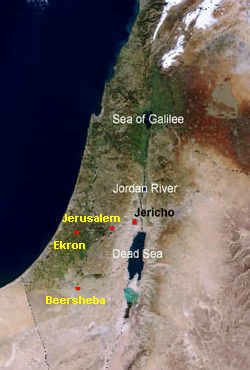
Map with the position of Jericho,
Jerusalem, Ekron, and Beersheba.
|
The two
most important articles of commerce in the Arab trade are
incense from Arabia and the exportation of olive oil
(p.288). Assyria amplifies the olive oil production, for
example with the amplification of the town of Ekron in
Philistine (today the hill of ruins of Tel Mique) in a plain
between the olive slopes and the coast, with over 100 olive
mills which are about 20% of the territory of the town.
Ekron is the biggest known olive oil production center in
the old Middle East with an annual capacity of about 1,000
tons of olive oil, with exportation to Assyria and Egypt
(p.290), resp. Assyria is giving a part of the commerce also
to Egypt (p.288).
The rising number of camel bones of adult camels since the
7th century - without the finding of bones of young camels -
seems to be an evidence for the growing Arab trade
(p.288-289).
When the oil mills are excavated Israeli altars with horns
can be found. So it seems as if the Israelites had worked in
Ekron, as deported workers [or as well payed foreign
workers] (p.290).
Fortress construction by Assyria
Now Assyria also is constructing new fortresses at the
border to Egypt, and they are partly excavated (p.288).
Densification of population in reduced Judah - the
compulsion for the use of poor soil
By the influx of refugees from the destructed and annexed
territories the population in the highlands is rising
(p.287).
Jerusalem is forced to use also poor soil now founding a
dense net of farms because the "breadbasket" in the West was
given to the Philistines. The villages are shifted up to the
dry territories in the East and in the South, with
settlements and cultivation of parts of the steep slopes
down to the Jordan Rift Valley and with the settlement of
the bay of Beersheba (p.287). Eventually this new
settlements are performed by forced measures (p.288).
The settlement in the dry territories and the conversion of
dry soil into fertile soil is the big statal challenge for
the central government. Add to this as a prevention against
the dry season there is installed also a stock economy
(p.291).
King Manasseh: Development
of population along the caravan trade routes
Since king Manasseh the population is growing with a jump in
the bay of Beersheba along the caravan route. The same
happens in Edom which is developing it's statehood only now.
According to the findings - and they are many - there can be
admitted according to Finkelstein / Silberman that the whole
region got their profit by the Arab trade. More in the South
two more Judean fortresses are excavated:
-- Kadesh Barnea, about 80 km in the South West from
Beersheba, at the biggest oasis between southern Judah and
the Red Sea
-- Hazeva, about 32 km in the South of the Dead Sea (p.289).
During
this period the Arabs in Judah have good conditions which is
confirmed by southern Arab inscriptions in Judah. According
the findings of ostraka southern Arab writing is used in
Jerusalem. Eventually Arab groups were living in Judah
itself. Some scholars mean on the base of Hebrew seals with
southern Arab names that the wife of Manasseh Meshullemet
had been an Arab woman (p.289). By such a relation a "visit
of the queen of Saba" could be derived which is assigned to
king Solomon in the OT (p.290).
And now there is the shadow
of the economic growth under king Manasseh
-- only few get rich
-- social uprooting and insecurity are rising
-- olive oil gets more profit than normal agriculture
(p.294).
According to Finkelstein / Silberman this wealth also
provokes the dream of an eternal peace (p.294-295).
[And now the religious fanatics with their invended Moses
stories and sins have the problem, that this peace is made
by Assyria].
Manasseh's policy of religious tolerance
Manasseh's government is supporting the religious moderate
sector. Finkelstein / Silberman presume that this change was
planned since years because Manasseh only is 12 years old
(p.292).
[But the change to a religious tolerance was probably a
necessity to Assyria, and a tool evading more inner
upheavals].
The government of Manasseh is giving back the autonomy to
the countryside which existed before king Hezekiah making
possible a fast reconstruction, and this reconstruction also
is in the sense of Assyria [because Egypt could invade].
Manasseh has to behave like an obedient vassal. An intact
Judah is a better buffer state against Egypt than a weak and
impoverished Judah (p.286).
The prophets of the "one god movement" for the "salvation"
of the northern state of Israel may be very frustrated. King
Hezekiah was not at all a savior of Israel, and they rate
king Manasseh as a devil collaborating with the Assyrian
enemy. It seems under the government of Manasseh had been
rebellions and they were fought brutally (2d book of Kings
21,16), but there is nothing more known yet. But upheavals
of the "one god propagandists" have probably been (p.294).
The "one god movement" is preparing new "holy books" -
and "Moses" epos is prepared
The followers of the "one god movement" have waited for a
long time for the death of Manasseh as it seems, and during
this waiting time they prepared new books [books of Moses 1
to 4 and chronologies of a first Jewish historiography].
After the death of king Manasseh there will be a revenge
against the wrong tolerance and king Manasseh shall be
demonized (p.294).
There are simply compiled different sources (p.84). The "one
god movement" - according to the Bible researchers Albrecht
Alt and Martin Noth - is compiling many myths and stories
around the Israelite history (p.106).
Archaeological findings and biblical reports contradict the
invented book of Moses (Torah resp. Pentateuch) (p.35) and
the book of Moses is in big parts taking reference
directly to the geographic situation of the towns how they
were constructed in the 8th and 7th century B.C. Because of
this all evidence indicate that the patriarchal texts were
written in 8th and 7th century B.C. (p.51).
The invention of a Genesis
According to the German Bible researcher Martin Noth Genesis
(1st book of Moses) is a composition of different stories of
the nomads (p.55). The books of Moses and the chronologies
describe almost only religious conditions. Events of the
neighbor states are excluded (p.297).
[By this method positive events which have their cause in
the neighbor states are regularly presented as "wonders of
God"].
The aim of the "one god movement" is the creation of a world
epos as a collection with historical scriptures, memories,
myths, folk stories, anecdotes, royal propaganda, prophecies
and old poetry, partly original, partly from copies resp.
from elder "versions".
-- this book becomes a folk's book as a mental anchor for
the descendants of the inhabitants of Judah (p.12)
-- with southern Judean and northern Israeli tradition with
the focus of Judah
-- Abraham's alleged altars in Bethel and Shechem (Genesis
12,7-8) are fixed as the spots of important centers of cults
in the northern Reich of Israel
-- Abraham's alleged altar in Hebron is fixed as the second
important location in the southern Reich of Judah after
Jerusalem (p.57)
-- the books of Joshua, judges and Samuel are rated as
preserved by prophet Samuel in Silo (p.22)
-- the books of the Kings are said to be from the prophet
Jeremiah
-- the psalms are said to be from the faked king David
-- the book of Proverbs and the Song of Songs is said to be
from the faked king Solomon (p.22).
Only in a very late time research is detecting that the 5th
book of Moses is written a separate style not matching with
the first four books of Moses, but the 5th book of Moses was
created afterwards. By this the research is defining the 5th
book of Moses and the latter books as a "Deuteronomistic
History" (5th book of Moses + books of Joshuah, Judges,
Samuel and Kings). Also these texts are referring to the
geographic situation of the 7th century B.C., and also
according to archaeological findings they are written mainly
in the 7th century B.C. (p.25) in the southern Reich of
Judah (p.26), in Jerusalem (p.59-60).
The myths about the kings of David and Solomon seem to be
present yet and are integrated into the books of the Kings
of the OT (p.160-161).
[With this the authors fake a big kingdom under David and
Solomon, probably admitting that this could never be
controlled. Or there are presented myths of other kings as
events under David and Solomon].
681-669 B.C.
More documents about
Manasseh as a vassal
Under the
successor of the Assyrian king Sennacherib, Esarhaddon [ruled
681-669 B.C.] Manasseh's Judah is rated in the Assyrian
sources ad a supplier of building material, as 21 other
vassal kings (p.286).
And there is not only building activity, but also the
expansion to Egypt:
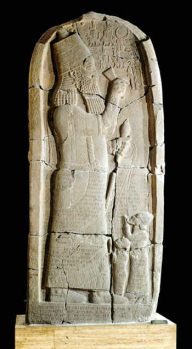
 Esarhaddon,
profile. Esarhaddon is leading the defeated with a
nose ring Esarhaddon,
profile. Esarhaddon is leading the defeated with a
nose ring
|
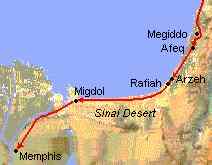
The military campaign under Esarhaddon to Egypt down
to Memphis
|
Assyria's biggest
extension
|

 Assyria's
emperor Ashurbanipal who had Egypt up to Thebes
occupied, profile. This relief is in the British
Museum in London. Assyria's
emperor Ashurbanipal who had Egypt up to Thebes
occupied, profile. This relief is in the British
Museum in London.
|
669-627 B.C.
Assyria under Ashurbanipal
Under the successor of Esarhaddon, Ashurbanipal
(Greek: Sardanapal), Manasseh is acting with gifts
and as loyal friend helping the occupation of Egypt
- according to Assyrian sources (p.286).
652 B.C.
Egypt: Assyrian invasion up to Thebes -
plundering Susa
[web03]
OT claims:
There is a description in the OT that Manasseh is
seized by Assyria in Babel (2d Chronicle 33,11), but
in other sources that is never mentioned (p.286).
|
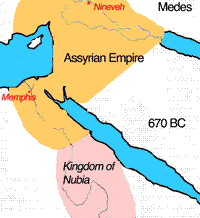
Map: Assyria conquering the lower part of Egypt.
Only Upper Egypt (Nubia) keeps to be Egypt |
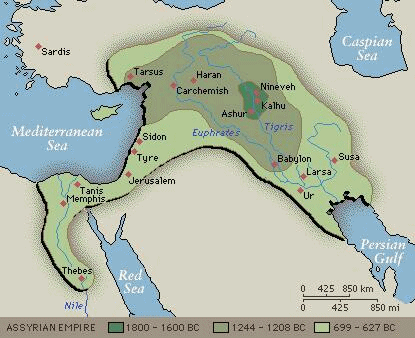
Assyria under Ashurbanipal: Egypt is occupied up to
Thebes. This is the maximum of extension of the
"Fertile Crescent"...
|
The downfall of Assyria
According to Finkelstein / Silberman the downfall of Assyria
is provoked by the continuing attacks on horseback by the
tribes of the Scythes at the northern border. Add to this
there are continuing upheavals in Babylonia and in the East
in Elam (p.303).
[Addition:
The overextention of the borderlines in Egypt provokes the
collapse of the Assyrian Reich. The northern border is
neglected and vulnerable. The biblical saying is: "The last
will be the first". This overextention of borderlines by big
empires and their following ruin is a general political
reality].
664-610 B.C.
Egypt under Pharaoh Psamtik I reorganizing Egypt
and unifying the nobles under his leadership (p.303)
Psamtik I receives the order from Ashurbanipal to unify the
Nile Delta which is split in several Assyrian princedoms. He
is executing this order with a strong army of Egypt and
Greek soldiers [web04].
since 660 B.C.
Assyria is weakened by a rebellion in Babylonia and Elam
[web05]
656 B.C.
Egypt can kick out Assyria - and there is a new
nationalism in Egypt
(p.302)
Psamtik I is succeeding unifying Lower and Upper Egypt.
[web06]
Now Egypt get a great political revival, with adherence of
"great" Pharaohs of the past (p.302). Psamtik I can solve
Egypt from the Assyrian domination step by step (p.302-303)
extending his territory to parts of the Fertile Crescent
because Assyria cannot keep it's power there (p.303). Step
by step the "Assyrian century" is coming to it's end now,
and the Bible is concealing all this completely (p.304).
[But also Egypt will overextend it's borderlines...]

Herodotus,
portrait
of another great liar: According to archeology
his descriptions of an Egypt siege of Ashdod is
an absolute invention. Not one single finding of
a fight could be found...
|
|
New territorial expansion of Egypt
Egypt is pursuing Assyria. So, Assyria is retreating
from big parts of the Fertile Crescent (p.303).
According to Greek historian Herodotus Psamtik I is said
having sieged the town of Ashdod for 29 years. According to
archeology there is not one single trace of any destruction
there, and it seems that the takeover of power there had been
performed without any fight. The description of war of
Herodotus seems to be an sensational invention for making more
money with it (p.303).
Judah is not important for Egypt - and the "one god
movement" can prepare it's epos of Moses
|
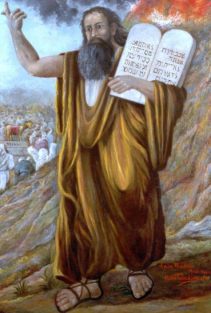
 Patriarch
Moses with written tablets, a painting with much
fantasy without any confirmation by
archaeological findings Patriarch
Moses with written tablets, a painting with much
fantasy without any confirmation by
archaeological findings
|
The little kingdom of Judah has no significance for Egypt and
hardly is controlled in the beginning. This state without
control is a paradise for the prophets of the "one god
movement" prising their God. They mean that the "salvation" of
the ex northern Reich of Israel would be possible now. Without
control a dictatorship of the "one god movement" also a
religious cleansing is possible (p.304).
The "holy books" with it's epos of a "Moses" should revive new
Jewish dreams again and a big national fight should begin
against Egypt and the Pharaoh (p.304).
These propaganda texts of the "one god movement" against their
neighbors (4 books of Moses and the books of Kings with
absolute faked claims against Egypt and the Mesopotamian
Empires) are prepared. The "one god movement" only is awaiting
the death of king Manasseh...
642-640
Kingdom of Judah: Death of king Manasseh - successor is
king Amon
OT claims:
-- king Amon is said having tolerated the wrong belief
-- after 2 years Amon is said having murdered by a conspiracy
-- and now there was a revenge of the population murdering the
murderers, and by these events all social and economic elite
of the country was murdered - according to Finkelstein /
Silberman
-- Amon's 8 years old sun Josiah is said having proclaimed as
the new king now (p.295).
640-630 B.C.
Egypt conquering Middle East
Assyria has to give up Egypt, Philistine, Phoenicia, and the
territory of the ex kingdom of Israel. Egypt troops are
continuing their campaign (p.83).
[Egypt wants to create an Egypt Fertile Crescent...]
Archeology can prove a growing Egypt influence in the Fertile
Crescent for the time of the end of the 7th century B.C.
Pharaoh Psamtik I can reinstall the traditional buffer state
of Canaan against the military Empires in the Mid East and in
his inscriptions he indicates his power up to Phoenicia
(p.303).
At the same time Egypt profits of Canaan with important
agricultural territories and important trade routes (p.304).
34 639-609 B.C.: Mini
Reich of Judah under child king Josiah - publication of
the first 4 books of Moses - war propaganda books for a
reunification
New Jewish leadership under 8 years old Josia is
propagating a new "holy book" with propaganda for
reunification
Josiah - the
allegedly most fair-minded king of Judah
OT claims:
-- Josiah is said having ruled for 31 years as the most
fair-minded king of Judah
-- Josiah is said having been the climax in the manner of a
metaphysic moment as were the faked figures of Abraham, Mose
or David (p.295)
-- during his government he is a great hope for a national
"salvation" (p.296)
-- Josiah is said having been a turn around from a "bad"
king to a "good" king
-- Josiah is said having been a loyal successor of faked
king David (2d book of Kings 22,2)
-- tanks to his justice Josiah is said having done decisive
good deeds (p.298).
Josiah according to the documents and archeology
639 B.C.
Mini kingdom of Judah: enthronement of Josiah with 8
years
Josiah is an 8 years old child king (p.302). In the Judean
leading clique there is a dream of holiness and unity of the
land of Israel (p.109).
Structures of the mini
kingdom of Judah under child king Josiah
Mini kingdom of Judah consists only of a tiny core with the
alleged tribes of Judah, Simeon, and a little part of the
territory of the alleged tribe of Benjamin (p.109).
According to Finkelstein / Silberman this mini kingdom of
Judah under child king Josiah has got a population of about
75,000 inhabitants [this corresponds to canton of
Schaffhausen in 2001 or of the town of Bayreuth in 2004].
About 20% of the population are living in Jerusalem. In the
Judean highlands the population is living in very dense
conditions (p.310).
In the East and in the South there exist complete nets of
villages. In the region of Shfela this density is much less
(p.310).
About the 8 years old boy Josiah and his early life there is
hardly any news. As an adult king he is said having been
followed the laws of Moses and having missioned (p.296).
[Addition: It can be admitted that the child king hardly
wrote anything by himself, but from the beginning to the end
was in the hands of his "advisors". The same procedures can
be stated with child kings in the European, Arab, or also in
the Chinese culture].
King Josiah with seals without pictures - and the writing
gets authority
Josiah's
governance is confirmed by seals. These new seals under
Josiah mostly have pictures and names, but sometimes only
have got a flower decoration with a name without any picture
(p.309).
The seals in the neighbor states of Ammon and in Moab have
the same development and resign to pictures. According to
Finkelstein / Silberman that is an evidence that the
capacity for reading and writing has been spread in the
whole state.Writing gets authority, and seals can be made
without pictures now (p.309).
Historians mean that the seals without pictures would be a
breakthrough of the picture-less religion of God (p.309).
Assyria is retreating on - and there are expansion plans
of mini Reich of Judah
Assyria is retreating it's frontiers in the ex kingdom of
Israel [Assyrian province of Samaria] giving up Bethel
(p.108). The responsibles in Judah mean that now would be
the moment for a "unification of all Israelites" (p.110).
Mini Reich of Judah is beginning with planning for a new
expansion for a reconquest of ex kingdom of Israel. The
troops of the mini Reich of Judah mean that they could use
the opportunity of a vacuum of power for the reconquest of
ex kingdom of Israel (p.108).
Publications with a
new "Holy Scripture" in mini Reich of Judah in Jerusalem
In fact the "one god movement" under child king of Josiah is
taking over the power in the state now. The writers of the
OT are distributing their books with their view of history,
and with all the invented stories provoking new hopes
(p.295). They achieve provoking a messianic atmosphere
(p.305).
The new "holy books" with their statal epos of Mose and with
the laws are literally a completely new dimension of
manipulation for the region of Judah. It's the first time
that a historical statal identity is claimed (p.310).
Monopoly having survived as a mini state of Judah until this
time is used fully for an own historiography (p.244).
The responsibles around child king Josiah especially want to
eliminate the religious center in the ex northern Reich of
Israel, Bethel, so Jerusalem would have the monopoly of
cults, and that's why the texts of the OT are written always
against the "North Reich" [with all possible calumniations]
(p.185).
According to Finkelstein / Silberman the books of Moses are
the "creative expression of a mighty religions reform
movement flouring during the Late Iron Age in kingdom of
Judah. Well, there might be a certain historical core that
is true in these stories, but they are mainly an ideology
and world view of the writers." (p.34-35).
[In fact the "one god movement" is a religious racist
terrorist movement with the aim of the elimination of all
other cults with whose the population has lived well until
that moment].
The new religious "one god identity" in the mini kingdom
of Judah
Kingdom of Judah is - whereas there is only a tiny kingdom -
with or without consciousness the patron of the mental
intellectual [religious racist] "1 god movement" (p.297).
The invented books of Moses are the mean supporting
religious reforms and claims for territories of the kingdom
of Judah (p.35) creating a new pan Israeli identity (p.107).
Add to this the books of Moses are corrected many times in
the following centuries, or redacted or censored. The books
themselves have an effect in the current policy and in the
political development of the Middle East (p.35).
[Worst is the claim for a big Empire between Nile river and
Euphrates river for a big Jewish Empire, claimed in first
book of Moses 15,18, not corrected until today].
The books of Moses 1 to 4 are said giving a "past" to
Judah
-- the myth of Israel in the books of Moses 1 to 4 is said
supporting the identity (p.306)
-- the past of shepherds of the "patriarchs" of Israel is a
dreamy romantic vision (p.58)
-- the tradition of the patriarchs is presented as a kind of
pious prehistory as if there had been a "one god dominance"
already in Moses' times (p.59)
-- the sequence of the episodes of the patriarchs is
arbitrary (p.58)
-- the power of the legend invents a rise from the folks of
shepherds to the temple of Jerusalem (p.60)
-- the books of Moses claim that the populations of the
kingdoms of Judah (in the South) and Israel (in the North)
would be one single family (p.60)
-- the books of Moses are a propagandistic trial giving the
population of Judah and Israel an older past as it is in
fact, because thenational consciousness had been created
only a short time before (p.59).
The episodes of the patriarchs express dreams of Judah in the
7th century B.C. with a postulation of superiority against the
neighbors. The promise claims that Judah would never collapse.
At the same time the Israelites of the collapsed northern
Reich is rated as an outsider in respect of Judah. The
northern and southern tradition are absorbed in the same way
underlining an invented superiority of Judah (p.58).
By a
special story there are the claims of Judah expressed for
Assyrian occupied land of Israel: In Genesis 14 the faked
Abraham is expelling the Mesopotamian kings to Dan and
Damascus, with the liberation of his nephew Lot from a stay
as hostage of the Mesopotamian kings included (Genesis
14,14-15) (p.59).
Judah considers the northern Reich of Israel quasi as a
heritage (p.59).
And also the racist instruction of the prevention of
marriages with the newly settled deported peoples from
Mesopotamia in ex kingdom of Israel is not missing in the
books of Moses (p.59).
The new classification of the Jews and the Canaanites
This new "holy book" claims the first time in the world that
Jews are not Canaanites:
-- Canaanites and Israeli are classified as different, and
the Canaanites are systematically degraded
-- mixed marriages are prohibited (p.304).
As the population can the first time read and write, the
"holy books" have a great effect. But one has to consider
that these "holy books" are the preparation for a new great
war (p.304), and under a child king...
The new justification for the collapse of the northern
Reich of Israel: "sinful" kings
OT is using certain stories, texts, and archives. The aim is
among others to find a new theological justification for the
collapse of the northern kingdom of Israel in 720 B.C. By
this all kings of the North Reich of Israel are presented in
a negative way, mostly with the reproach of deeds "which
displeased to the Lord", "sins" etc. (p.243).
The long time of life of the northern kingdom of Israel is
justified by the fact that the "sinful" kings also had their
merits (p.244). The climax of the stories about the North
Reich in the chronicle of the books of Kings is not king
Ahab, not king Jeroboam II or the collapse, but is the
necrology with the list of all the alleged "sins" of
northern Reich of Israel (p.244-245).
The prophets of the northern Reich of Israel are not cited
in the OT, respectively according to OT they are said having
been "false prophets" (p.244).
According to the invented OT the collapse of the northern
kingdom of Israel is said having been a warning that Judah
not will loose it's heritage, too. By this argumentation of
the "collapse" the clique of power around the child king
Josiah, later Josiah himself and also his successors, always
install a harder legislation in religious questions
(p.245-246).
Above all OT is inventing that there was always a "1 god
belief" (p.270).
[resp. in the OT counts: Only the "1 god belief" is a "good"
belief].
The invention of a new past with the holy tribe of Judah
The "1 god movement" tries to prevail with geographic
manipulations now:
-- kingdom of Judah is presented as if there had been always
a special position for Judah
-- the patriarchs are said having been buried in the cave of
Machapelah
-- the tribe of Judah is said having received the order
governing the other tribes (Genesis 49,8)
-- Judeans are said having kept a special loyalty to the
commandments of God
-- and faked king David is said having been born in the
village of Bethlehem and is said having occupied the town of
Jerusalem which is said having been the holy hot spot for
the population of Israel in these times already (p.249).
The
"Holy Scriptures" as a propaganda for the reunification
with the northern ex kingdom of Israel
Well, these books of Moses should manipulate the Jews in
Israel for a reunification movement. Kingdom of Judah has to
tell the lie to the population of the ex kingdom of Israel
in the North
-- that in former times there had been a common occupation
of all the land
-- and that these inhabitants would belong to the kingdom of
Judah now (p.111).
The theology of the 7th century B.C. develops a connection
between the heirs of an alleged "David" and the fate of the
whole population of Israel (p.161). The invented stories
about a David and a Solomon with their foundations of
kingdoms and conquests serve as a vision for another Empire
unifying all Israelites to one single goal of an expansion
(p.161), quasi as a prophecy (p.162).
To reach these goals there are new laws published claiming
that there will be a revenge of God when they are not obeyed
(Deuteronomy and Deuteronomistic History) (p.268, 269).
[It seems strange that the writers of the OT are not
conscious of the fact of the overextention of the
borderlines as it seems].
Josiah as a new "David" - the installation of a desire of
the dimensions of Abraham
Josiah is said to be a new "David" for a re-installation of
the glory of the alleged ancestors, but with harsh loyalty
to God without "idolatry" and without "sin" as committed
under the alleged Solomon (p.162).
The clique of power under the child king Josiah is
proclaiming Josiah as a successor of an invented kingdom of
the kings David and Solomon which is much too big. The
clique of power is painting a picture of the past of Israel
with a Reich of David in Abraham's dimensions provoking a
political desire with the OT that Israel should be big
again, according to 1st book of Kings 5,5 at least a uniform
Reich from Dan down to Beersheba (p.162).
Well, the past was another one with a developed state in the
North (Omrids) and with a shepherd region in the South. But
truth is not important in the OT (S.167-168).
Judah and Jerusalem want to push through the claim to
leadership with this "Holy Scripture"
Judah as the "survivor" of the two kingdoms Israel and Judah
has got the important conserved temple of God of Israel.
The leading clique wants to present this and the surviving
of the Assyrian attacks with this statal epos spreading a
new statal idea and enforcing the unity in Judah as also of
the scattered Israeli communities in Assyria (p.57). Judah
considers itself as a natural heir of all Israeli
territories. And with this idea these stories of the
patriarchs (books of Moses) are created (p.57).
The invented common past with 4 books of Moses -
religious cleansing under child king Josiah
The oldest books of the Bible, the first 4 books of Moses
[later called "Pentateuch" with the 5th book of Moses] were
written all in the 7th century B.C. in Jerusalem (p.16).
And now comes the religious cleansing. AT claims:
The clique of power around child king of Josiah wants to put
through the monopoly of cult in Jerusalem claiming for example
that the Israeli inhabitants in Assyrian occupied "northern
Reich" had to come to perform their cult in Jerusalem. By this
the clique of power is disqualifying the cult in the northern
territory resp. the cult in the "northern Reich" is qualified
as "bad" (p.186).
According to the moral in the OT child king Josiah has to
neutralize the sins of Salomon and Jeroboam, so "Judah" will
flourish: There is a religious cleansing needed, above all the
destruction of the center of cults in the North, Bethel
(p.186).
The
Jewish temple of Jerusalem is said to be unique because
-- there are no international relations maintained
-- there are no other gods or religious symbols adhered
as it is the case in other temples of other religions
(p.13).
The flood of other influences from outside shall be
eliminated declaring all traces of other beliefs as
atrocities by king Josiah (descendant of David in it's 16th
generation). OT indicates that the foreign beliefs are even
the cause for the collapse of the Reich of Israel (p.13).
[Now all other religions are declared as scapegoats in a
religious racist way. Christianity will repeat this criminal
tactics later].
The relegious cleansing: Private households are going on
adhering Astarte
In the ruins of bigger Judean locations in the private
houses archeology finds many figurines of women which can be
allocated to the end of the 7th century, with women holding
their breasts in their hands. According to Finkelstein /
Silberman these figurines are generally identified as
goddess Astarte. It seems that the reforms of the government
of Josiah did not have an effect in all private houses
(p.309).
[For example it's possible that these figurines were banned
from public buildings and sold to private people where the
figurines were not prohibited].
Jerusalem's plans for
another expansion - and there is needed a fictive
conquest under "Joshua" which had been once already...
Stating that there is another expansion needed, any
government presents the vision that there had been one
already, and also the government of child king Josiah is
doing this with the forged Moses book:
There are parallels to the book of Joshua
The mini kingdom of Judah under Josiah is planning a pan
Israelite kingdom with the temple in Judah as a center
(p.13). The fictive expansion by a conquest of the hilly
countries in the north in book of Joshua corresponds to the
re-expansion of the kingdom of Judah to the traditional
"bread basket" of the country, an indispensable fertile
region (p.109).
There are parallels to the
book of Judges: The syndrome of "David" of the child king
of Josiah
The description of a boy of "David" winning against a
"Goliath" in the book of Judges corresponds with the fantasy
that the new child king, the boy Josiah, is considered as a
second "David" (p.139).
There are parallels to the
book of Judges: Mortal racism against members of other
religions
Tn the books of Judges the population with other religions
in the country is considered as a danger as it is also
considered a danger by the clique of power under child king
Josiah (p.138).
And there is the
justification of the Assyrian occupation of the ex kingdom
of Israel in the book of Joshua
The book of Joshua has to find a plausible religious
justification for the Assyrian occupation of northern ex
kingdom of Israel. So, the writers of the book of Joshua
state that the whole occupation had happened
-- because the Jews had not behaved enough holy
-- because they had not destroyed all idolatry
-- because they had adhered to other gods
-- because they had not considered the purity requirements
etc. (p.110).
King Josiah's real claims
of power and the parallelizations in the book of Joshua
with the fictive conquest
-- Jericho and Ai in the region of Bethel are the first
imperialist goals of Joshua - and accidentally these are
important posts left by the Assyrian army leaving the
Assyrian province of Samaria [ex kingdom of Israel]
-- Jericho is the southeastern outpost of the northern Reich
of Israel and also the southeastern outpost of the Assyrian
province of Samaria
-- until the Assyrian occupation Bethel is the cultural
center of the northern Reich of Israel and is hated by the
"1 god movement", and Bethel is a focus of the Assyrian
settlement of non Israelite population then (p.108).
The real request not to be destroyed: the integration of
the Assyrian deportees
In the book of Joshua the Gibeonites are requesting not to
be eliminated. This could be a paralleled action to the
requests of the successors of the Assyrian population which
was settled in the ex kingdom of Israel: This Assyrian
population will request at the clique of power of mini
kingdom of Judah not to be eliminated but to be integrated
(p.108).
For example there is the question of the integration of the
population of Avvim (Joshua 18,23). Certain bible researcher
mean that in Avvim were settled Assyrian deportees from Awa
(2d book of Kings 17,24) (p.108).
The fictive victory against a northern coalition in the
book of Joshua is the best "vision"
The depiction of the conquest is the vision for the plans of
the clique of power of child king Josiah, and every Jew who is
reading the book of Joshua and agrees with it, is expressing
with this the desire and conviction of the Jewish leadership
of that time (p.110). The conquest under the faked Joshua is a
vision for a future conquest of the whole ex kingdom of Israel
under the clique of power of the child king Josiah (p.109).
The similarity of the names of king Josiah and the faked war
leader Joshua also seems to be wanted. King Josiah shall
present himself as the "savior of the whole people of Israel"
(p.110).
[Addition: the 4 books of Moses are a war book - and there
are other war books
So, the book of Joshua is a precise manipulation of the
subconsciousness of the Jewish population for an imperial war.
The 4 books of Moses are like an antique and racist war book
with racism against other religions and with imperialist goals
claiming an empire from the Nile river to the Euphrates river.
Other dictatorships also have written their war books ending
in self destruction...]
35 Alleged religious
campaign under child king Josiah - 5th book of Moses is
"found" - first social laws - religious cleansing
OT claims there had been another invasion
[Addition: It can be admitted that the clique of power of
child king Josiah took the resolution for this invasion and
not the child king Josiah himself].
In the situation between the retreat of the Assyrians and
the replacement by Egypt the leadership of Judah under child
king Josiah has the
dream to re-unify the ex kingdom of Israel with Judah (p.83)
installing a powerful state of all Israelites with the
capital of Jerusalem. As an ideological help are working the
new myths of Moses 1 to 4 and the chronologies (p.84).
Following this [with the help of the new "holy books" as a
mental background for all soldiers] a new military campaign
with religious cleansing is planned. the description of the
events are completed in the "holy books" later.
OT:
-- the center of cults of all other beliefs are said having
been declares as "bad" and destroyed (p.13)
-- in Bethel the site of cult resp. the temple is said
having been destroyed and the local priests who had put into
question the monopoly of Jerusalem since king Jeroboam are
said having been slaughtered (1st book of Kings 13,2)
(p.296-297).
-- the site of the temple in Jerusalem is said having been
the lonely sanctuary for the people of Israel with one
single God
-- the assistants or the other celestial beings are said
having been qualified as invalid (p.13)
-- Judah is said having occupied Bethel and is said having
integrated all descendants of the population which was
settled there by the Assyrians, and is said having
integrated also all who were well minded to the kingdom of
Judah (p.108)
-- the kingdom of Judah is said having occupied Jericho
(p.108-109).
Documents and archeology are telling: A religious
campaign under the child king of Josiah never had been
Archeology can confirm only some reforms performed by king
Josiah:
-- according to Finkelstein / Silberman a temple in Bethel
or its remnants are never found, and by this the whole
military campaign against Bethel under Josiah is put into
question because the main cause for the campaign was -
according to OT - the destruction of the temple in Bethel
-- but archeology can find the ruins of a Judean temple near
the fortress of Arad with was out of function since the end
of 7th / beginning of 6th century - according to
archaeologist Yoahanan Aharoni, so probably was given up
under king Josiah
-- other archaeologists and historians have another temporal
dating for the temple near the fortress of Arad, and the
temple would fall out of consideration (p.309)
-- there is also missing any definite archaeological proof
for a territorial expansion near Samaria (p.310)
-- but for the town of Lachish a new fortified wall can be
stated for a better control of the Shfela region (p.310)
-- later Jericho is living in a new flourishing under king
Josiah (p.109).
Conclusion
The archaeological findings resp. non findings indicate
clearly that there was an invasion under king Josiah was
NEVER performed.
End of 7th
century B.C.
627 B.C.
Assyria: Death of king Ashurbanipal
(p.303)
since 626 B.C.
Rebellion in Babylonia (Babel) against Assyria
(p.303)
623 B.C.
Assyria is falling into a civil war
(p.303)
622 B.C.
Kingdom of Judah: A new code of law is "found" - the
folk's oath on the "book of alliance"
OT claims:
-- king Josiah is said [24 years old] having ordered to the
high priest Hilkia a renovation of the temple "house of the
Lord" (p.298)
-- during the renovation the high priest is said having
detected an old text book and the royal clerk Shafan is said
having presented the text lecturing it to king Josiah
(p.298)
-- the earlier cult of Lord is said having been wrong and
has to be corrected according to the new text (p.298)
-- Josiah is said having made an oath before all inhabitants
to observe completely all commandments of the new text, with
an oath on the "alliance of the Lord" (p.298) with the "book
of alliance" (2d book of Kings 13,2-3) (p.300)
-- "and the whole population was joining this alliance" (2d
book of Kings 13,2-3) (p.298).
There are new social rights according to this 5th book of
Moses (Deuteronomy)
Critics of Josiah's government are kept quiet with new
social reforms and educational measures, and all these
reforms can only be found in the Deuteronomy:
-- protection of the individual
-- defense of human rights and human dignity
-- appeal for giving credits to the poor (Dtn. 15,7-8)
-- foreigners, orphans and widows should have the same
rights as natives (Dtn. 24,17-18; 24,14-15) (p.306)
-- rights for women (Dtn. 21,15-17) (p.206-207)
-- duty to pay the tithe by the farmers to the poor every
third year (Dtn. 14,28-29)
-- liberation of the slaves after 6 years of service (Dtn.
15,12-15)
-- limitation of corruption by limitation of power (Dtn.
16,18-19) also with the limitation of the power of the king
(Dtn. 17,15-20) (p.307).
Revolution: this 5th book of Moses is a breakthrough
against the slave mentality of Asia
By this
book it's the first time in the world that suppressed
people have a right of action. By this the clan like Asiatic
slave mentality is broken, with a right of appeal etc.
(p.308). So, the Deuteronomy installs an new human
consciousness and a new system of common values which are
working partly until today [respectively are not implemented
in many until today] (p.308).
But without the Greek culture it would never had been
possible to put down these social rights. By this it's not
possible that the 5th book of Moses (Deuteronomy)comes from
the Moses figure (p.308).
[At the same time the religious racism against other beliefs
is going on].
The documents are speaking about the "finding" of the
code of law with the "alliance with the Lord"
The point of time of the "finding" of the code of law is
well coordinated at the moment when Assyria is in danger to
collapse in a civil war. This is concealed in the Bible
deliberately (p.303).
The "alliance with the Lord" is similar to Assyrian
contracts of the early 7th century with it's vassals
(p.302).
[Addition: The Israelites under king Josiah are all made to
vassals of God with a false hope of an alleged promised land
which will be given by God...]
Research: The "book of alliance" is the 5th book of
Moses, and the law is tightened
According to Finkelstein / Silberman this book "found" in
the temple is a tightening of the laws of Moses in the books
1 to 4. It's written of the "1 god movement" again, but by
another author than the books of Moses 1 to 4 (p.302).
The text of the "code of law" from the temple ("book of
alliance") is written in the same style as the books of
Joshua and David and Solomon (p.300).
A further law of Moses has been found, and now all should
live in the "alliance with the Lord" according to the laws
of Moses: The book claims that fulfilling the laws would
ensure to survive to the people of Israel (p.301).
[But all political conditions in the neighboring countries
are concealed again].
In the books of Moses 1 to 4 are mentioned sacrifices on
altars without criticism (p.301) and Paschal Festival does
not exist yet (p.301).
Now there are new laws in the 5th book of Moses with a
strong regime:
-- there are strong laws against idolatry (p.65): A strong
ideology of only one single good shall rule which should be
celebrated only in one spot on the world, in Jerusalem
(p.301)
-- all other cults in other locations shall be forbidden
(5th book of Mose 12,5)
-- a new calendar with new festivals is introduced (p.65):
there is a compulsion for a Paschal Festival as a memory
festival for the faked flight from Egypt, and the festival
has to be celebrated at one single spot which will be given
by God yet (5th book of Mose 16,1-8) (p.301)
-- there are given prescriptions for a construction of a
temple, whereas only one temple is allowed
-- and there is a completely new [and partly revolutionary]
social legislation (p.65).
Thanks to the "book of alliance" the new religious
cleansing can be performed
This newly "found" code of law requires new statal changes
in it's structures:
-- God can be adhered only in one single spot
-- the Jewish festivals have to be centralized under a
national patronage: Paschal Festival, Feast of Tabernacles
(p.297).
The new "code of law" is developing it's full effect in the
population which can read and write (for example proved by
the seals with writings of this time) (p.301).
[Parallelism: Also the populations under Lenin and Mao
were fascinated by "books"
The fascination to be able to read and to write and having a
state's book is always great in the beginning of the
capacity. There are parallelisms with Communist books under
Lenin and Mao where Communism first teaches to all people
the capacity to read and to write, and there after comes
directly the manipulation and the population believed all
what had been "written"...]
The description of the religious cleansing in the OT claims:
By this 5th book of Moses king Josiah is said having
performed rigorous and puritanical cleansing in the whole
population installing in the "1 god movement" in every
corner exterminating all foreign traditions, also the center
of cult of Bethel (p.296).
The religious reforms are also said having for atoning the
"bad" deeds of kings (p.300).
[A religious dictatorship is said having atoned plurality
and tolerance. God is said to be a dictator. There is no
bigger contradiction than this...]
OT claims:
The government of Josiah is said having followed to this
"found" code of law and is said having defined a new Israeli
identity, and according to this is said having reformed the
state (p.297)
-- all objects for all cults are said having banned from the
temple of Jerusalem, also all objects in connection with
Baal, Ashera, and with the host of heaven. The objects are
said having been burned in Kidron valley and the ashes are
said having been brought to Bethel (p.298)
-- the priest for the cults of Baal, Ashera and for the host
of heaven are said having degraded, also the priest who had
done sacrifices on the heights or have celebrated cults of
stars (p.298-299)
-- king Josiah is said having ordered that the picture of
Ashera on Kidron creek was milled to dust and the dust is
said having distributed on the graves of the simple
population
-- king Josiah is said having ordered the destruction of
houses of whore men (2d book of Kings 23,4-7)
-- king Josiah is said having ordered the elimination of the
cult of fire, and the site of fire in the Hinnom valley is
said having been destroyed (p.299)
-- king Josiah is said having abrogated the cult of sun
chariot, and is said having ordered the dismissal of the
horses and the destruction of the sun chariot by fire
(p.299)
-- king Josiah is said having ordered the destruction of the
altars of the Judean kings and the altars of Manasseh in the
temple complex, they are said having been milled, and the
dust is said having been disposed by the Kidron creek
(p.299)
-- king Josiah is said having ordered that the altars on the
heights of the faked time of Solomon will be destroyed: the
altar of goddess Astarte of Sidon, another altar of the god
Kamos of Moab, and one more altar of the god Milkom of
Ammon(2d book of Kings 23,10-14) (p.299)
-- all heights and sites of cults on the countryside are
said having been destroyed, from Geba down to Beersheba (2d
book of Kings 23,8) (p.299)
-- the altar in Bethel erected by Jeroboam is said having
been destroyed, is said having been milled to dust and the
local picture of Ashera is said having been burnt (p.299)
-- and also further far in the North are said having been
performed the religious purges, for example on the heights
in the towns of Samaria province
-- and all priests of the heights in the ex northern Reich
of Israel are said having been killed and having been
slaughtered on the altars (2d book of Kings 23,19-20)
(p.300).
And now there is a new compulsion for festivals in mini
Reich of Judah: Passover / Pesach festival glorifying the
composed exodus from Egypt
Also 2d book of Kings 23,21-22 describes the introduction of
the new Pesach festival: "Passover as it is written in this
book of alliance" (2d book of Kings 23,21-22).
[There are other
parallelisms
Such a constellation of a folk festival for a faked event is
not a singular case. Similar festivals celebrating events
which never have occurred are for example the Tell festivals
in Switzerland with a Swiss national hero Wilhelm Tell who
never existed either, or the Christmas festivals with a
Jesus story of a mother who has kept to be a virgin which is
just a normal baby dream etc.].
Josiah is the new Moses...
In the 2d book of Kings in the OT Josiah is indirectly
compared with Moses. He is said representing a milestone in
the history of the kingdom of Judah. Add to this the memory
of the collapse of the northern Reich of Israel is refreshed
mentioning the religious cleansing in Bethel and in Samaria
(p.300).
What say the
documents and archeology to the 5th book of Moses
(Deuteronomy)?
According to Bible scholar Moshe Weinfeld the 5th book of
Moses is similar to early Greek literature in reference to
speeches, blessings and damnifications and ceremonies during
foundations of towns. By this the 5th book of Moses had been
written in the early Greek period (p.302).
since 622 B.C.
The first biblical tradition in mini Judah
With the new puritanical harsh law is installed a biblical
tradition in mini Reich of Judah, the first time in the
world (p.297)
[that means: the "tradition of the book" is executed the
first time in the world, the power of papyri and ink over
mankind].
The total collapse of Assyria - and Egypt's last great
Empire
Assyria's power is reducing on and on. Babylon's rebellion
is affecting the Assyrian core land and against Egyptian
interests, when Babylonia would become too strong (p.311).
Egypt with it's 26th dynasty has the last heyday of imperial
power (p.7) and is constructing new towns or amplifying
them:
-- the town of Pithom is built at the end of 7th century
B.C., Pithom is hardly populated before (p.80)
-- Migdol is getting an important spot in 7th century B.C.
in the eastern delta and is mentioned with it's name by
Jeremiah 44,1 and 46,14 (p.80)
616 B.C.
First Egypt aid for Assyria with an army
Egypt is helping Assyria against Babylonia [and the
Egypt army is passing Canaan]. But the collapse of Assyria
is going on (p.311).
612 B.C.
Assyria is collapsing: fall of the capital of Ninive
OT claims:
The Assyrian court is said having fled to Haran in the
West (Zephaniah 2,13-15) (p.311).
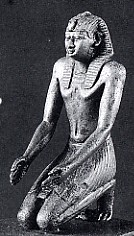
Pharaoh Necho II. of Egypt.
|
|
610 B.C.
Egypt: death of Pharaoh
Psamtik I - successor is his son Necho II
Archeology says: Pharaoh Necho II (610-595 B.C.) tries the
construction of the Suez Canal with many foreign workers.
But the channel stays incomplete. Archaeological remnants
are proved (p.79-80).
610 B.C.
Assyria: Egypt defeat against Babylonia
So, Babylonia can occupy Haran. The Egypt army has to
retreat from Assyria. From Assyria is nothing left (p.311).
609 B.C.
Egypt under Pharaoh Necho II takes the resolution of
another military campaign to Assyria
Necho II wants to help to Assyria in the civil war against
Babylonia and sends another army (p.310-311)
OT claims:
The kingdom of Judah wanted
to block the Egypt army
According to OT there is said that king Josiah with it's mini
army wanted to block the huge army of Egypt and then king
Josiah was killed.
Well, OT claims also some versions in the books of Kings:
-- OT claims that there was an Egypt military campaign against
Assyria reaching the Euphrates
-- king Josiah is said having confronted the Egypt army and is
said having been killed by Necho in Megiddo (2d book of Kings
23,29) (p.311)
OT claims also some versions in the book of Chronicle:
-- Pharaoh Necho II is said having started to Carchemish at
the Euphrates river
-- king Josiah is said having confronted the Egypt army
-- Pharaoh Necho II is said having sent messengers indicating
that Necho II did not want any confrontation with Josiah
-- Josiah is said having stayed stubborn and is said having
provoked a battle in the plain of Megiddo
-- king Josiah is said having been severely wounded by Egypt
shooters and is said having been brought to Jerusalem where he
is said having died (2d book of Chronicle 35,20-24) (p.311).
But there is a logic: king Josiah never can have conducted
war against Egypt
-- king Josiah cannot have started with Samaria and Megiddo
because these territories were not in the mini kingdom of
Judah any more, there should have had annexations of Samaria
and Megiddo, eventual up to Galilee (2d book of Chronicle
34,6) or he could have made an alliance with Babylonia against
Egypt provoking a battle in Megiddo (p.312)
with the little number of 75,000 inhabitants [which
corresponds to the number of the canton of Schaffhausen in
2001] (p.310) king Josiah never had been able to arrange an
army against Egypt, and the whole existence of Judah had been
put into question (p.312).
So, the version of the book of Chronicle with a battle in
Megiddo seems absolutely impossible, and the version of the
books of Kings without indication of a location seems possible
(p.312).
According to Nadav Naaman one possibility would be for example
an oath of loyalty in Megiddo for the new Pharaoh Necho II.
But by some reason the king of Josiah could have been ordered
to be executed, perhaps because of territorial expansions of
Judah in Samaria or in the region of the Shfela (p.312).
According to Bible scholar Baruch Halpern Pharaoh Necho II
also could have ordered the murder of king Josiah because of
his independent religious policy, because by a strong autonomy
the trade routes to Arabia would have been be in danger
(p.312).
[O.k. anybody can speculate here...]
36 Since 609 B.C.:
Nebuchadnezzar devastating Judah - Zedekiah's upheaval
ending in ruin of Jerusalem - Babylonian captivities -
province Yehud
The mini kingdom of "Judah"
is going down
Since the death of Josiah four more kings are following
accompanying the decline of the mini kingdom of Judah
(p.313).
Egypt's expansion in the Mid East
In the time after Josiah's death Egypt has it's last
heyday with severe wars against the Mesopotamian Reichs and
with territorial expansions up to far in the Mid East. The
Pharaohs mean that their dreams would be fulfilled (p.313).
[The borderline of Euphrates river always plays an important
role here as always in the Mid East].
608 B.C.
Mini Reich of Judah under king Jehoahaz
King Jehoahaz seems to be against Egypt (p.313).
OT claims:
-- king Jehoahaz is said having permitted the "sinful"
religious pluralism again
-- Pharaoh Neho II is said having degraded king Jehoahaz
after 3 months already and having him banned (p.313).
608-598 B.C.
Mini kingdom of Judah under king Jehoiakim
OT claims:
-- king Jehoiakim is said having gone on with the "sinful"
religious pluralism
-- king Jehoiakim is said having used taxes of the own
population for tribute payments for Pharaoh Necho II
(p.313).
since 608 B.C. appr.
Prophet Jeremiah going on with propaganda against
"foreign gods"
Jeremiah is said having deplored that the number of the gods
adhered in Judah corresponds allegedly to the numbers of
towns in Judah, and in Jerusalem would be allegedly that
many altars of Baal as is the number of alleys (Jeremiah
11,13) (p.263).
605 B.C.
Babylon's rise under Nebuchadnezzar - Egypt has to
retread to the Nile river
The army of Babylon is winning a battle in the town of
Carchemish in Syria under the prince royal which is known as
Nebuchadnezzar later. The army of Egypt has to retreat back
to the Nile river (p.313).
[Again a big Empire is going down by an overextension of
it's borderlines, and also the Empire of Nebuchadnezzar will
collapse by another overextension of borderlines...]
Now follow destructive military campaigns under
Nebuchadnezzar in the Middle East
The victory in Carchemish is spelling the doom for Assyria
which is without help of Egypt now. Nebuchadnezzar becomes
the king of Babylonia and is heading for a breakthrough to
the Mediterranean [as other Empires did before him]. Now
destructive military campaigns are following one after the
other with the destruction of the Philistine towns (p.314).
In Judah there is a great panic with the discussion on which
side one should stay. The government under king Jehoiakim is
calling Pharaoh Necho II for help, and this action is taken
by Babylonia as a pretext to devastate Judah (p.314).
December 598 - March 597
Death of king Jehoiakim -
king Jeconiah follows
The Babylonian armies are at the border. OT claims that
Jerusalem had been sieged (p.314).
597 B.C.
The mini kingdom of Judah is said having been devastated
- and first "Babylonian captivity" follows
OT claims:
-- Jerusalem had been conquered and devastated by the
Babylonian armies
-- the upper and middle class is said having been deported
-- the royal court with king Jeconiah is said having been
deported to Babel, from the nobles 7,000, from the craftsmen
1,000 persons (2d book of Kings 24,10-16) (p.314)
-- all in all it is said that 10,000 people had been banned
(2d book of Kings 24,14) or 8,000 (2d book of Kings 24,16)
(p.327).
The documents speak
In this case Babylonian chronicle confirms the OT. Add
to this Nebuchadnezzar installs in Judah an own king, the
uncle of Jeconiah, Zedekiah (p.315).
The "1 god movement" with it's priests is deported [and
their influence seems to be banned at the moment]. In Judah
itself the population keeps split (p.315).
596-586 B.C.
Kingdom of Judah: king Zedekiah is trying a conspiracy
against Babylonia
with other local kings (p.315).
[Addition
Nebuchadnezzar is not dependent on the mini Reich of
Judah. That's why this conspiracy of king Zedekiah is a
statal suicide from the first moment on. The reasons are in
the dark for that. Perhaps Zedekiah's government meant that
God will bring another "miracle". Speculations may go on...]
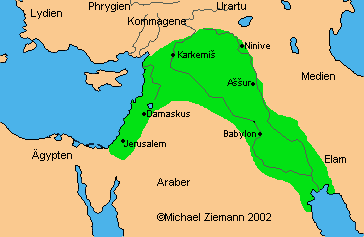 |
Map
of Babylonia under Nebuchadnezzar II at about
590 B.C. reaching from Persian Golf to the
Mediterranean Sea: The breakthrough has
succeeded, Babylonia is governing over the
whole "Fertile Crescent". But Nebuchadnezzar
wants more...
|
And now
punitive expeditions are following:
?
Punitive expedition: Edom is coming first - and also Edom
gets a Babylonian captivity
-- in 6th century B.C. the kingdom of Edom is destroyed by
the troops of Nebuchadnezzar and is depopulated (p.81)
-- only in the central Greek epoch this region is populated
again settling people (p.82).
587 B.C.
Punitive
expeditions and destruction of Jerusalem under
Nebuchadnezzar with the elimination of the town wall
According to Finkelstein / Silberman this military
campaign is "the beginning of the end" (p.315). The mini
kingdom of Judah - already minimized - has about 75,000
inhabitants according to the investigations and excavations,
of these are 15,000 in Jerusalem and another 15,000 around
Jerusalem (p.328).
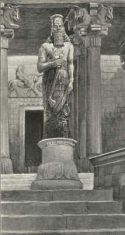
 Nebuchadnezzar, statue
Nebuchadnezzar, statue
|

 Invasion under
Nebuchadnezzar against Judah Invasion under
Nebuchadnezzar against Judah
|

Map of the Empire of Nebuchadnezzar |
Archeology can prove for this time that almost all Judean
towns in all regions of the kingdom have got a layer of
destruction which can be allocated to this destructive
military campaign. Osaka (clay tablets) in the fortification
of Arad for example describes the military orders in an
absolute danger and the transport of food stocks etc. In
Lachish there are messages on osakas how one town after the
other around Lachish is burnt down and how the signals are
extinguished, for example of the town of Aseka (p.315).
According to Jeremiah 34,7 Lachish and Aseka are performing
the longest resistance. At the end only stays Jerusalem that
is sieged up to the destruction (p.315).
Nebuchadnezzar has also the surrounding kingdoms besieged.
The siege of Tyre for example is said having lasted for 10
years [web01].
OT claims:
-- in Jerusalem is said that hunger has broken out, and the
troops of Nebuchadnezzar are said having invaded (p.316)
-- king Zedekiah is said having fled, having seized and
having blinded in Babel (2d book of Kings 25,3-7) (p.316)
-- one month later - under the leadership of Nebusaradan,
the supreme commander of the body guards of Nebuchadnezzars,
now as a military captain for whole Jerusalem - is said
having burnt down whole Jerusalem, having torn down the
whole town wall, and having deported the rest of the
population (2d book of Kings 25,8-11) (p.316). There is no
precise indication in the OT (p.327).
Second Babylonian captivity
- numbers of the deported
Jeremiah is indicating 4,600 deportees for the deportations
to Babylonia (p.327).
According to Finkelstein / Silberman the numbers of
deportees are not precise because in the time of ancient
Greece the number of deportees means the numbers of family
leaders (p.327). By this - according to Finkelstein /
Silberman - it's possible that the maximum is not only
4,600, but about 20,000 deportees are possible (p.328). When
there are admitted 75,000 inhabitants in whole mini kingdom
of Judah, from these 15,000 in Jerusalem and another 15,000
around Jerusalem so there remain 45,000 in the new province
of Yehud (p.328).
Towns of the exile were Babylon, Tel Abib, Susa, Ecbatana,
Persepolis, and Pasargadae [web02].
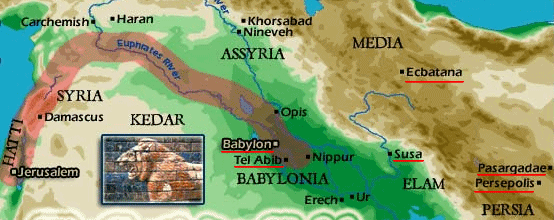
Map with the towns of the Babylonian captivites: Babylon,
Tel Abib, Susa, Ecbatana, Persepolis, and Pasargadae
586 B.C. appr.
The town of Mizpah can survive by peaceful handover - the
flight of the prophet Jeremiah to Mizpah
OT claims:
The territory of the northern region of Jerusalem with the
town of Mizpah is said having been handed over without any
violence (Jeremiah 37,12-13; 38,19) (p.328-329).
Archeology can confirm the handover of the territory of
Mizpah without violence. Excavations of the ruins of Mizpah
at the Tell en-Nasbe near Ramallah [?] under the
archaeologist Oded Lipshits from Tel Aviv university give
the result that Mizpah was not destroyed by the Babylonian
military campaign because a correspondent layer of
destruction is missing (p.329).
According to OT the town of Mizpah under governor Gedaliah -
the son of Ahikam - has become a refuge for other Judeans,
e.g. for the prophet Jeremiah, an enemy of the rebellion
(p.318).
OT claims a theory of punishment by God against Judah
The Old Testament claims that God had organized the self
destruction of the temple which was dedicated to him punishing
the population of Israel for its disloyalty. God is said
having served himself with the enemies of Judah and is said
having been stronger than all other gods (p.21).
Nos Israel is organizing itself as a religious community and
not as a state any more (p.21).
Archeology confirms the destruction of Jerusalem
Archeology can confirm the last moments of violence in
Jerusalem, with arrowheads in the burnt-out ruins (p.316):
-- the mini kingdom of Judah is destroyed and ruined (p.316)
-- the total destruction of Jerusalem by a fire storm can be
proved for this time (p.328).
Now Judah becomes "Yehud"
The new Babylonian province is called "Yehud" now and the
inhabitants are called Yehudim, this is the first time the
population is called "Jews" (p.318).
The sons of the last kings of Zedekiah are all killed (p.316).
[Addition: It seems that the far relatives are not killed,
because the line of David is emerging later again].
37 Since 586 B.C.: first
time of Yehud province - Edomites reducing Yehud
OT claims that Governor
Gedalyah was murdered and there had been a mass
flight to Egypt
OT claims:
-- in the ruins of Jerusalem is said having been performed
further cult actions (Jeremiah 41,5) (p.328)
-- the governor of Mizpah, Gedalyah, is said having aimed
for a collaboration with the new leadership of Babylonia
-- governor Gedalyah and other Judean officials and
representatives of Babylonia are said having been killed by
Ismael, the son of Netanyah (p.318)
according to Finkelstein / Silberman eventually because of
the collaboration which had been felt as a threat for the
"house of David", or by other reasons (p.318)
-- the staying population of Yehud province is said having
taken a mass flight to Egypt by their fear from a new
Babylonian invasion, and in this mass flight is said having
been also Jeremiah (p.318), resp. "all people" is said
having fled to Egypt (p.327)
-- by this the "holy land" is said having been without any
population for some time (2d book of Kings 25,22-26;
Jeremiah 40,7 - 43,7) (p.318-319).
But archeology is telling other things about Yehud
province
-- according to Finkelstein / Silberman Yehud province
consists of about 55,000 inhabitants yet (p.328) and is not
at all completely destroyed as it is described in the OT
(p.329).
[By this the population of Yehud corresponds to that one of
Lugano or Cuxhaven in 2005].
The continuity of the rural
population: The excavation of Bethel and of Gibeon
and later also of southern Jerusalem confirm that the region
was populated without interruption and that there had been
no deportation of the rural population (p.329). The life of
the population is living on in the few preserved towns as
for example the town of Mizpah 12 km in the North of
Jerusalem (p.328).
Policy of autonomy: Babylon introduces a policy of
autonomy tolerating native cults supporting the loyalty of
Babylon (p.330).
Settlement of
Edomites and new "Idumea" in the South: After the
destruction of Jerusalem southern Yehud province is
populated by Edomites settling in the bay of Beersheba and
in the highlands of Hebron. After some time the region is
known as "Idumea", the "land of the Edomites". In fact Yehud
province has become more little yet by this and southern
borderline is moving to the North to Jerusalem (p.334).
What archeology is telling
about Jerusalem
-- in Jerusalem the grave caves from deportees are cared
on by their families (p.328)
-- the suburbs on the hills in western Jerusalem existing at
least since king Hezekiah are stay without population
(p.328)
-- the land in the North and in the South of Jerusalem
always is populated without deportations (p.328)
-- in the preserved town of Mizpah a certain self
administration is going on (p.328-329). Mizpah is the most
important regional center of Yehud province in 6th century
B.C. (p.329).
Egypt: Extension of the Arab population to the Nile Delta
Since the 6th century the Arab population is invading into
the Nile Delta and is taking over the power there in the 5th
century B.C. (p.80).
38 The
events in the Babylonian exile (ban)
Jewish
settlements in captivity in Babylonia - priests of the "1
god movement" - new trials of interpretation of the ruin
of Judah
Old Testament almost completely conceals the life during the
ban. Only allusions can be found in the books of the
prophets:
-- the Jewish banned are said having lived in the capital of
Babylon and in the countryside (report of Ezekiel and
Deuterojesayah in Isaiah chapter 40 to 55)
-- the settlement is said having been in underdeveloped
territories near the new built canals (Ezekiel)
-- Jeremiah is said having consulted the banned to prepare
oneself for a long stay, with construction of houses,
horticulture and founding of families (Jeremiah 29,5-6).
[But this Jeremiah is said having been fled to Egypt...]
The "1 god movement" preaching the false
identity during the ban
In the exile the "1 god movement" is enforcing it's activity
(p.317). According to Finkelstein / Silberman the priests
and the remnant family members of the royal family are
building up a new life, eventually under leadership of the
banned Davidic king Jeconiah and not under the blinded
Zedekiah (p.319).
The priests have the leading role (p.331). The "holy books"
are not a support of the [false] identity [and the fake is
proved] (p.333).
The "1 god movement" feels compulsory to adapt the books of
Moses and of Chronicle to the events and is revising the
texts. At the same time the Israelites in Babylonia and in
Jerusalem are working out new social systems working out new
forms of religious services (p.317).
The invented exodus from Egypt is more and more important
for the banned because the faked exodus is copied to the
situation of the banned in Babylonia (p.333).
According go Finkelstein / Silberman also the faked
migration of the faked patriarch Abraham from the Euphrates
river to Canaan could have won more importance for the
banned. The banned have the same project (p.333).
[The invented migrations are models now for real migrations
that have to be performed whereas the invented history is
fixing itself in the subconsciousness].
Is there a new elite in Yehud province for
Judah?
In the case of Yehud many searchers mean that Babylonia
had educated a loyal elite with the deportees for keeping
safe the borderline to Egypt later (p.330).
[There is a parallel also in this case: Stalin formed of the
German prisoners of war a Communist elite of latter East
Germany (GDR). The members were elected and indoctrinated in
the Gulag concentration camps...]
The compulsion for a new interpretation handling the ruin
of Judah - the second version of the Deuteronomistic
History
The clerks of the "1 god movement" have to revise the books
of Moses and the Deuteronomistic History describing why
Judah did not get any salvation (p.323). After the
destruction of Jerusalem another way for new hopes of
salvation has to be found.
-- the aim of the code of law with the compulsion for
Passover festival does not change (p.324)
-- the events with the second ban have to get a theological
sense for a philosophy of salvation (p.324-325).
By this a second version of the Deuteronomistic History is
prepared (p.324).
560 B.C.
Babylonia: The deported king Jeconiah is released from
prison
OT claims:
King Amel-Marduk from Babylonia is said having been released
from it's jail and is said having given a life long pension
(2d book of Kings 25,27-30) (p.325,326).
539 B.C.
Persia conquering Babylonia
(p.318)
Persian Reich
/ Persian Empire under Cyrus
|
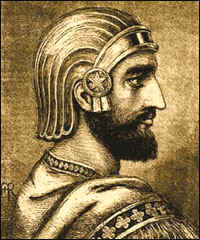
King Cyrus, emperor of Persia, profile
|
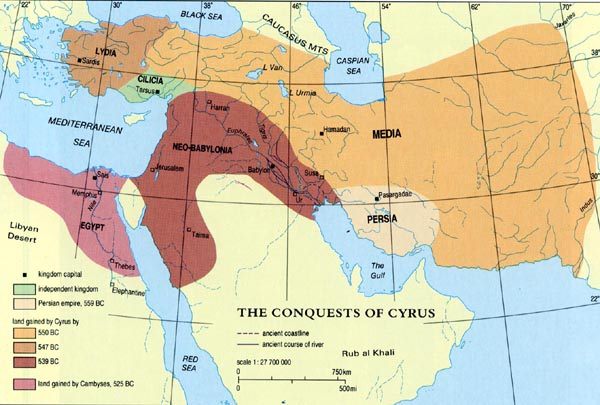
Map with the expansion of Persia under Cyrus. This
is more than only a Fertile Crescent...
|
538 B.C.
Persia: king Cyrus permits the return of the banned Jews
Cyrus decides that the deported Jews can return (p.329). The
decision is a calculated, new policy and not at all a gesture
of mercy (p.330).
OT claims:
-- king Cyrus is said having decided the liberation of all
deported
-- king Cyrus is said having given the permission to reinstall
Judah and to rebuild the temple (book of Ezra 1,2-3) (p.319).
39 Yehud province: new
structure of settlements and the population after coming
back of the banned
The return of the banned and an
alleged new rise of the economy
AT claims:
-- according to the book of Ezra in chapter 2 and in the
book of Nehemiah in chapter 7 almost 50,000 Jews are coming
back from the ban to the Yehud province
-- with this also a new rise of the economy is said having
connected
-- and it's also said that there was a jump of the
population in the highlands with this (p.329).
The new southern borderline
of Yehud because of "Idumea"
By the occupation of the Edomites and the newly founded
territory of "Idumea" the southern border has moved to the
North. The new frontier is between the towns of Bet-Zur and
Hebron now, whereas Hebron is not a part of the Yehud
province any more (p.334).
Yehud province: There is a governor and priesthood - no
king any more
A kingdom is not installed any more (p.331). The province of
Yehud is ruled by governors and priests which are
proclaimed. The temple and the temple community is the new
hot spot for the Jewish identity. There is no royal court
any more. The social position of the priests is rising and
are writing new books, the books of the priests (P) (p.332).
According to Finkelstein / Silberman it's possible that the
invented migration of the faked patriarch of Abraham and the
faked exodus of Egypt were loved topics in the sermons of
the priests [and are loved topics in the Christian churches
until today] (p.334).
What says archeology about the banned and their return?
According to Finkelstein / Silberman the number of 50,000
returning Jews from the Babylonian ban is a wild
exaggeration. The total population in the tiny Yehud
province is about 30,000 during the 5th and 4th century B.C.
This population is building now the identity of later Jewry
(p.329).
[So, Yehud province is as big as the town of Uster (2005) or
a little less big as Gibraltar].
The returnees are settling around Jerusalem. They are
adherents of the "1 god movement", and in sociology and in
politics they are better formed and because of this they are
higher rated than the native population. Tanks of the "holy
books" they have survived the ban and have conserved their
identity to be Jewish (p.331).
[But this identity is very wrong, but they don't want to
change].
Now there is a takeover of power by the returnees:
-- the returning priests are taking over the leading role in
Yehud province (p.331-332) because the relationships to
Babylonia also give political power to the returnees (p.331)
-- and because Babylonia did not settle foreign deportees in
Yehud, so the returnees have the whole power immediately
(p.331).
The alleged new temple and the discrimination of the
population from the ex northern Reich of Israel
OT
claims:
-- two men, Sheshbazzar and Serubbabel are said having
leaded the first group of returnees, and both are said
having become governor of Yehud province (Ezra 5,14;Haggai
1,1) (p.331)
or:
-- under the leadership of Sheshbazzar a first group of
banned is returning to Jerusalem with temple treasuries
which were robbed by Nebuchadnezzar (p.320)
[robbed from a "first temple" which had never existed]
-- Sheshbazzar is said having laid the new base for a new
temple, he is said having been the first "ruler of Judah"
(Ezra 1,8) (p.331)
-- some years later there is said having arrived a second
wave of returnees to Jerusalem under it's leader Jehoshuah,
the son of Jozadaus and of Serubbabel, a grandchild of
Jeconiah (p.320)
-- they are said having built an altar and having celebrated
the Passover Feast of Tabernacles (book of Ezra) (p.320)
-- the population of the ex northern kingdom of Israel is
said having requested Serubbabel to help with the
construction of the temple, but the priests Jehoshuah and
Serubbabel are said having blocked any collaboration (Ezra
4,3) (p.320)
-- the ex banned mean that they would possess a divine
privilege now by the ban that they had suffered, and they
mean having the right to determine the character of the
Jewish "1 god belief" (p.320)
-- then the "folks of the countryside" from the ex northern
kingdom of Israel is said having written a letter to the
king of Babylonia with the claim that the returnees would
reconstruct "the rebellious and evil town again" in Israel,
and the people of the northern kingdom are said having
uttered the prophecy that the town of Jerusalem will refuse
to pay their taxes again and will cause new damage bringing
harm to Persia up to the Euphrates river (Ezra 4,12-16)
(p.320)
-- and by this the king of Babylonia is said having
prohibited all further temple complexes, but Serubbabel and
Jehoshuah are said having continued their works with the
temple (p.320)
-- then the Persian governor is said having inspected
Jerusalem himself and having reported this to the new king
Darius with the request for a royal decision (p.321)
-- king Darius of Persia is said having permitted the
further construction of the temple complex and is said
having assured even the financing and the punishment of the
enemies of the temple when there would be any action against
the temple again (book of Ezra) (p.321).
Documents and archeology about the returnees
Some scientists claim that Sheshbazzar had been Shenazzar (1st
book of chronicle 3,18), a heir of David [remote grade],
perhaps he had even been the son of Jeconiah [then this son
would have spread by a secret relation] (p.331).
But suddenly Serubbabel is not mentioned any more in the OT.
According to Finkelstein / Silberman it could be that
Serubbabel was too powerful in the province of Yehud and by
this was called back [or was eliminated] (p.331).
40 Adaption of "Holy
Book" after the ruin of Judah
Now the theologists of the "1
god theology" have to justify themselves and are writing
their books again
The theological mystic challenge for the "1 god movement" is
tremendous:
-- the prophecy for a big Jewish Empire has not been
fulfilled (p.335)
-- the priests have to justify the destruction of Jerusalem
(p.332)
-- add to this there is the question why the allegedly pious
king Josiah has not succeeded saving Jerusalem (p.325)
-- so, for the ruin of the kingdom of Judah there have to be
invented new theological manipulations because the eternal
hope for a "holy land" has finished now also for Judah
(p.325)
-- the community in Yehud province has to be unified around
the temple
-- the priests have to have a new hope for a better future
-- Yehud province has to arrange their new relationships
with it's neighbors in the North and in the South
-- ant inner problems have to be solved
-- the priests have to find an explanation why a big part of
the allegedly "promised land" is occupied by other
populations (p.332)
-- so, the claims for neighboring land don't stop [and the
enmity against the neighbors is only logic by this]
-- and the priests have to find a new justification why the
books should have a value despite of the disaster with the
destruction of Jerusalem (p.333)
[instead of abrogating them].
So, the priests are writing new completing texts, and these
new completing texts are called the "Priestly Sources" (P).
The new version of the
Pentateuch about the invented Moses and the destroyed
Judah
The literary master work, the folks epos of the end of the
7th century B.C. is revised into a world's book as an anchor
for the world's population (p.12). The 5 books of Moses find
their final version "during the time after the exile" (p.24)
with the definite text (p.332).
Bible scholar Richard Friedman means that Ezra himself had
made the last revision of Pentateuch because he names
himself as "priest and mandatee for the law of God and of
Heaven" (Ezra 7,12) (p.332).
The priests are editing many invented stories adding them to
the Pentateuch (p.335).
The creation of a second
version of the Deuteronomistic History - the whole
population shall be responsible
Writing the new Priestly Sources (P) there are written more
parts of the "holy books":
-- the book of Jeremiah is edited describing the life after
the destruction of Judah (p.317)
-- the book of Ezekiel is edited about the ban and the hopes
in Babylonia
-- the books of Ezra, Nehemiah, Haggai and Zechariah are
edited about the return from the ban (p.317)
-- there is a supplement of the book of Chronicles edited
with the depiction of history since Josiah until the ruin of
the kingdom of Judah by Nebuchadnezzar (p.324) with Josiah's
death
-- there are texts about the last four kings of Jerusalem
edited
-- there texts edited about the destruction of Jerusalem,
about the ban, with the explanation why the destruction of
Jerusalem had been inevitable (p.325) (2d book of Kings
23,26 to 25,21) (p.325).
There are more supplements of another writer:
-- the prophecy which is said having given to David is
completed with a new condition (1st book of Kings 2,4; 8,25;
9,4-9) (p.325)
-- there are indications of a bad prophecy added indicating
a destruction of Jerusalem (e.g. in 2d book of Kings
20,17-18), (p.325)
-- king Manasseh is made responsible for it because since
the destruction of Judah there is a new "measure tape" for
Jerusalem (2d book of Kings, 21,10-15) (p.325)
-- there is a new invention that justice of king of Josiah
had provoked inevitably the destruction of Jerusalem only
delaying the destruction, and there had never been the
promise of a salvation, because the women prophet Hulda is
said having claimed that Jerusalem should be a damn for all
and misery will come over the site, but king Josiah would
not see this any more (2d book of Kings 22,18-20) (p.326)
-- the responsibles for the behavior of God is suddenly not
dependent on the king, but on every inhabitant if Jerusalem
will be destroyed or not: The alliance between the dynasty
of David and God is replaced now by an alliance between the
population and God [see: "book of alliance"] (p.326)
-- the sequestrated king of Jeconiah in Babylonia is said
having been dismissed and having had a good life with king
Amel-Marduk of Babel (2d book of Kings 25,27-30) (p.325,
326)
-- since this moment a new prophecy is given: When the
population is keeping their loyalty to God, so the prophecy
which had been given to David [founding of a kingdom] could
be revived (p.327).
And there is also a new
"book of Chronicle"
The "book of Chronicle" reflects the ideology and the need
of the temple in Jerusalem in the Yehud province, partly
with a revised historical story with the contents of the
books of Kings (p.25).
This new "book of Chronicle" is written in the 5th or 4th
century B.C., some 100 years after the events that are
described. It's a unilateral description in favor of the
historical and political claims of the Davidic dynasty and
of Jerusalem, and the North is hardly mentioned (p.25).
New prophet books of Haggai and Zechariah
According to Finkelstein / Silberman the new prophet books
of Haggai and Zechariah are written in destroyed Judah
(p.328).
And there are texts against
"Idumea" with new geographical indications
The priests don't want to accept the new region of the
Edomites ("Idumea") and don't want to accept the new
borderline of Yehud province in the South which was shifted
to the North. So they begin a new propaganda war against
Edomites:
-- now the priests claim that the patriarchs of Jewry would
be buried in the cave in Hebron provoking that with this
claim there is a mental Jewish occupation of this region
-- and the Israelites are generally presented as more
civilized than all neighboring peoples: So, the origin of
invented patriarch Abraham is said to be in the town of Ur
(Genesis 11,28; 11,31). Ur in these times is the host of
scholarship and indicating the origin of birth in Ur is
rising the reputation (p.334).
Documents speak: Just in the middle of the 6th
century B.C. the town of Ur is revived as a religious center
by the Babylonian or Chaldean king Nabonidus (p.334-335).
The new false identity with
the new faked "holy books"
These "holy books" are simulating to give an identity to the
Jewish population in the tiny Yehud province, and it's
proved that this identity is a fake. The priests are
"unifying" the population by their manipulations and
invented books (p.335).
41 Yehud province with
an alleged new temple - total racism of Orthodox Jews
516 B.C.
OT claims an alleged finishing of a new temple in
Jerusalem
OT claims:
Serubbabel is said having finished the new temple complex
together with priest Jehoshuah 516 B.C., and Serubbabel is
said having his origin from house of David and is said
having awoken new hopes (Haggai 2,20-23) (p.331).
OT claims an alleged "black period" for Jerusalem until
Ezra was coming
until 458 B.C.
OT claims:
Until the arrival of the scholar Ezra - until presumably 458
B.C. - there is said having been a "black period" in
Jerusalem with a religious tolerance of other beliefs of the
neighboring states and with the tolerance of mixed marriages
(p.321).
presumably 458 B.C.
Arrival of the scholar Ezra in Jerusalem - prohibition of
mixed marriages - expulsion of "foreign women" - absolute
racism in Orthodox Jewry
OT claims:
-- Ezra, a member of the family of the high priest Aaron, is
said having come from Persia to Jerusalem
-- Ezra is said having been a loyal man to Moses (Ezra 7,6;
7,10)
-- with Ezra another group of banned is said having been
permitted to return
-- Ezra is said having received the order from king
Artaxerxes to make investigations about Judah and Jerusalem
(p.321)
-- Ezra is said having been financed by Persia and is said
having had also judicial power
-- Ezra is said having stated the wrong kinds of believes
and "atrocities", also mixed marriages and free mix of the
population
-- Ezra is said having united all male returnees of the
alleged tribal territories of Judah and Benjamin before the
temple in Jerusalem, then Ezra is said having reproached
disloyalty to God by mixed marriages with "foreign women"
-- Ezra is said having claimed that the mixed marriages are
said having enhanced the "guilty of Israel"
-- Ezra is said having claimed that the men should expel all
their foreign women, and the listening men are said having
agreed all, and they are said having expelled their foreign
women (p.321).
[This is an absolute Jewish religious racism which is free
to have in the book shops until today and partially is
practices until today yet - but also Muslims and Christians
are partly racist in this kind, it's a horror].
It seems strange that the scholar Ezra never speaks any more
since this speech. There are no documents mentioned with
this by Finkelstein / Silberman (p.321).
445 B.C.
Nehemiah's return to Jerusalem
OT claims:
-- he is said having been a high court official in Persia
and is said having heard of the wrong tolerance in Jerusalem
-- the king of Persia is said having permitted the return
proclaiming him a governor (p.322).
The alleged construction of a new town wall in Jerusalem
under Nehemiah
-- after the arrival in Jerusalem in 445 B.C. Nehemiah is
said having called for the construction of a new town wall
-- the elite in the ex northern kingdom of Israel in Samaria
and Ammon and the Arabs in the South are said having
denounced Nehemiah that he wanted provoke a rebellion by the
construction of the wall, and by this the enemies of the
wall are said having prepared an attack
-- but the wall is said having been finished despite of all
threats (p.322).
The alleged warning for social justice by Nehemiah -
prohibition of mixed marriages
-- Nehemiah is said having blamed the economy of interests
-- Nehemiah is said having claimed for the return of land to
the poor
-- Nehemiah is said having prohibited marriages with foreign
women (p.322)
[and also he is stating a religious racism again].
Orthodoxy in Jewry against mixed marriages
The prescription of the prohibition of mixed marriages is
clearly headed against the neighbor states and is the clear
[racist] base for Jewry (p.322).
[This Jewish marriage law in the Bible is violating any anti
racism law. But selling the Bible is well possible until
today. The same thing is in Islam prohibiting mixed
marriages, until today absolutely legal...]
Ptolemy rule in Yehud province
Yehud province comes under the rule of the Greek
Ptolemies kings governing in Egypt.
(www.jerusalem-schalom.de/vorchristi.htm)
about 300 B.C.
Report of the Greek writer Hecataeus from Abdera about
Jewish law
Hecataeus reports about the Jewish tradition which
has a certain Moses at it's base, with customs of priesthood
and with social law according to Deuteronomy (p.336).
The false prophecy is going on
The myth of Moses with the end of the destruction of
Jerusalem is known now in the whole Mediterranean, with all
the laws and the statehood without king (p.336). There
follow first translations into the Greek language. This
translation is necessary "unifying" the scattered Jews by
the book. Since the dispersal the "holy books" are spreading
the [wrong] Jewish identity world wide (p.336-337). With
this is also spread the hope of a Jewish Empire without
foreigners [without any real sense] (p.337).
198 B.C.
Reign of the Seleucids in Judah
This is a Syrian government [web01].
70 after Christ
Rome: Destruction of the
temple and deportation
A part of the Jews is sold on the Roman slave market.
Another part survives in the diaspora. The books of Moses
and the Deuteronomistic History are becoming a symbol for
the solidarity of the Jews.
European Middle
Ages
Wrong Jerusalem pictures in Europe in the Middle Ages
Jerusalem is painted in Europe with European town walls and
with towers with merlons giving a more powerful impression
of Jerusalem than it really was in fact (p.82).
[Merlons on town walls and fortress walls are an Arab
invention and are present only by Arab occupation since 700
after Christ appr.].
42 New
biblical research since the 17th century
Logic thinking with enlightenment is putting the
Old Testament (Torah) into question
-- logic thinking and rationality are beginning
contradicting to the biblical stories
-- literary and linguistic points of views give clear
definitions which texts don't match together (p.22).
Biblical
research in the 18th century
The archaeologists begin with the registration
of a huge number of inscriptions in hieroglyphic scripts
(p.28).
Since the 1820s: deciphering of hieroglyphic scripts
Since the 1920s the archaeologists are studying
monuments. In the 1920s Jean-François Champollion is
achieving in deciphering the hieroglyphs. Since this point
of time the events described in the Bible can be compared
with the Egypt reports (p.28).
Since the 1840s:
Excavations of towns, palaces and cuneiform scripts
Historians from England, France, the "USA", and from Germany
are excavating towns, huge palaces and archives of cuneiform
scripts of the Assyrian and Babylonian Empires. The towns of
Ninive and Babel mentioned in the Bible are recognized as
aggressive Empires (p.28). IN the cuneiform scripts are
mentioned Israelite kings like Omri, Ahab (p.28) and Jehu,
and also Judean kings like Hezekiah and Manasseh (p.30).
Now the reports of the Bible can be compared from two sides.
It's the first time that exact historical dating is possible
(p.30).
Now are coming the doubts if Moses had existed
Analysts come to the conclusion that the OT has been
written completely by a latter writer (p.22).
The 5 books of Moses are allocated to different writers:
-- texts of "J" come from the Yahwists from Jerusalem with
the name of JHWH as God
-- texts of "E" are from the northern Reich of Israel with
the name of Elohim as God
-- texts of "D" are the texts of the 5th book of Moses which
is stylistically absolutely isolated (p.23)
-- texts of "P" are texts of the priests with reports of the
rites, called "Priestly Sources" (p.23-24)
-- texts of "R" are sentences between the important texts or
explanations of the revisers of the 5 books of Moses (p.24).
All analysts see the Pentateuch as "a mosaic of different
sources" (p.24). ¡
The journeys of the clergyman Edward Robinson: He is the
first identifying old hills of ruins (tell)
In 1838 and 1852 Edward Robinson is making long journeys in
Palestine and states that there are dozens of old hills and
ruins of forgotten biblical sites (p.26-27), "using the
biblical geographic information and comparing it with the
modern Arab location names in the land." (p.27)
Robinson identifies the ruins near ed-Dshib as Gibeon, near
Betin as Bethel, and near Selun as Silo (p.27).
Further
archaeologist research identifies further locations as
Megiddo, Hazor, Lachish etc., in the late 19th century for
example by the British Royal Engineers of the Palestine
Exploration Fund (p.27).
The analysts recognize the conformity of the description
of the country in the Bible with the real landscape
(p.27).
19th century
Detection of a victory inscription of the Moabite king
Mesha
The detection of a victory inscription of the Moabite
king Mesha in eastern Jordan in 19th century brings new
cognitions mentioning a victory against the Israeli
armies. By this a war between Israel and Moab is confirmed
(2d book of Kings 3,4-27) (p.30).
Syria and Jordan having a new nomadism
The Turkish regime is taking high taxes and is threatening
the population been drawn into the Ottoman Reich. This and
other things provoke that many families in villages are
returning to be Bedouins withstock breeding in the desert
where they are kept in tranquility (p.133).
since 1880
Systematic excavations in the Middle East and in Egypt
(p.30)
Since 1880 archaeological research is making great
progresses with new historical dating techniques (p.30).
x
|
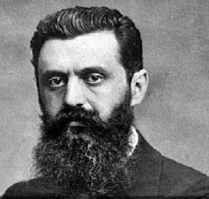
Herzl, portrait of a racist patriarch
against the Arabs
|
[1896
And now Theodor Herzl's
racist book "The Jewish State" is coming
Herzl claims that it would be possible to expel the Arabs
in a simple way like the natives in "America". But since
1915 this plan is not possible any more because the Arab
population is armed in the fight against the Turkish
imperial power. Zionist don't see that change and by their
strong propaganda and collaboration with the Nazi powers
are driving many Jews into the war trap in Middle East].
since 1900 appr.
New technique of historical dating by the "US" scholar
William Albright
-- now there can be systematically stated the ages of
the stiles of architecture, of potsherds and of other
artifacts according to the system of Albright
-- layers of settlements and graves can be historically
dated quite accurately (p.30).
Beginning of the systematic excavations of villages
As a consequence one hill of ruins after another is
excavated (Arabic "tell", Hebrew: "Tel"). In many layers
can be detected the local religious cults of thousands of
years (p.30).
[1933-1945
Emigration wave of Jews from Germany by Nazi Zionist
collaboration, and Holocaust of the Jewish with mass death
in ghettos, by deportations, in camps and in tunnel
constructioning, mass deportations by Stalin to the Gulag
camp system, mass death in the Red Army etc.]
since the 1940s
New biblical
research in the 20th century
Since the 1940s the analysts are naming the
stylistic and theological uniform works of 5th book of
Moses (Deuteronomy) and the books of Joshuah, Judges,
Samuel and Kings as the "Deuteronomistic History" (p.25).
For example the book of Josiah is repeating parts of the
5th book of Moses (Deuteronomy)
-- with the claim that Israel had to be ruled by the ruler
of the whole folk of the Jews elected by God
-- the laws of the Sinai should be followed strictly
-- there is a harsh warning from idolatry (p.108).
The style in the book of Joshua and the style of the 5th
book of Moses is the same, and by this it can be admitted
that it was the same author (p.108).
since 1948
Wars in the Middle East: The Jewish State of Israel is in a
lasting war against the Arab forces because the Arabs don't
let expel oneself that simply as Herzl was announcing it.
the Jewish organizations with JWC a.o. don't see the change
of the situation].
since the 1970s
First critical biblical
archaeologists
First archaeologists are renouncing the connections in the
Bible and are interpreting their findings in an independent
way without Bible, but with social sciences and with
development schemes. The new methods are spreading and by
this there is a new view on the biblical history (p.33).
But many archaeologists are interpreting their findings
according to the biblical context until the 1990s
considering the Bible as a reliant and chronologically
relevant document (p.32-33).
since the 1990s
The new biblical thesis:
The content of the Bible has big contradictions
The historical context of the Bible is obvious, but there
are great contradictions in respect of archaeological
findings and the biblical text (p.32).
Archeology succeeds in filling and explaining the gaps
between the biblical texts and reality by archaeological
findings. Bible itself is coming out as an artifact with
many statements jumping around with indications about
different societies (p.33).
1993
Detection of an inscription with the description of an
Aramean seal against Israel
(p.30)
2001
Jewish Orthodox religious madness
Racist Jewish priests are preaching the racist laws
of the "holy books" until today (p.336).
[According to the "holy laws" any contradiction against a
priest is absolutely forbidden, and officially racism in
religious sermons is rated as a "religious freedom". It's a
horror].
2006
[Zionist government brought to it's senses renouncing an
Empire of Israel
Only in 2006 the Israeli government is renouncing
officially to the wrong prophecy of an Empire of Israel from
the Nile to the Euphrates. But many Jewish groups are going
on with this mad idea in an unreal religious madness in the
sense of the faked Joshua and want the expulsion of the
staying Palestinians, and militant groups of Palestinians
are defensing themselves].
43 Appendix: partition of
the 5 books of Moses in the versions of J, E, D, P, and
R
The variations of the books
of Moses and the writers
Terminology and the geographical hot spots are not the same
in the different books. The versions are written in
different epochs and in different locations. One can detect
the authors by the geographic terminology and by the
function that have the tribes in the text (p.23).
Texts of "J" with JHWH from
Jerusalem
This version (depiction of the tribe of Judah) is using God
consequently as a Tetragrammaton of JHWH (according the
scholars pronounced "Yahweh"). The analysts of the 19th
century name these texts as texts of "J" (p.23).
The Yahwists in Jerusalem describe the perspective of the
southern Reich of Judah, probably in the times of the faked
king of Solomon (970-930 B.C.) or a short time after (p.23).
The version of "J" of the patriarchs above all is a literary
trial of a definition of a unified people of Israel and is
not an exact report (p.58).
The texts of "E" with
Elohim
Another chain of stories is using God with the name of
Elohim of El, above all the description of the tribes in the
North, above all Ephraim, Manasseh and Benjamin. The
analysts of the 19th century name these texts as texts of
"E" (p.23).
The texts of the Elohists in the North are describing the
events of the time of the independence from 930 to 720 B.C.
(p.23).
The texts of "D" of the
Deuteronomy, the 5th book of Moses
The 5th book of Moses ("Deuteronomy") seems to be in a
significant style ans seems to be an independent document
(p.23).
The texts of "P" of the
priests
The rest of the texts are descriptions of rites by the
priests (name "P") as "Priestly Sources", about cults, about
prescriptions of purity and sacrifices (p.23-24). This
source of the priests "P" is dated for the time after the
exile - that mean the majority of the scholars - and also
the definite edition of the Pentateuch is developed after
the exile (p.58).
The "Deuteronomistic History"
Common features of Deuteronomy, books of Joshua, Judges,
Samuel and Kings
The analysts state the the books of Deuteronomy, Joshua,
Judges, Samuel and Kings are in the same linguistic and
theological style. Some times they are redacted. Since the
1940s the analysts are naming these books as "Deuteronomistic History".
The analysts have not the same meaning about the point of
time when the books were written, during the deportation to
Babylon or during the time of king Josiah finished in the
exile locations (p.25).
According to Finkelstein / Silberman the Deuteronomistic
History is composed under the king Josiah (p.26). According
to Finkelstein / Silberman the Deuteronomistic History was
written by one single historian (p.185) [whereas there are
prophecies for centuries building a frame considering that
God is "right"].
Josiah in the Deuteronomistic History: The degradation of
the Omrid Reich
Degrading the Omrid Reich Josiah wants to support his
political ambitions and religious reforms (p.26). Josiah as
a king of Jerusalem means that he had to degrade the kingdom
of the Omrids blaming "sinful behavior". Instead of a
description of the kingdom of the Omrids Josiah is
presenting a faked big Reich under David and Solomon which
is said having been a pure Israeli affair.
There are more faked elements:
-- the siege of Samaria is stressed
-- king Ahab is degraded with the claim he had not murdered
his enemy
-- the palaces in Amaria and Jezreel are said having been
elements of idolatry and injustice
-- Josiah simply does not want a successful northern kingdom
because Jerusalem was only a country side (p.214).
With faked stories about the kings Omri, Ahab and Jezebel
the true history of Israel is systematically concealed and
Jerusalem is put into the center (p.215).
The texts of "R": There are phrases between the texts and
explanations
The Pentateuch is a composed thing, revised and composed by
the editors in a wanted manner whereas alto the editors have
given some "traces" in the books which are classified as
texts of "R":
-- phrases between the texts
-- explanations of the editors (p.24).





map with Israel, Juda, Ammon, Moab, Edom, Philistaia, Araba.
Hill of ruins (tell) of Megiddo




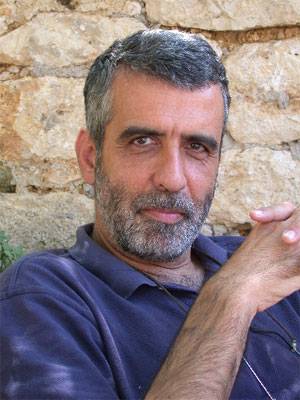

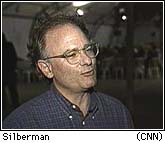

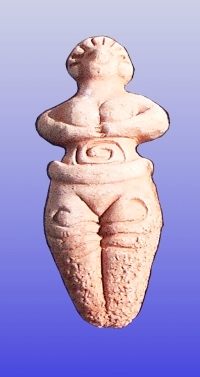
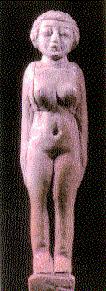
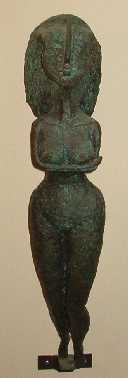
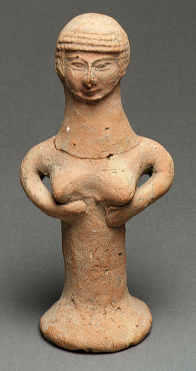
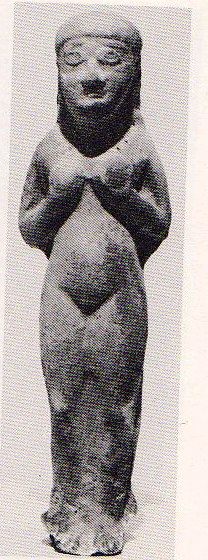
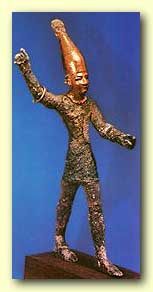

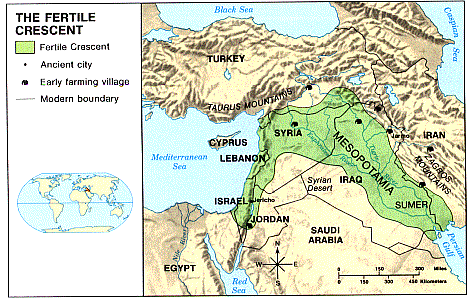


 Tents
of Bedouins in 1915
Tents
of Bedouins in 1915 